

FEBRUARY 2023 FEBRUARY 2023 £3.99 readersdigest.co.uk WIN! 6 INCREDIBLE PRIZES ON OFFER THE FUTURE OF HEALTH • MONEY • TRAVEL • RECIPES • CULTURE • REAL STORIES TECH 5 Predictions That Will Change The World 15 Memories Of An Astrophysicist Superstar BLENDING IN How To Spot The Signs Of Social Masking NEIL DEGRASSE TYSON


Olly Mann declares war on kids' party bags. Are you in?

The elusive Yorkshire actor on Berlin, family life and playing Joy Division's Ian Curtis

The celebrity astrophysicist looks back on growing up in the Bronx, meeting George W Bush and getting his first telescope
From self-driving cars to space travel, here's what to expect
Meet the women with EhlesDanlos Syndrome helping to shape
Are your people-pleasing tendencies a sign of something more serious?
The chilling true-life story of a skier lost in the mountains
One museum director's plight to preserve Ukraine's precious Baroque panels in the face of war
Contents FEBRUARY 2023 FEBRUARY 2023 • 1 14 IT’S
A MANN’S WORLD
ENTERTAINMENT
18 INTERVIEW: SAM RILEY
26
“I REMEMBER”: NEIL DEGRASSE TYSON
HEALTH 34 BENDING BOUNDARIES
others 42 SOCIAL MASKING
the future for
Features INSPIRE 80
THE FUTURE OF TECH
90
OUT OF BOUNDS
TRAVEL 98 SAVING UKRAINE'S ART
cover illustration by Tavis Coburn p98 p26

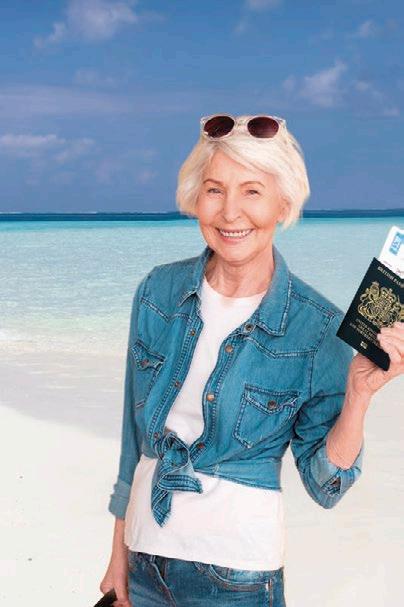

Call us FREE for an instant quote - It’s easy! 0808 196 2118 Friendly UK based team waiting to help you Travel Insurance with No Age Limits! Goodtogoinsurance.com is a trading name of Ancile Insurance Group Limited. Authorised & Regulated by the Financial Conduct Authority - No. 471641. *Discount applies to base premium only and not to any medical screening premiums or optional extras. Discount valid until 30 Jun 2023. 24 Hour Medical Emergency Support Cover for Covid-19 Cover for Cruise Holidays Experts in Cover for Medical Conditions Excellent 20% OFF SPECIAL OFFER FOR READERS DIGEST BASE PREMIUM Quote code read20 *


FEBRUARY 2023 • 3 5 Editor's Letter 6 Over to You 10 See the World Differently HEALTH 50 Advice: Susannah Hickling 56 Column: Dr Max Pemberton 60 Memory: Jonathan Hancock DATING & RELATIONSHIPS 62 Column:
INSPIRE 72 My Britain: Gower Peninsula 78 If I Ruled the World: Tracy-Ann Oberman TRAVEL & ADVENTURE 108 My Great Escape 110 Hidden Gems: Rome MONEY 114 Column: Andy Webb PETS 120 How to cope with pet loss 122 Curious cat habits HOME 126 A brief guide to hardwood floors FOOD & DRINK 130 Cooking by instinct ENTERTAINMENT 134 February's Cultural Highlights BOOKS 138 February Fiction: James Walton’s Recommended Reads 143 Books That Changed My Life: Patrick Gale TECHNOLOGY 144 Column: James O’Malley FUN & GAMES 146 You Couldn’t Make It Up 149 Word Power 152 Brain Teasers 156 Laugh! 159 Beat the Cartoonist 160 Good News In every issue p78 Contents FEBRUARY 2023 p120
Monica Karpinski
EDITOR-IN-CHIEF Eva Mackevic
ASSISTANT EDITOR Ian Chaddock
EDITORIAL ASSISTANT Becca Inglis
JUNIOR EDITOR Alice Gawthrop
ART DIRECTOR Richard Cooke
FINANCE MANAGER Irving Efren
PRINT ADVERTISING Keir McCumiskey
INSERTS & DIGITAL ADVERTISING Jigs Pankhania
COMMERCIAL PARTNERSHIPS Beth Bayliss
MANAGING DIRECTOR Julie Leach
HEAD OF FINANCE Santwana Singh
CHAIRMAN Steve Wilkie
TRUSTED MEDIA BRANDS INC (USA)
President and Chief Executive Officer
Bonnie Kintzer
Editor-in-Chief, International Magazines
Bonnie Munday
WRITE TO US! SEND US YOUR STORIES, JOKES AND LETTERS OR VISIT OUR WEBSITE
For all subscriber enquiries, please use the customer services number below
WE PAY...
£50 for the star letter and £30 for regular letters. Email readersletters@readers digest.co.uk or go to readers digest.co.uk/contact-us
WE ALSO PAY...
£30 for the true stories, anecdotes, jokes in Laugh! and You Couldn’t Make It Up…, and contributions to end-ofarticle fillers and My Great Escape Email excerpts@readersdigest.co.uk or go to readersdigest.co.uk/contact-us
SORRY!
We cannot acknowledge or return unpublished items or unsolicited article-length manuscripts. Do not send SAEs. Article-length stories, poetry and cartoons are not requested.

CUSTOMER SERVICES
Contact Customer Services for renewals, gifts, address changes, payments, account information and all other enquiries. Call 0330 333 2220* or email customer_service@readersdigest.co.uk
TALKING MAGAZINES
Reader’s Digest is also available in audio and accessible etext editions from RNIB Newsagent, for blind and partially sighted readers. Call the RNIB Helpline on 0303 123 9999 or visit rnib.org.uk/newsagent
SUBSCRIPTIONS
Annual subscriptions are available to be delivered monthly direct to your door. For our latest offers please visit readersdigest.co.uk/subscribe Or telephone us today on 01778 392461. Gift subscriptions also available. UK rates may vary. Overseas rates: Republic of Ireland £45, Europe £50 and Rest of the World £60 for 12 month subscription.
SMALL PRINT: Ensure submissions are not previously published. Include your name, email, address and daytime phone number with all correspondence. We may edit letters and use them in all print and electronic media. Contributions used become world copyright of Vivat Direct Ltd (t/a Reader’s Digest). Reader’s Digest is a member of the Independent Press Standards Organisation (which regulates the UK’s magazine and newspaper industry). We abide by the Editors’ Code of Practice and are committed to upholding the highest standards of journalism. If you think that we have not met those standards, please contact 0203 795 8886. If we are unable to resolve your complaint, or if you would like more information about IPSO or the Editors’ Code, contact IPSO on 0300 123 2220 or visit ipso.co.uk
PAPER FROM SUSTAINABLE FORESTS. PLEASE RECYCLE © 2017 Vivat Direct Ltd (t/a Reader’s Digest). British Reader’s Digest is published by Vivat Direct Ltd. All rights reserved throughout the world. Reproduction in any manner, in whole or part, in English or other languages, is prohibited. Reader’s Digest is a trademark owned and under license from Trusted Media Brands, Inc, and is registered with the United States Patent and Trademark Office. All rights reserved. Printed by Warners Midlands PLC. Newstrade distribution by Seymour Distribution Limited.
than
rate
number
free
type
line
mobile, BT
other fixed line
*Calls to 03 numbers cost no more
a national
call to an 01 or 02
and will be
if you have inclusive minutes from any
of
including
or
True You To
We all put on a bit of an act sometimes. Whether it’s to avoid an argument with a family member, impress the boss, or just get out of a sticky situation—being your “authentic self” at all times is not always easy. The occasional camouflaging of our natural personality is a survival instinct driven by the need to fit in. But when does it become unhealthy? Could your social masking behaviour be taking a toll on your mental wellbeing and sense of self-worth? On p42, Victoria Stokes speaks to experts on this fascinating phenomenon and examines its links to autism.
Identity crisis is something Sam Riley knows a thing or two about, as you will learn from our interview on p18. The British actor who found fame after portraying the late Joy Division frontman Ian Curtis in Control, opens up about coming to terms with some of his “less attractive” personality traits, battling substance abuse, and how actors have a tendency to hide their true feelings behind their craft.
eva mackevic Editor-in-Chief


Follow Us

You can also sign up to our newsletter at readersdigest.co.uk Reader’sDigestis published in 23 editions in 10 languages facebook.com/readersdigestuk twitter.com/readersdigestuk @readersdigest_uk
FEBRUARY 2023 • 5 Eva EDITOR’S LETTER
Over To You
LETTERS ON THE December ISSUE
We pay £50 for Letter of the Month and £30 for all others
LETTER OF THE MONTH
NEW TRADITION
I took great comfort from Dr Max’s “Breaking with Christmas Tradition” article.
With my family spread over different counties, choosing a central location to meet for pre-Christmas dinner made good sense. For many years, I drove my mother to the venue and we spent a wonderful afternoon sharing a special time with my two siblings and their families. It became a Christmas tradition.
Sadly, both my mother and sister passed away in 2019, and our family had lost two vital anchors.
I desperately tried to cling to the past, wanting to keep some sense of normality. After one painful Christmas meal, where my eyes constantly wandered to the spots where my loved ones


would have sat, we called it a day. A link to the past had been lost. Dr Max explained traditions were invented by our ancestors and we’re free to create new ideas. Therefore, my family will meet in January this time—when there’s less pressure on finances and time. No, it won’t be the same as our traditional Christmas dinner—but it fits our family’s needs today. Best of all, we have something special to look forward to, after the tinsel comes down.
JULIE BRETT, Sussex
6 • FEBRUARY 2023 Send letters to readersletters@readersdigest.co.uk Include your full name, address, email and daytime phone number. We may edit letters and use them in all print and electronic media WE WANT TO HEAR FROM YOU! DECEMBER 2022 53 52 DECEMBER 2022 HEALTH operates on two levels. Firstly, there is the level of tradition; the rituals and objects we associate with it. Psychologically, we hold on to these because they root us historically and give us meaning. They develop and are incorporated into our internal world as a way of defending ourselves from the chaos of the world outside. Turkey, carols, Christmas trees and so on are comforting, familiar objects, and are often seen as an important aspect of Christmas. It’s interesting that so many of these traditions, which we like to think of as being as old as the hills, actually only go back a few generations. Go back a few hundred years and the Christmas traditions would be very different to the ones we hold now. But traditions are important because they bring us together in a shared sense of belonging. We are social animals, and we need to feel connected to one another. We create a mythology around key events like Christmas in order to give us a sense of shared, common ancestry, even though this is in itself often a myth. Of course on the second and deeper level, the Christmas story is one of celebration and love. Tradition may be useful psychologically, but ultimately it’s fragile and finite. A Christmas based solely on traditions will soon lose its meaning because tradition is easily invented and just as easily destroyed. The real meaning of Christmas is love, not donkeys or baubles. I’m a great believer in the power of tradition and ritual, but knowing that most of our traditions were invented by our ancestors can be quite liberating, as it means that we too are free to create our own traditions to tie us together. is is something often discuss with my patients and encourage them to try themselves. As families become increasingly fragmented and atomised, I think realising that you can create your own family traditions, and doing so consciously, can help to bring people together and forge a sense of unity. Right up until she died earlier this year, Sister Mary Stephen would send me a Christmas card with a donkey on it every year and I would do the same for her. It had become quite a tradition. n “What? You can’t be serious?” I shouted in disbelief. “What do you mean there wasn’t a donkey?” Clearly this nun had gone mad. She smiled angelically at me and persevered. “Most scholars agree that given Mary and Joseph’s social and economic position, it’s unlikely that they would ever have travelled on a donkey. And of course there’s no scriptural evidence to support the idea that there was a donkey.” Evidence? She wants evidence? “But what about the Christmas carol ‘Little Donkey’?” I asked triumphantly. “What about all those Christmas cards with the donkey on? Everyone knows there was a donkey. How else did they get from Nazareth to Bethlehem?” Breaking With Christmas Tradition Max is a hospital doctor, author and columnist. He currently works full time in mental health for the NHS. His new book, The MarvellousAdventureof BeingHuman is out now “They walked or possibly hitched a ride on a wagon,” she offered, rather prosaically. Huh. What does a nun know about the Bible? I immediately started scouring the Gospels of Matthew and Luke. There must be a donkey here somewhere. Nope, nothing. double checked. No, not even a whiff. recoiled in horror. My world had collapsed. was 16 at the time, studying scripture for my A-Levels, and the nun who had broken this earthshattering news was my teacher. I looked at Sister Mary Stephen in her habit, gently shaking her head at me. “It doesn’t matter that there wasn’t a donkey,” she said calmly. Going to a co-ed convent, I wanted to take the opportunity to learn about one of the most important books ever written from someone who had dedicated her life to it: a nun. So, along with my science A-levels, I took religious education. Regardless of your religious conviction, the Bible is a fascinating historical document, but when it came to the Christmas story, instead of being the voice of reason, the man of rational science, it was I who held on to the traditions and unfounded beliefs, and Sister Mary Stephen who challenged me. The truth is, of course, Sister Mary Stephen didn’t need the donkey, because she knew what the Christmas story was really about. The “meaning” of Christmas, which is so often talked about at this time of year, Dr Max muses on the true spirit of Christmas when a steadfast festive belief is questioned
Money Matters
“Savings” used to be a foreign word to me, until COVID struck and I stayed in more. I realised I actually could save, and even now I am more frugal and manage to put a little away each month.
Your article “Savings: On the Money Special” was therefore extremely helpful. I feel more confident about finding the best rates, choosing the right type of account, calculating tax and learning how to open and manage my account. I feel happier knowing saving offers the security of being ready for a rainy day, making a savings account ideal for short-term goals or unexpected bills.
I am grateful for all the information provided in this article. I’m finally joining the world of “savers”!
KENDRA SEVILLE, Merseyside


Inquisitive Walruses
I very much enjoyed Joseph Phelan’s article about two intrepid photographers braving frigid conditions (and not inconsiderable personal danger) to capture the magic of Greenland’s landscapes and abundant wildlife. I hope one day to see it all for myself, although maybe not at such close quarters as they did. The prospect of being afloat in a fragile kayak with a massive and inquisitive walrus uncomfortably close by is indeed a daunting one.
The work of Magnus Elander and Thrainn Kolbeinsson cannot fail to contribute in a very positive way to the mounting concern about loss of habitat through climate change.
MAGGIE COBBETT, Yorkshire
FEBRUARY 2023 • 7 READER’S DIGEST
Layers And Stews
As it is my least favourite time of year, I read with interest “Winter Ways: Top Tips on Staying Warmer In Colder Months”.
It’s a standing joke in our house that my husband doesn’t like to turn the heating on and will usually tell our daughter to “put another jumper on”! Your advice to love layers and heat carefully is something we already do. I also enjoy my breakfast porridge and we have plenty of stews, so we warm from the inside out.
However, I must confess to not following the tip that recommends doing the housework to keep warm. I’d far rather curl up in my layers and a blanket and read a book than wield the hoover and duster!
MELANIE LODGE, Yorkshire

Opposites Attract
Your article “Should We Remove Age-Range Filters From Dating Apps” struck a chord with me. I think we should.
Bumble and Tinder offer their services generally to ages between 18 and 55, and I guess its best age range is for the mid-twenties. Dating filters don’t work at the best of times, even if they have the cordiality to try.
People’s preferences also aren’t that important. I dive, abseil, canoe, swim, go to the gym, play football and golf. My wife does none of those things—she has other sports she likes. I read lots of books, she will read one or two a year. Opposites sometimes attract and dating apps don’t cater for that scenario.
JACK WEBB, Wales
OVER TO YOU
POETRY CORNER
WOMEN’S INSTITUTE
The Women’s Institute, what a fabulous bunch of ladies they are, organising events and activities both near and far.
A true British establishment that makes us so proud, we want to stand tall and shout about its virtues out loud.
Lots of fun, laughter and many friendships are enjoyed, cups of tea and biscuits keep the flagging spirits buoyed.
Baking cakes, bric-a-brac sales, just a few of their endeavours, bringing people together to enjoy life’s little pleasures.
Passionate and driven for a shared worthy cause, they deserve our support and endless applause.
So, to all the very special WI ladies, a big thank you, let’s raise a glass for all the great work that they do.
JANE ROBINSON, Hartlepool
Swimming
On a bleak wet Tuesday morning he closes his eyes and remembers stepping into the ocean at Dawlish Warren then screaming with the cold where they heard all the way in Exeter city and yet invigorating all the same, the sea seemingly calling his name.
It was a warm spring day as he swam out of his depth a little fear mixing with elation, figures on the shore small as ants. Yes, he remembers that special day rolling over the swell and feeling free truly alive...in the indifferent sea.
GUY FLETCHER, Cardiff
Want to see your poem published in Reader’s Digest?
Whether you’re a seasoned poet or just getting started, we’d love to see your work! Email us at readersletters@readersdigest.co.uk. Include your full name, address and the title of the poem. We’ll pay £30 for every published piece
FEBRUARY 2023 • 9
READER’S DIGEST

photo: © AF p vi A Getty i m AG es/J e FF p AC ho UD 10
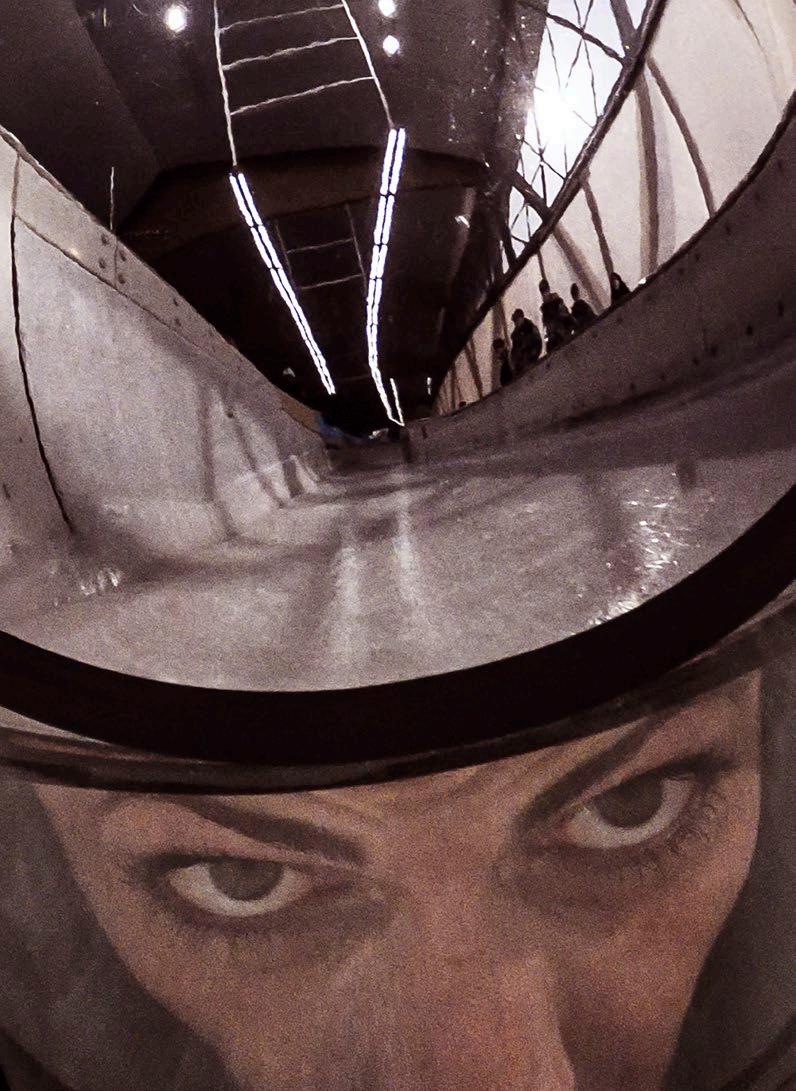
turn the page
SEE THE WORLD...
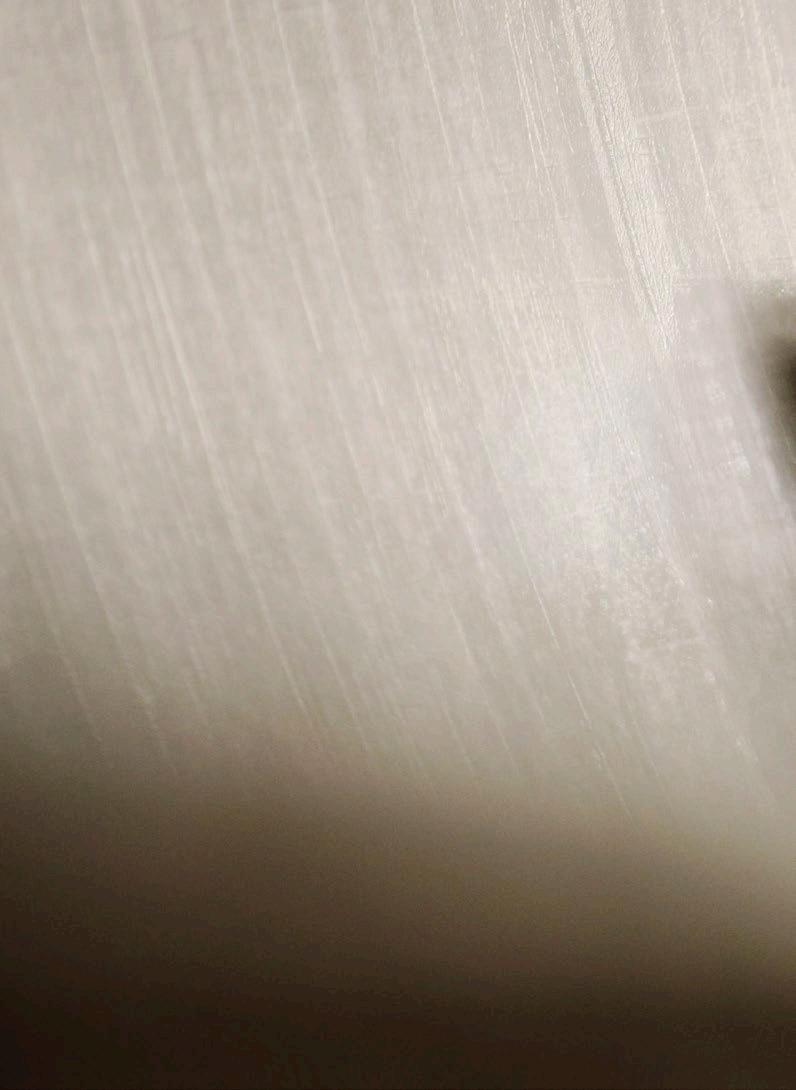
…DIFFERENTLY
This sport requires courage! After all, skeleton riders hurtle down an ice channel head first while lying on their bellies. The sport owes its somewhat macabre name to the sleds used. These consist largely of a metal frame reminiscent of a skeleton. On their slide, which can reach speeds of up to 145km per hour, athletes like Austrian Janine Flock—shown here at the 2022 Winter Olympics in Beijing—steer by shifting pressure with their legs and shoulders.

photo: © Getty i m AG es/A DA m p retty 13

Over The PartyBags Are
Olly Mann takes issue with party bags for kids' birthdays, and he's not backing down

Olly Mann presents Four Thought for BBC Radio 4, and the podcasts The Modern Mann, The Week Unwrapped and The Retrospectors
My son’s seventh birthday is fast approaching, so conversation at my gaff has naturally turned to organising his party. For his first five birthdays, we hosted at home, repeating the same well-rehearsed formula: close family and friends, Costco cake, plastic tablecloth featuring whatever superhero he was into at the time, one of those tin-foiled cheese-and-pineapple hedgehog things, beers for the grown-ups. It was great.
But then, he got old enough to have an opinion about the guest list and venue. So, for his sixth birthday, we upped the ante and booked the local trampoline park. This worked out well, because his friends knackered themselves out from jumping, and therefore didn’t notice how rank the pizza was; and we chaperons could hang out on the viewing gallery, ordering cappuccinos, catching up with gossip, and doing our darnedest to filter out the piercing shrieks of the leaping six-yearolds beneath us. But the whole event cost us hundreds of pounds.
illustration by Lauren Rebbeck FEBRUARY 2023 • 15
This year, I’m trying to convince him that the dinosaur-themed softplay down the road offers just as much opportunity for screaming and bouncing—and you don’t even need to wear special socks! If I succeed, this will be cheaper, because we aren’t required to hire a space—we can simply buy tickets for his mates, send out electronic invites, and bring our own food to the picnic area.
But I can already feel a confrontation brewing about one of the finer details: the party bags. I refuse to provide party bags. This is a red line for me; a Hard No. It’s not especially about the cost—though splurging wodges of cash on trinkets does rankle me, too—but simply about the principle.
Why should a bunch of sevenyear-olds, who have already been treated to a day out, a mountain of sugar, laser lights, a million slides, ball ponds, Diplodocus-shaped rubbish bins, day-glo cheeseburgers, ear-splitting auto-tuned music and the opportunity to charge headlong into their schoolfriends at enormous velocity, also be handed a bag full of pound-shop c**p for simply bothering to show up?
It's not Elton John’s Oscars party, not even close. It’s a 10am gathering of kids and parents at a climbing frame. The guests are not supposed to be hoarding goodies: they are coming to commemorate my son’s birth, skip about a bit, intake calories
and go home, preferably without having made the world a worse place in the process.
But party bags are environmentally catastrophic. I reckon my son attends 20 parties per year, and at each party there are 20 kids in attendance. That’s 400 plastic bags, straight off the bat; all too small to be meaningfully recycled or reused, all destined for landfill within a week. Within these 400 bags are perhaps 800 plastic toys, almost all of which fall apart on the journey home and then get binned instantly: football whistles that don’t whistle, spinning tops that don’t spin, push-along trains that don’t push along. The waste is appalling, and I don’t want to be part of it.
I know there are some eco-friendly party bag alternatives: one couple I know covered a table with Mr Men books and got the kids to choose one each. At another party, I saw the hosts fill a bucket with soft toys and crumpled newspaper, and do a lucky dip. Laudable efforts. But these solutions pander to the proposition that children should somehow be rewarded for deigning to be entertained in the first place. No, absolutely not!
Then there’s the obligatory bit of extra cake and bag of Haribo. More money, more plastic, but also more sugar: not exactly a gift for the parents, is it? I’ve been that Dad— picking up my son after a party, then spending the car journey home
16 • FEBRUARY 2023 IT’S A MANN’S WORLD
explaining to him that (as he’s already psyched-up to the max on Coke, chips and airguns) eating yet more sweets right now might not be the best idea. It's all accompanied by the soundtrack of that single-use whistle being blown forcefully in my ears, before, inevitably, it disintegrates, causing more crisis. It’s hell. Why would I force that experience on to other people?
Even if the contents don’t fall apart, and even if the recipients do cherish their souvenir, so what? Will our guests think more highly of our child because their prized party bag came from our party? And even if they do, what then? What would it say about my ego, and how poorly I
rank my child’s ability to make and keep friends, that I’d consider this to be important?
Oh, and in case you doubt my consistency: yes, I do feel the same about wedding favours, keepsakes from Christenings/Bar Mitzvahs, and—especially—about sugared almonds. No one likes sugared almonds, which is why the only time you see them is when they’re tied up in stupid string bags at a table-setting. They, too, are a racket to rinse foolish people to pay too much for add-ons at events they’re hosting because they’re following "tradition".
Well, the tradition for kids' party bags ends with me, and it ends here, and it ends now. Who’s with me? n
Difficulty Bathing?

Not with our walk-in, lie down bath.


The Simplicity Bath from Nationwide Mobility. Cleverly designed to make stepping in and out so much easier and safer too!
• Fits in same space as your old bath
• Door available on either the left or right hand side of the bath
• Back-up safety battery in case of power cuts
• Safe low threshold

• Strong reinforced bath shell on a robust steel frame SALE UP TO 20% OFF* JANUARY









FEBRUARY 2023 • 17 READER’S DIGEST
FOR A FREE COLOUR BROCHURE CALL NOW 0800 316 9798 OR VISIT WWW.NATIONWIDE-MOBILITY.CO.UK Ext. 64946 16 FITTED IN A DAY!** *Not in conjunction with any other offer. **Based on a straightforward fitting.
Sam Riley On Control, Cornwall And Keeping His Privacy
Simon Button talks to the Yorkshire actor about playing Joy Division frontman Ian Curtis, filming She Is Love on the south coast, and living a family life in Berlin
Sam Riley is happy that the public doesn’t know much about his personal life beyond the fact that he lives in Berlin, is married to Romanian-German actress Alexandra Maria Lara and that they have a young son named Ben.
“My wife is a very well-known actor in Germany but they don’t have the same culture of scrutiny,” says the West Yorkshire-born actor, who met Alexandra when she played a journalist in his screen debut Control in 2007. “Fame is not something either of us has courted because it’s a double-edged sword. There are a lot of good actors who are successful
but who you don’t know very much about at all.”
Sam smiles, seemingly forgetting the blockbuster success of the two Maleficent films he has appeared in. “Plus I’ve never really been in anything that millions of people have seen.”
The small, independent drama She Is Love is more typical of his CV, although it pushed him far beyond his comfort zone. It was largely improvised. “It gave me the fear,” he admits. “I’d never done anything like it and just before filming started, I started panicking because I realised I’d have to use an awful lot of myself. You’re always using something
ENTERTAINMENT AFF / ALAMY STOCK PHOTO 18 • FEBRUARY 2023

19
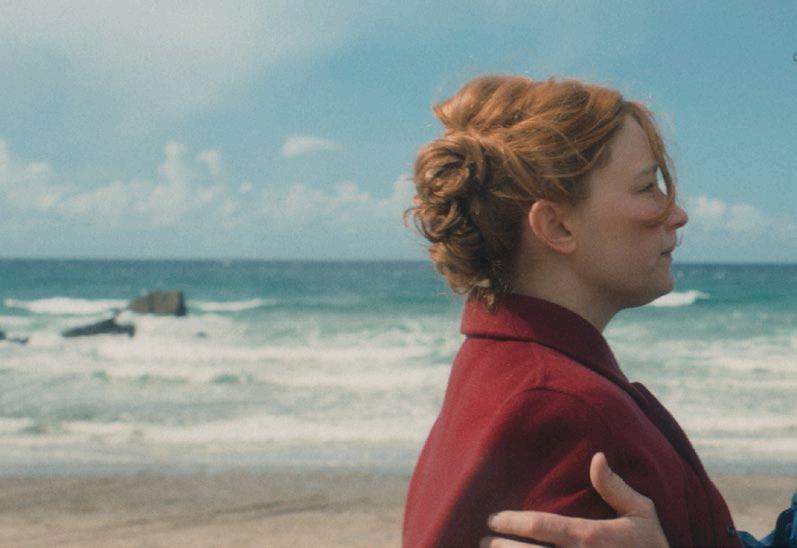
of yourself as an actor, but you’re usually hiding behind the dialogue.”
In the film, which was directed by Jamie Adams, Sam plays a musician and hotelier in Cornwall whose relationship with his girlfriend Louise (Marisa Abela) is disrupted by the arrival of his ex-wife Patricia (Haley Bennett).
A sometime musician himself, Riley notes: “I realised Jamie had based it on a version of me. There wasn’t really a character there, just the fact Idris was a musician. The first thing I had to do was dance like an idiot behind mixing desks in front of complete strangers and I thought, I’m just going to have to completely give in to this and try not to be vain.”
Did he learn anything about himself in the process? “No, because the older I get the more realistic I am about myself. I’m quite aware of where my frailties or less attractive qualities are. But Idris is a bit of a coward emotionally, which I hope I’m not—although I do think a lot of actors use the job as a means of expressing things that they’re incapable of expressing in real life.”
Zooming in from France, where he’s currently filming Clicquot (again opposite Haley Bennett), 42-year-old Sam says he feels renewed as an actor. Having also recently completed historic drama Firebrand , in which he plays
20 • FEBRUARY 2023
Haley Bennett and Riley in She Is Love
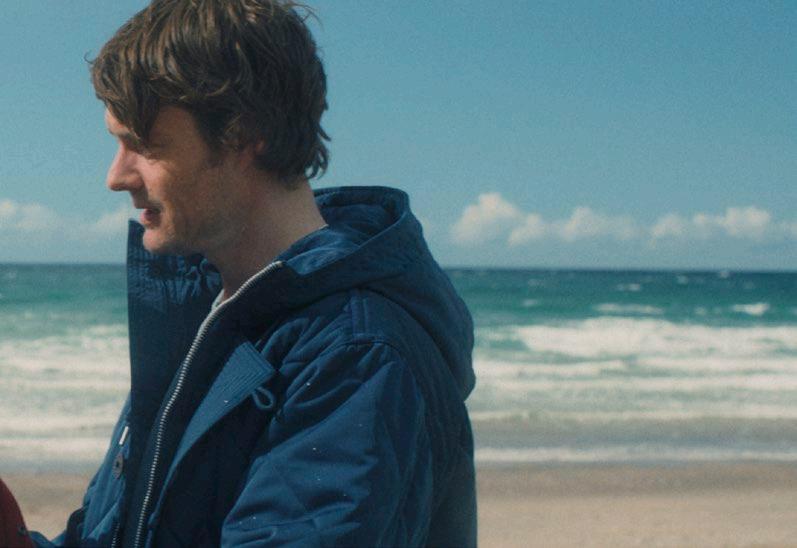
Thomas Seymour, he acknowledges that She Is Love ’s six-day shoot gave him a real confidence boost. “It was an exercise in trying to be fearless and testing yourself. In the jobs that I’ve done since I’ve noticed that, I feel more flexible somehow, more relaxed and open to the risk of just making a fool of myself.”
The film Clicquot is all about the founding of one of the world’s most iconic champagne brands, however, Riley isn’t touching a drop during filming. He gave up drinking five years ago, but was champagne his alcohol tipple of choice? “It never really bothered me what I was putting in myself,” he confesses, “which was part of the problem.”
Riley has lived in Berlin for nearly 15 years. When COVID struck, Alexandra worked as much as possible, while he stayed home to look after Ben. He eventually agreed to make She Is Love because of the short shooting schedule, spending ten days self-isolating with director Adams before the cameras rolled and, smiling, he explains: “We spent more time in quarantine together than we did making the film.”
The son of a textile agent and a nursery school teacher, Sam grew up in Bradford and attended public school in Uppingham, Rutland. He got into acting through school plays, recalling: “I was told I was good at
FEBRUARY 2023 • 21

22 EVERETT COLLECTION INC / ALAMY STOCK PHOTO
Sam Riley as Ian Curtis
it by teachers and I wasn’t told that about anything else, so that made it appealing,” he laughs before adding: “As did the applause.”
Sam joined the National Youth Theatre when he was 17. He landed an agent a couple of years later and had what he calls “a serious go at auditioning with little to no success”. He did, however, get an audition for Coronation Street but, as an aspiring musician as well as an actor, he worried about committing to the soap, thinking, If I get this I can never be a credible musician. He also fretted about taking on a longterm role on TV. “I thought maybe it would mean that that was as far as
Control. Director Anton Corbijn was impressed and, released in 2007, the stunning film established Riley as a bright new talent.
It also earned him a raft of awards and nominations and made a splash when it premiered at the Cannes Film Festival, with Alexandra pointing out to Sam what a big deal it was. “It felt like we were doing something special but I had no frame of reference, whereas she had been in the business a lot longer. When we were in Cannes I saw the poster of me with a cigarette hanging from my mouth and thought, That’s pretty cool. Then we were at a roof party, the press screening had gone really
“IT FELT LIKE WE WERE DOING SOMETHING SPECIAL BUT I HAD NO FRAME OF REFERENCE”
I could go as an actor, so I rang my agent and quit.”
Sam’s band 10,000 Things had been signed to a three-year deal since 2002 but, having failed to trouble the charts, broke up in 2005. He worked in pubs, bars and a retail warehouse. “After a while I realised I’d rather be in any soap opera or commercial that was going, so I rang up my agent again.”
His timing couldn’t have been more fortuitous. The following week there were open auditions for the role of late Joy Division singer Ian Curtis in
well and she said to me, ‘Enjoy this because it just doesn’t happen’.”
He could have cashed in on the buzz surrounding his acclaimed performance. “But to some extent I resisted where the film might have taken me, in terms of Hollywood and things like that. I went there and nearly did a couple of big things, which then didn’t happen. It made me anxious and I thought, I want to use this opportunity to work, to keep getting jobs, while ignoring the strategies that were laid out before me by my agent. I just did things that interested me.”
FEBRUARY 2023 • 23
READER’S DIGEST
Maria Lara and Riley
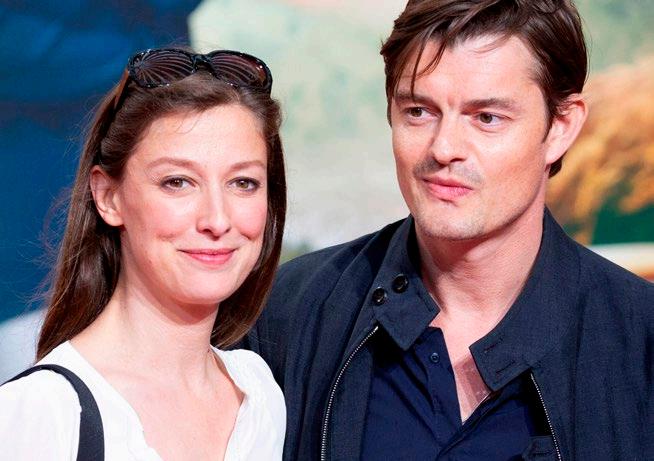
The things that interested him included a remake of Brighton Rock, Pride and Prejudice and Zombies and two films in the Maleficent franchise. He also did some modelling, most notably for Burberry’s 2008 Autumn/ Winter campaign, saying now: “I turned up at Hyde Park, wore these incredible coats with Rosie Huntington-Whiteley on my arm and it was about four hours’ work for a lot of money. It helped me be able to say no to stuff and wait for something that I really wanted to do.”
She Is Love was a tough shoot, as Idris and Patricia reconnect during drinking sessions, card games and impromptu songwriting. The cameras were rolling for up to six
hours a day. “And no-one wants to hear an actor say that his job is exhausting, but you were drained by the end of it.”
He enjoyed spending time on the Cornish coast but was happy to get back to the family in Berlin, so I ask what he likes about life in the German capital. “People always assume it’s the nightclubs but I’ve never been to most of them. It’s about being with the family, walking through the forests which border Berlin or going to some of the cafés or restaurants. An ideal day for me is pretty dull.” n
She Is Love is in cinemas and on digital platforms from February 3, 2023
24 • FEBRUARY 2023
INTERVIEW: SAM RILEY
TCD/PROD.DB / ALAMY STOCK PHOTO GEISLER-FOTOPRESS GMBH / ALAMY STOCK PHOTO
Alexandra

25
Riley in Maleficent with Angelina Jolie
Neil deGrasse Tyson I REMEMBER…

Neil deGrasse Tyson (64) is one of the world’s most eminent astrophysicists. As he publishes his latest book, he looks back at growing up in the Bronx, witnessing the 9/11 attacks on the World Trade Centre and interviewing Katy Perry
26 ERIK PENDZICH/SHUTTERSTOCK

ENTERTAINMENT

MY EARLIEST CHILDHOOD MEMORY IS WATCHING THE MICKEY MOUSE CLUB on the lower level of a bunk bed with my brother and mother. I would have been nearly four at the time and I vividly recall it was a Sunday evening and Mum was pregnant with my sister. At first we lived in the Castle Hill
• FEBRUARY 2023
middle-income housing project in the Bronx and it felt like a real community, with playgrounds and playing fields amid all the buildings.
WHEN MY FATHER’S INCOME INCREASED WE MOVED TO RIVERDALE, which was a more plush part of the Bronx and,
28 I REMEMBER
prophetically perhaps, our building was called Skyview. One day I came home and there were people protesting against Black families moving in. That was in 1964, when I was six years old, and that seemed so odd to me. I thought, Why do people feel this way? because when you’re a kid you can’t process complex issues, you just observe things.
MY FATHER WORKED FOR THE NEW YORK CITY MAYOR’S OFFICE under Mayor Lindsay and he became a commissioner for the manpower and career development agency, which was very much plugged into the Civil Rights Movement. Keeping New York a liveable and safe place that was free from unrest was a heroic effort at a very difficult time. There were severe riots related to equal rights and the assassinations of Martin Luther King and Malcom X. Although New York had a few dustups, my dad helped keep the city calm in the face of disturbances of the peace.
MY MOTHER WAS A STAY-ATHOME-MUM TO ME AND MY SIBLINGS until the nest was mostly empty, then she went back to school. She was very much interested in the plight of the elderly, got a degree in gerontology and worked for the health and human services, which looks after the overall health of the country and includes programmes
for the elderly. We had many ageing relatives at the time so it wasn’t a baptism for her; it was a continuation of things she’d been doing all along.
IN 1970 WE MOVED TO MASSACHUSETTS when my father was invited to become a fellow at the Kennedy Institute of Politics at Harvard. We were only there for a year but it was a very formative time for me because, already knowing I wanted to be an astrophysicist, I got to visit the Harvard and Smithsonian observatories. They had open houses where I met scientists and they had a whole library dedicated just to astrophysics, which blew my mind. I was 12 and it cemented a passion I’d had from age nine, after a visit to the Hayden Planetarium in New York.
MY MOTHER WOULD BUY ME ANY BOOK ON MATHS, SCIENCE AND PHYSICS she could find in the discounted section. I also walked dogs to earn money at 50 cents per dog per walk. The money added up rapidly to the point where I had enough to buy that first telescope and a camera. When I was 15 there was a comet on its way round that I did research into and took photos of, and City College asked me to do my first ever lecture about it.
IT’S BEEN SAID THAT CARL SAGAN WAS MY MENTOR but that’s not strictly true. I met him only four or
READER’S DIGEST
FEBRUARY 2023 • 29
five times, the first being at Cornell University—which was one of the colleges I applied to when I was 17. He was a professor there and he invited me to visit the lab, so I took the bus up to Cornell from New York, where we were again living. He showed me around and I remember him pulling a book he’d written off the shelf without even turning around. I thought, That’s badass if you don’t even have to look for the book you’re grabbing . He signed it “To Neil, future astronomer” and I still have it.
AFTER
MY VISIT TO CORNELL, CARL DROVE ME TO THE BUS STATION and, as it was snowing, he gave me his phone number in case the bus couldn’t get through. In that moment I said to myself, “If I am ever remotely this famous I will give attention to ambitious students coming up through the ranks the way Carl Sagan has given to me.” He didn’t know me from Adam, yet he was so kind. To this day, if I’m on the phone and a student shows up at the door, I’m like, “Barack, I’ve gotta go, I’ll call you back later.”
I FIRST NOTICED MY WIFE ALICE AT A PARTY IN GRADUATE SCHOOL, then I saw her in a class we were both attending on relativity. She’s very smart, honest and unpretentious. We dated for a while but at the time I was seeking
someone more gregarious, so we broke up. My retrospective analysis is that she was more mature than me about relationships and it was one of the happiest days of my life when she showed up again. We moved in together and three years later, in 1988, we were married.
I
DECIDED ON HARVARD RATHER THAN CORNELL, after which I studied at the University of Texas and at Columbia University before eventually becoming acting director at Hayden Planetarium. That in turn led to me being appointed by President George W Bush to a couple of commissions, although I was only in a room with him once. There were hundreds of people there and we made eye contact for maybe three seconds, and in those three seconds I felt like I was the only person in the world to him.
UNDER
THE
BUSH
ADMINISTRATION THERE WERE A LOT OF PEOPLE TRYING TO DO THE RIGHT THING and it was my first close encounter with educated Republicans, so I was able to figure out how to have a rational and productive conversation with people who were very differently politicallyaligned from myself. I was especially concerned that here was the most powerful man in the world yet he couldn’t pronounce “nuclear” correctly, but he was hiring highly
I REMEMBER
30 • FEBRUARY 2023
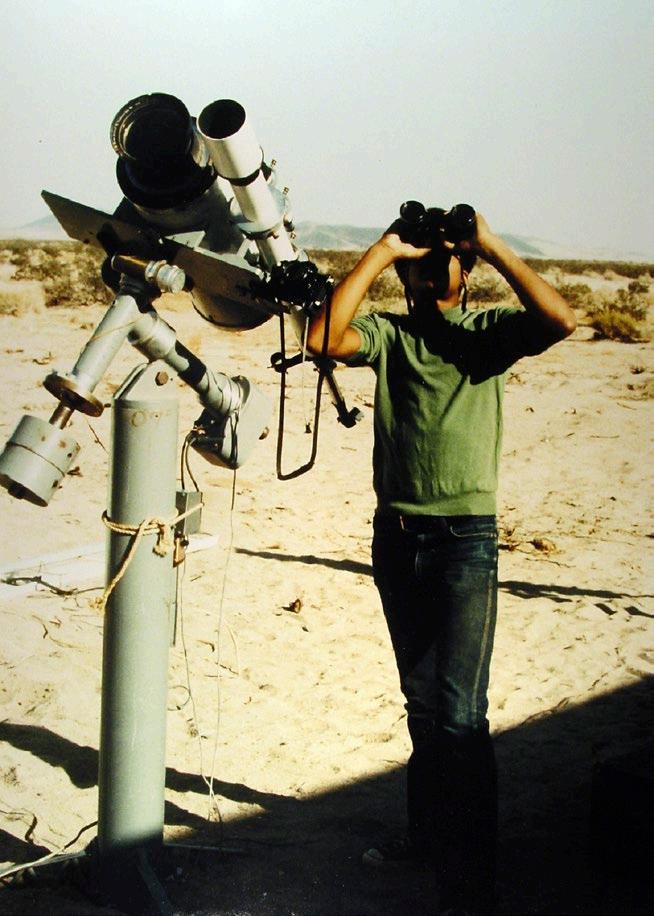
READER’S DIGEST FEBRUARY 2023 • 31

talented people for his cabinet and that gave me some confidence.
GETTING MY OWN SHOW ON PBS WASN’T REALLY AN AMBITION.
I’d never envisioned myself as a TV person but when I was offered that show [2004’s four-part Origins series, tracing Earth’s geologic evolution] I agreed to it because at the time I was teaching at Princeton, at most to 200 students and I thought, I can go on TV and talk to a million people. So I reduced my teaching load and started doing television with basically the same, or less, invested effort. It felt like being on TV would better serve the greater good.
IN 2009, I STARTED THE STAR TALK PODCAST which ended up being the first ever science-based talk show, when National Geographic picked it up for late-night broadcast. I delighted in chatting to such a diverse group of people, including former Presidents Jimmy Carter and Bill Clinton, David Crosby from Crosby, Stills & Nash, and Katy Perry. She doesn’t come to your studio, you go to her, so I interviewed her on this big comfy couch and she had such a refreshing, childlike curiosity. She asked, “There are so many people in the world—do you think one day we’re going to run out of souls?”
You’ll have to check out the show to see what my answer was!
I REMEMBER
32 • FEBRUARY 2023

I WAS LIVING FOUR BLOCKS AWAY FROM THE WORLD
TRADE
CENTRE ON 9/11. I witnessed events on that day first-hand. How did it make me feel? I’m not a very feeling guy; I mostly think rather than feel. But halfway through that day I was trudging through the dust on the ground from the collapsed buildings,
I had my nine-month-old son in a stroller and I went to pick up my daughter from kindergarten. At that point emotions flooded into my rational mind and over the coming months I found, oddly, that my writing improved, as did my ability to communicate and my capacity for empathy. It changed me profoundly.
APPEARING ON THE BIG BANG THEORY IN 2010 WAS THE FUNNEST DAY I HAVE EVER SPENT. The thing that really tickled me was that there was a TV show that was all about science. They had a PhD physicist on the payroll analysing every equation and every statement. Did the cast geek-out over meeting me? Not really because they’re actors and not necessarily from the geekdom. The people who really geek out are at Comic-Con. n
As told to Simon Button
Starry Messenger is published by Harper Collins and is available now
Winter Bird-Feeding Tips
Refill feeders promptly, as much as twice daily when the weather is really bad, as birds need to refuel after snowy conditions
Pick high-calorie food such as seeds and nuts. Other good foods include leftover pastry, fresh fruit, bread and rice. But if you only pick one, choose sunflower seeds
Don't forget to offer birds multiple feeding stations and water, breaking ice when necessary
READER’S DIGEST FEBRUARY 2023 • 33
Meet the women with EDS helping to shape the future for others
BY Amy Fogarty
ACCEPTING CHRONIC ILLNESS requires courage. But for three exceptional women, courage can be found in their refusal to accept the status quo. Be it through movement, charity, or science, each is driven by a relentless determination to improve the prospects of those who share their condition, Ehlers-Danlos syndrome (EDS)—a group of 13 heritable connective tissue disorders.

HEALTH
34 • FEBRUARY 2023
Jeannie Di Bon, Lara Bloom and Cortney Gensemer
© JEANNIE DI BON / ROSS FERGUSON / TIRZAH KOHLER




WE GO THROUGH SUCH A PERSONAL STRUGGLE TO FIND INFORMATION, I JUST WANT TO SHARE IT
Jeannie Di Bon is a firm believer that movement heals. Following a 35-year quest for answers, a physical therapist was able to connect the dots of her symptoms by asking just a handful of questions. Finally, armed with an explanation, the diagnosis of hypermobile Ehlers-Danlos syndrome
(hEDS) came as more of a relief than a surprise. Since qualifying as a pilates instructor in 2008, Di Bon had seen the condition manifest in various ways among her clients.
Thought to be the most common of 13 known subtypes of Ehlers-Danlos syndrome (EDS), the hypermobile connective tissue disorder is most often associated with joint hypermobility, instability, chronic pain, and dislocations. However, those impacted can face multisystemic symptoms and co-morbidities, such as gastrointestinal, neurological, and vascular disturbances, presenting on a wide spectrum of severity.
36 • FEBRUARY 2023 BENDING BOUNDARIES
© JEANNIE DI BON

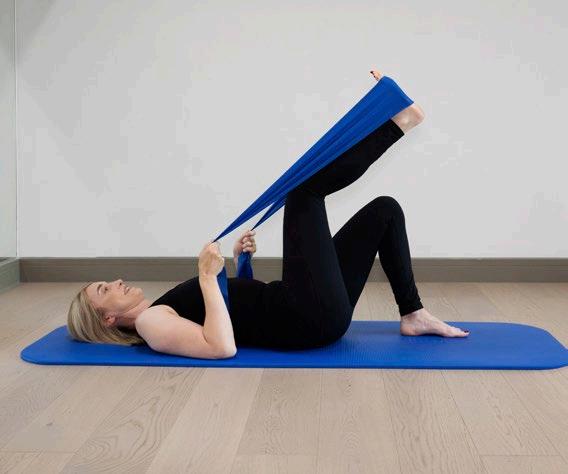
Despite yielding positive results, as Di Bon’s work with hEDS clients increased, she began to notice gaps in her teaching, and set out to address them: “That’s why I started to look more into the mind, into the breath, and relaxation… and modify the exercises so that they were safe and suitable for somebody who is maybe feeling very unstable.”
Through clinical research, coupled with training in biomechanics, anatomy, neuroscience and lifestyle medicine, the 52-year-old developed a new approach coined the Integral Movement Method. All this knowledge culminated in an app to address hypermobility, EDS, and chronic pain.
Jeannie Di Bon
“One of the things about The Zebra Club is it’s not just a collection of exercise videos. It’s become this whole network of support for people where they can really feel validated.”
Having experienced her own difficulties navigating the healthcare system, Di Bon reflects on why so many with EDS carve out a vocation linked to the disorder: “I think it happens because we go through such a personal struggle ourselves to find information, to figure it out. For me personally, I just want to share that.”
The Wimbledon native is constantly seeking a greater understanding of the body, currently studying for an MSc in Pain Management alongside her multi-
FEBRUARY 2023 • 37 READER’S DIGEST
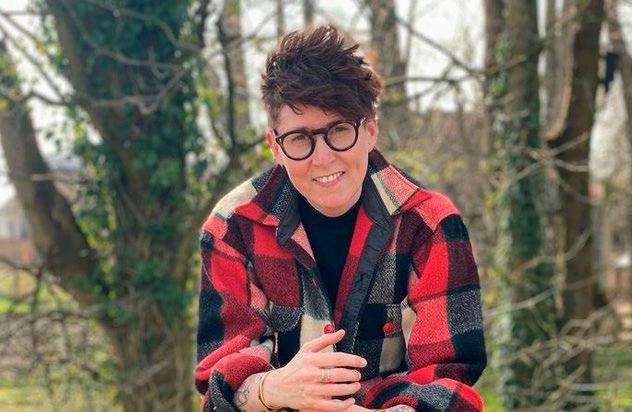
hyphenate lifestyle as an author, movement therapist, app founder, and award-winning community champion. But, through her six principles of painfree movement, Di Bon offers a sincere message of hope.
“We can always change something that would make your life better. Even if it’s the tiniest thing. I work with people who are bed bound, who have had to give up work, who are house bound, and we are working together to make their lives more fulfilling, to give them a better quality of life.”
This collaborative approach is at the core of Lara Bloom’s role as President and CEO of the global charity, The Ehlers-Danlos Society: “It’s really bringing together anyone who is
impacted by these conditions, but also the health professionals that are caring for them.”
Having left photography in 2009 due to worsening hEDS symptoms, a chance encounter with an affected parent re-routed the course of her life, bringing the 42-year-old to a career in leadership and advocacy. Although her own experience led her to the position, she insists it isn’t the reason she continues to strive for progress: “I do it because I love being a CEO of a non-profit, and I love running a nonprofit with a cause that means so much to me.”
However, when facing long hours, frequent travel, and occasional harsh scrutiny on social media, what drives her through the fatigue is:
38 • FEBRUARY 2023 BENDING BOUNDARIES
© LARA BLOOM
Lara Bloom
“remembering what it was like to be that child, undiagnosed. To not know any answers, to not have met anyone else with the condition.”
Arguably more so, Bloom has found motivation outside her own experience: “The people are the reason, and the stories I’ve heard, and the amount of work there is still left to do. That’s what drives me.”
While that work includes a largescale genetic research study, re-evaluation of the current diagnostic criteria, and the hosting of international annual learning conferences, one change is much cheaper to address. Reporting a host of seemingly unrelated and often generic complaints, such as fatigue or pain, patients with all types of EDS are often dismissed by health professionals as hypochondriacs.
Bloom is keen to address this injustice, especially given the average diagnosis time for EDS is ten to 12 years: “If doctors could just take the time to hear, listen, believe, and validate what people are experiencing, that’s half the battle right there.”
Of the immediate future, the Hertfordshire-based CEO believes the next two to five years will yield significant changes. Her hopes include: “Awareness, education, and making that diagnosis a little bit more black and white, instead of so grey. If we could have some genetic testing that could help, and go a long way.”
Such advancements are already in the works, and are a source of great pride for Bloom. Science aside, her aspirations for the future of EDS diagnosis are as lofty as they are humble: “I would like for our community, and for all those impacted by EDS and HSD (hypermobility spectrum disorders) to get to a stage
IF WE COULD HAVE SOME GENETIC TESTING THAT COULD HELP, AND GO A LONG WAY
where people are diagnosed at the point when their symptoms begin, and those symptoms managed and cared for locally and long term.”
Sharing similar ambitions is a postdoctoral scholar working in the Norris lab at the Medical University of South Carolina (MUSC). Not many 26-yearolds can profess to be concerned with legacy, but Cortney Gensemer is already leaving her mark.
Gensemer was diagnosed with hEDS as an undergraduate, following a bout of serious injuries. Relieved to have an explanation for her symptoms, the news also altered her career trajectory, pushing her away from medicine and towards research.
FEBRUARY 2023 • 39 READER’S DIGEST
A fortuitous meeting only days into her PhD programme in 2018 led Gensemer to an extraordinary opportunity. Shocked to hear the genetic mutation responsible for hEDS was yet to be found, esteemed professor, Russell “Chip” Norris, PhD, offered the young scientist a rotation in his lab. His challenge to her: find the responsible gene.
Starting as a side project, the quest
THE
BIG GOAL IS TREATMENT AND WORKING ON UNDERSTANDING THOSE PATHWAYS
swiftly became the focus of Gensemer’s PhD dissertation. And beyond all expectations, one genetic mutation has already been identified, the findings of which are expected to be published shortly. Impressive enough. Yet, the scholar has greater ambitions of improving diagnosis through the identification of biomarkers to be used in blood tests: “Obviously, the big goal is treatment, and working on understanding those pathways, and how we can try to treat the disease.”
The Charleston resident is keen to clear the path for others to follow in her footsteps. An internship programme hosted by the Norris lab

40 • FEBRUARY 2023 BENDING BOUNDARIES
© CORTNEY GENSEMER
Cortney Gensemer

each summer provides opportunities for young people with hEDS to gain scientific experience, and participate in the effort to advance research in their own condition. Awarded funding by a foundation for the next three years, Gensemer was overcome by the decision to actually name the internship after her: “Getting my PhD was awesome, but knowing that what I was doing was impactful enough that they wanted to fund it and name it after me was even cooler.”
The purpose of the programme is clear. “Not only does it give them an opportunity to work on EDS, but it also shows them that their disability isn’t going to limit them from working in a lab.” Offering accommodations, such as accessible doors, and ergonomically designed pipettes, the lab are eager to demonstrate: “even though they might be limited in some capacity… if you make accommodations in the lab, you can do research, you can get a PhD.”
Understanding this isn’t the case for many, all three trailblazers acknowledge their unique privileges, such as enhanced knowledge of hEDS, access to informed practitioners and financial capability. But each embodies the importance of patient representation in turning the tide against what was a previously neglected disorder. Gensemer says it best: “I think with patients being involved, it keeps that momentum going, because the drive and the passion and the interest is there.” n
READER’S DIGEST FEBRUARY 2023 • 41


THE
HEALTH

BLENDING INTO
CROWD
Social masking behaviour could be sabotaging your self-esteem. Here’s how to spot the signs
BY Victoria Stokes
FEBRUARY 2023 • 43
“I’VE DONE SUCH A GOOD JOB OF PRETENDING TO BE AN OUTGOING PERSON THAT FRIENDS AND FAMILY ARE SHOCKED WHEN I TELL THEM I’M NOT.”
AMANDA* (37) IS TALKING ABOUT HER EXPERIENCE OF SOCIAL MASKING. SHE SAYS IT’S SOMETHING SHE’S ALWAYS DONE.

44 • FEBRUARY 2023 SOCIAL MASKING
Ever since she was a teen, she became an expert at working the room. She would seamlessly adopt the mannerisms of the people around her in a bid to fit in, while concealing her true personality.
At times, this would extend to the clothes she wore, the people she dated, and the jokes she would tell. And by her own admission, sometimes it was hard to tell who was actually the real Amanda and who was the fake.
This is social masking, the process of suppressing or concealing your natural way of interacting with others so you can feel accepted. Social maskers aren’t trying to deceive anyone; rather, they are hoping to blend in with everybody else.
“Social masking is a learned set of conscious pattern-matching behaviours, movements and actions where you mimic 'normality' to fit in rather than stand out,” explains psychotherapist Dipti Tait.
“It’s generally adopted by people who are unable to naturally act in a way that is considered socially acceptable.”
Social masking behaviour is often used by people on the autism spectrum, but according to psychologist Dr Tara Quinn-Cirillo, it’s something that we all engage in to a certain extent.
She says social masking can manifest as copying what others do, such as body language, facial
expressions and behaviour or practising what you may want to say.
While it can look different for everyone, social masking typically involves suppressing your natural urges (for example, forcing yourself to sit still or smile), offering rehearsed responses, and changing your personal interests to fit the crowd.
FITTING IN
In a world that often tells us to just be ourselves, you might wonder why many of us are reliant on these social masking behaviours.
“Social masking happens because we as a species want to be included,” says Tait. “It’s a tribal thing of being together rather than being on our own; a primitive part of our evolution to blend in, rather than stand out, to socialise, rather than be anti-social, to fit in rather than be a misfit.”
The mask is usually simply protection against our self-doubt. “We all have certain masks to protect ourselves from ridicule, exposure, difference and imposter syndrome. Our masks enable us to get through some tricky life situations with confidence,” Tait surmises.
To an extent, social masking is also built-in at a physical level. Tait says we are creatures of pattern-matching.
“We have something in our brain called mirror neurones. These are pattern-matching neurotransmitters that give us indications of how to
FEBRUARY 2023 • 45 READER’S DIGEST
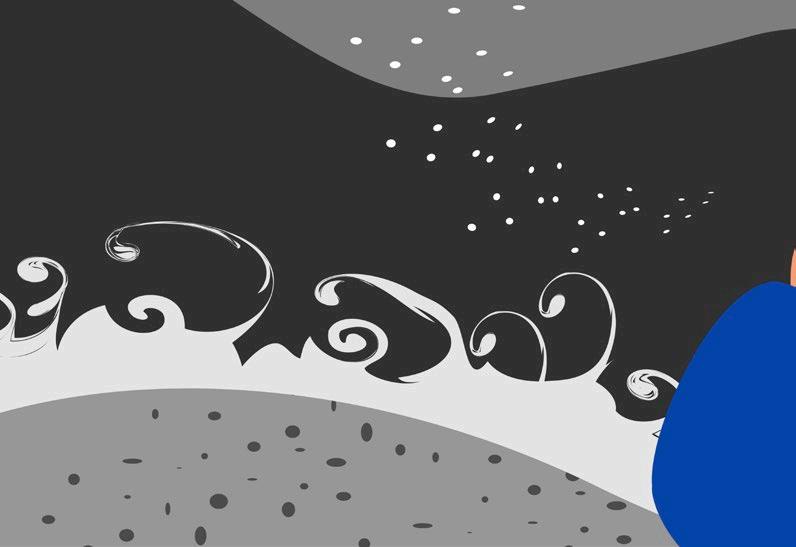
behave and blend in to essentially stay safe and not stick out,” explaining how deep-rooted this behaviour is.
Add to that, Quinn-Cirillo believes social media may have made it even harder for us to be ourselves. She notes that social media gives us set images and videos that may make us believe this is how we should be.
You might be wondering how social masking differs from being a slightly different version of yourself around different groups of people. For example, you might find you’re the life and soul of the party around your closest friends, but more subdued when you’re with work colleagues. Our personalities are largely fluid. They naturally change shape
depending on the company we keep, and Dipti says there is a huge difference between being in natural rapport with someone and consciously social masking.
“When we are in natural rapport with someone, we unconsciously get into sync with that person. Our breathing patterns begin to match the other person, our pace and tone change, and our body language adapts,” she explains.
“These are subconscious clues that we are 'on the same page' as the person we are speaking to and interacting with. It happens naturally, and there is very little effort involved.” Social masking on the other hand involves a conscious
46 • FEBRUARY 2023
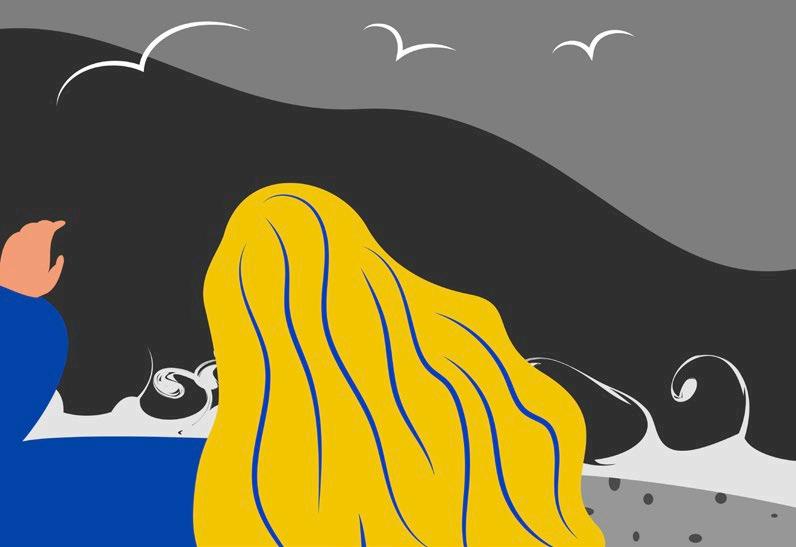
effort to mould your personality to suit your surroundings.
CONFIDENCE CRISIS
In some scenarios, this can be beneficial. For example, it may curry favour with your boss and help you net a promotion or allow you to forge new connections with people outside of your social circle.
However, for Dipti, social masking moves into dangerous territory when you try to be someone you are not. She references the popular adage "Fake it ‘til you make it."
“If the ‘fake it 'til you make it' system is used to improve a quality in one’s self for self-development
purposes, then this is a very good way of training the brain and the body to adapt and create better thoughts, feelings, habits and beliefs,” she reasons about the positive side.
“But if it is being used to patch over self-doubt and boost one's self-belief, self-worth or self-value, then this is where the system can be damaging.”
Social masking can compound the belief that you are not enough as you are and chip away at your confidence and self-esteem over time. The more Amanda masked her true self, the more she says she lost faith in herself.
“I couldn’t see the positive qualities I had to share with others and the more my confidence dipped, the more I felt I had to rely on social
FEBRUARY 2023 • 47

masking behaviours,” she reveals of her actions.
Confidence issues aside, social masking can also be incredibly draining. “For anyone who masks, it can impact mental health in the long term, due to the effort involved,” Quinn-Cirillo points out.
“Continually stepping outside of who you are can impact your selfesteem and self-worth and you may feel that you are ‘stuck’ in a cycle of having to present a different self to the outside world.”
BEING YOURSELF
So, how can you break the cycle? Getting rid of the mask involves
working to improve your self-worth, self-belief and self-esteem.
The goal, says Tait, is to feel safe enough to remove the mask; to feel comfortable in your own skin and to be able to use your voice clearly.
It’s by no means a quick fix. The next time a thought of self-doubt pops into your head, Tait encourages you to ask yourself what you’d say if a friend was experiencing that very same negative thought.
“This answer is often much kinder. You need to work out how you can use this kinder approach on yourself.”
Next, learn how to interrupt those damaging thoughts that all too often tell you it’s not OK to be yourself. Tait says to be on the lookout for phrases
48 • FEBRUARY 2023
like "I am not good at that", "I can’t do that", or "I am not worthy".
Then, once you hear these thoughts, take action and stop the damaging dialogue. Tait advises asking yourself, “What if that self-limiting belief was not true? What would change? What small thing would I do differently?”
Doing this repeatedly over a long period of time gives those selfdefeating thoughts less power and improves your self-belief, meaning the urge to social mask won’t be quite so powerful.
On the practical side of things, Quinn-Cirillo suggests finding someone you can easily and authentically connect with when you first arrive at an event and deciding
how long you want to stay before you get there.
For Amanda, the key has been testing the waters with close friends and family. “I’ve started showing the real me to the people I most trust, and it’s given me the confidence to be a little more myself. It’s a reminder that the right people will love you for you," she says.
Her advice is to start showing others your personality in small ways: tell that joke you think is funny or say what you want to say instead of just what you think people want to hear.
Lastly, be kind to yourself. QuinnCirillo says social situations can be tough to navigate for all of us. n
*Name has been changed
Pancake Day
The biggest pancake ever made was 15m wide and 2.5cm deep, containing a staggering two million calories
Eating pancakes on Shrove Tuesday, to use up fatty and rich foods before Lent, dates back over 1,000 years
The biggest pancake flip measured over 31ft and was set by Mike "The Pancake Man" Cuzzacrea in 2010 in New York
The town of Olney in Buckinghamshire is famous for its annual pancake race, with the first run recorded in 1445
British people use a jaw-dropping 52 million eggs on Pancake Day alone, which is 22 million more than any other day
In France you make a wish before flipping a pancake, while holding a coin
READER’S DIGEST FEBRUARY 2023 • 49

7 Signs It’s
Perimenopause
It’s that weird run-up to menopause, but you might not realise you’re in it. Here’s are a few ways to tell

Susannah Hickling is twice winner of the Guild of Health Writers Best Consumer Magazine Health Feature
1There could be more blood— or less. Some women have fluctuating hormone levels for as long as a decade before their periods stop, while others only have fleeting, if any, symptoms. A key one is that your periods change. Some women have much heavier or longer bleeding. A survey from the University of Michigan found that more than a quarter of women experienced at least three periods in six months that lasted ten days or more. Others have a lighter flow than previously. You might find that the interval between your periods gets longer, or you could find they start coming closer together.
50 • FEBRUARY 2 022 HEALTH
2
You’ll get hot —but not necessarily in the bedroom. We all know about hot flushes and night sweats, but no one yet knows what causes them. They can go on for years, even persisting— sorry, ladies—well beyond menopause. Regular exercise and losing weight if you’re a few kilos over can help alleviate hot flushes. Yet while your body is overheating, your libido can cool down drastically. It could be because your hormone levels are plummeting or because sex becomes painful because of vaginal dryness. Lubricants or hormone creams, gels or other treatments can ease this uncomfortable symptom.
3 You become a stranger to sleep. Women approaching menopause are sometimes puzzled at their new-found inability to sleep, before realising that perimenopause might be to blame. Avoid having caffeine and too much alcohol in the evening. Both can keep you awake.
4
Moody is your middle name. Sleeping badly can make you irritable too, adding to the mood changes caused by your hormones going haywire. Many perimenopausal women suffer from anxiety and depression. According to an eight-year University of Pennsylvania study, women with no
history of depression were up to four times more likely to feel low during perimenopause. Exercise can help you feel better, with the added bonus that weight-bearing exercise such as running or dancing can strengthen bones, which suffer from a loss of density with menopause. Just avoid exercising too close to bedtime.
5 There could be problems with your face Thought acne was a thing of the past? Sadly, it can come back at perimenopause as oestrogen levels drop. At the same time, you might start sprouting facial hair.
6
You could have toilet trouble. Perimenopause is the time when you start weeing more, including getting up in the night, and getting irritable bowel syndrome symptoms, such as bloating. Eat a healthy diet. You might get more urinary tract infections too. You can help prevent them by peeing after sex and making sure you wipe from front to back.
7
You forget a lot of stuff. Yup, we’re talking about brain fog. Problems remembering simple things, thinking clearly or concentrating are very common. The good news is that once you are officially in menopause, your brain function recovers. n
FEBRUARY 2023 • 51
Vape Expectations
E-cigs are still a new trend, scientifically speaking. But evidence is stacking up, both of the pros and cons
Pro: Vaping helps you give up smoking. E-cigarettes are a very popular way of giving up tobacco, as they still contain nicotine, which is what smokers are addicted to. And they work pretty well. According to Public Health England, using a vaping product in local stop smoking services as part of an attempt to quit had a high success rates—between 59.7 per cent and 74 per cent in 2019 and 2020—and were more effective than conventional nicotine replacement therapy.
Pro: Vapes might be less harmful than cigarettes. Regular cigarettes aren’t called cancer sticks for nothing. They contain around 7,000 chemicals, many of them harmful for health. E-cigs contain far fewer, though no one yet knows what effect they might have on your body long-term.
Con: There’s evidence that they’re as bad for your heart as cigs. Researchers from the University of Wisconsin recently reported that study participants who vaped or smoked
tobacco had higher blood pressure, a faster heart rate and greater blood vessel constriction after vaping or smoking than people who didn’t use nicotine. Vapers also performed worse in a treadmill exercise that predicts heart disease risk.
Con: They’re associated with lung problems. Researchers from Johns Hopkins Medicine in the US found vaping was associated with a higher risk of asthma and COPD. Also— though mainly in America—there have been cases of a lung disease known as EVALI (e-cigarette or vaping product use-associated lung injury). Symptoms can include cough, chest pain and shortness of breath.
Con: EVALI has led to death in a minority of cases. Three deaths were documented in the UK between 2016 and 2021.
Pro: E-cigs are regulated in the UK. Vapes containing nicotine that can be sold in the UK are regulated by the Medicines and Healthcare Products Regulatory Agency (MHRA). They are not allowed to contain cannabis or cannabis-derived ingredients, or Vitamin E acetate oil, which have been linked to EVALI. n
For more weekly health tips and stories, sign up to our newsletter at readersdigest.co.uk
HEALTH 52 • FEBRUARY 2023

Professor Tracey Williamson is a consultant nurse and associate at the charity Dementia Carers Count
Ask The Expert: Caring For Someone With Dementia
How did you become an expert in dementia care? I’ve combined 33 years as a registered nurse in older adult NHS settings, including people with dementia, with academic roles, such as a professor of family care. My research relates to dementia and family carers of people with dementia.
What are the challenges faced by carers of someone with dementia? They have to deal with the realisation that there’s something wrong and transition to their identity as a carer, understanding their life will change. Caring can be 24 hours a day, affecting sleep and wellbeing, with a risk of burnout. How do carers equip themselves to deal with their loved one’s mood changes and personal care, for example?
How can carers best offer care and support to a loved one with dementia? Seek support services— statutory health and social care or charities—for guidance and financial advice, including on carers’ allowance. It’s important carers help the person plan for the future and know their wishes. Later they may want to consider lasting power of attorney for
health and financial matters. Carers can help the person meet and talk to other people with dementia.
How can carers look after themselves? Embrace online and face-to-face support. Keep a sense of your own identity. What are your interests and what support networks do you have? Don’t give up on them. It’s important for wellbeing and resilience. Get professional and peer support to release time to do things for you.
What support is available to dementia carers? Support services are available through charities like Dementia Carers Count, a UK charity which focuses on families living with dementia. It provides free resources, online and in-person events and a telephone support service. Ask your GP about a carers’ register which can give you priority for vaccinations and appointments. Technology helps, such as location devices and motion sensors that alert you when a person gets up in the night. n
Visit dementiacarers.org.uk or call 0800 652 1102
FEBRUARY 2023 • 53

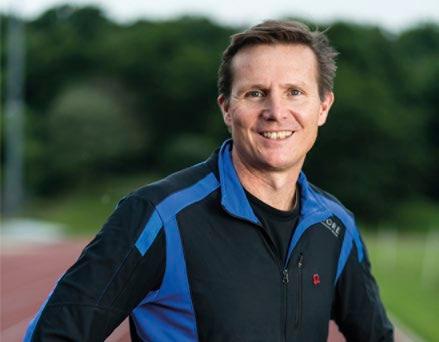
23 For 2023:
23 fitness tips to get started in the new year
Now that 2022 seems like a distant memory, some of you may have thought about increasing your health and wellbeing for 2023. But where do you begin? The team at Roger Black Fitness have come up with 23 top tips to help guide you through the often confusing path of getting started
1. create a short list
What do you want to achieve? It might be walking on a daily basis, improving your cardio health, or cutting down on fatty foods, as advised by a GP.
2. Budget
How much can you spend on wellness? If you are committing to a piece of
home fitness equipment or small accessories, write down a ballpark figure.
3. space
If you are hoping to start exercising at home, first work out how much space you have—and don’t forget about storage for equipment. This can impact upon any purchasing decision.
4. Medical conditions
Consider health challenges or limitations, as these will affect or, in some cases, limit what you are able to do.
5. ask for help
If you are stuck, reach out to trusted brands or even a medical professional for advice.
6. tiMe
How much time are you able to commit to your wellbeing journey? Be realistic about what might be feasible for you.
7. solo or group
Are you hoping to start your journey alone or with a loved one, friend or group? Being accountable to someone else can often be a good motivator.
8. Be kind to yourself
Don’t become overwhelmed. Go at your own pace when making decisions.
9. research
Look into different options, reviews and what is available to suit you.
10. Warranties
Always check a product
PARTNERSHIP PROMOTION
warranty prior to purchase, to give you that extra peace of mind.
11. asseMBly
If you live alone and you want to buy a bike for use at home, consider assembly and whether you feel up to a small challenge (or if you have someone to assist).
12. go for it
Once you are clear in your mind about the preparation, go for it! You’ve done your homework and committed to a plan that can work for you.
13. clothing
For any type of exercise, please ensure that you have suitable non-slip footwear and breathable clothing.
14. delivery
If you have ordered something online or in-store, when it arrives, make sure everything is in the box that should be there.
15. getting started
The planning is all done;
you have your goods; now you need to get yourself mentally and practically prepared for next steps.
16. Mindset
This journey is yours and you shouldn’t be scared, even if you haven’t exercised for many years.
17. haBits
Starting slowly and building up your chosen activity or lifestyle changes should not be seen as a chore, but more as a habit that becomes part of your daily or weekly routine.
18. WarMing up
We can’t stress enough how important it is to stretch or warm up before and after exercise, particularly if you have joint or mobility issues. If you don’t know how to stretch, there are lots of helpful resources online.
19. hydration
Make sure that you have some fresh water to keep you hydrated while you are
exercising and that your room is ventilated.
20. patience
It is definitely a virtue. You won’t see results overnight but small steps and small changes will serve you right in the longer term.
21. MoMentuM
Keep going! Start slow, even just for five minutes a day, and build up gradually over time. If writing down or typing a little plan into your phone or tablet helps, find a path that works for you.
22. persistence
Sometimes you won’t feel up to your new challenge, so don’t feel bad if you skip your daily walk or get tempted by a home-made chocolate brownie.
23. pat on the Back!
At the end of each month, take stock of where you are compared with how you felt when you started. Progress, not perfection, is the order of the day. n
Reader’s Digest readers can benefit from an exclusive 10% discount on the full range of Roger Black Fitness products. Simply use the code DIGEST10 at checkout via www.rogerblackfitness.com. For T&Cs see website for more details
It costs nothing to be nice, and it might just save someone’s life, reflects Dr Max
Small Acts Of Kindness
Afew years ago I worked in a project for homeless people. There was one young man in his early twenties whom we had all been very worried about. He had absolutely no one in his life. His father was in prison for murder. His mother had been a drug addict. When he was six years old he was placed in foster care because teachers noticed that he was coming to school in dirty clothes. It transpired that he was being abused by his mother’s boyfriend. He spent the rest of his childhood in and out of children’s homes. His mother had died a few years previously of a drug overdose. He had no qualifications, nothing

Max is a hospital doctor, author and columnist. He currently works full time in mental health for the NHS. His new book, The Marvellous Adventure of Being Human, is out now
going for him in life. He started using drugs, got kicked out of the hostel he was living in and ended up homeless. When you work with homeless people, you hear versions of this story time and time again; no love, no stability as a child; a wound so deep that nothing can heal it. As if all this wasn’t enough, he also had schizophrenia. It’s fair to say that when confronted with a patient like this, it’s easy for your heart to sink. Where do you even start? I’d been asked to see him because the nurses had become concerned about his mood. He couldn’t see the point of keeping going. Someone with his history, in his circumstances is at a very high risk of suicide, so I saw him as an emergency.
He shuffled in, hardly making eye contact. We started talking and I asked him directly if he had been thinking about killing himself. “I think about it every day,” he said. “Wouldn’t you if you were me?.” I asked him if he
56 • FEBRUARY 2023 HEALTH

had made plans. He shook his head. “I couldn’t do it to Becky,” he said. I was confused. Who was Becky? I’d thought he was totally alone—no family at all. “She talks to me every day,” he explained. “She’d be heartbroken. She’s the only reason I keep going.”
Becky, it transpired, was not a family member or a girlfriend. She was just a commuter who, on her way home from work every day, stopped and spoke to him. “She never gives me money, because she says I’ll use it for drugs,” he explained and added, with almost a smile, “which I would.” She only stopped for ten minutes or so while she waited for her train, but would often buy him a coffee or sandwich and sit with him on the train concourse. “It’s funny,” he said. “She’s got a good job, but she always sits on the floor next to me.”
She never failed to stop and it was a fixture in his day. It was a tiny gesture. For her, it was an insignificant event
WITH JUST A TINY GESTURE, SHE HAD GIVEN A YOUNG MAN A REASON TO KEEP ON LIVING
in her day; a moment of kindness and humanity while she waited for her train. Yet for him, it signified something so much more. I suspect even now she has absolutely no idea of the importance of what she had done. She had shown a damaged, unloved young man who the world had only ever shown harshness and cruelty to that, actually, there was some kindness in it after all. She had given him a tiny glimmer of hope that he held on to with all his might. With just a tiny gesture, she had given a young man a reason to keep on living. While it might not make headlines, sometimes it’s the small, simple acts of kindness that can make all the difference. n
FEBRUARY 2023 • 57
The Doctor Is In
Dr Max Pemberton
Q: Dear Dr Max, I am in my sixties and have developed a wheezy cough and dry stuffy nose which have persisted for the past few months. I don’t smoke, although I have spent a lot of time around smokers from an early age. I don’t have COVID. Any idea what could be causing this, and any tips for getting rid of or easing my symptoms?
- Katherine
careful examination by your GP, who may prescribe things like an inhaler or refer you to a respiratory doctor for further tests and treatment.
A: Dear Katherine,
Well, these are an interesting two symptoms. A wheezy cough is most commonly caused by asthma or COPD (chronic obstructive pulmonary disease) because both conditions cause narrowing and spasms of the small airways in the lungs. Because the airways are not as large and open as usual, the air makes a wheezing noise when you cough. Asthma can come on in later life and COPD usually develops as people age. You don’t mention if you have allergies, but these will usually make the wheezy cough worse. There are various medications that can help. You’d need a

By “dry stuffy nose”, I presume you mean that the nose or sinuses feel blocked, but that it’s not runny or productive? Usually a blocked nose is caused by mucous, and while the mucous might be thick, it’s productive when you blow your nose. This can happen in relation to allergies, other irritants or infections that cause the nose to make thick mucous. If it is productive, just not “runny”, then this might be caused by some sinus infection. If people get an infection and also have asthma or COPD, then they might have a combination of a blocked nose and wheezy cough. But if there’s no mucous at all, then it would suggest some kind of blockage. This can be caused by polyps (small fleshy growths) that obstruct the sinuses. It would be sensible to go to your doctor who can take a full history of your symptoms. n
Got a health question for our resident doctor?
Email it confidentially to askdrmax@readersdigest.co.uk
HEALTH
illustration by Javier Muñoz 58 • FEBRUARY 2023

Just Cycle And fold
away
There’s no excuse not to get on your bike in 2023. Get your indoor cycling fix and feel the benefits.
Great for general cardio fitness, exercise bikes can be a brilliant way of training at home. However, choosing the right bike is incredibly important, which is something that Roger Black and his team recognised when creating the Roger Black Folding Exercise Bike.
“Best Present EVER are the words from my 77-year old father who received his Roger Black fitness bike for his birthday. He said it is so simple and easy to use, with no complicated gadgets. The seat is VERY comfortable, so using it everyday is a pleasure. It folds away neatly so it can be stored behind a door if need be”
Anna, Farnham

Roger Black is o ering a 10% discount on the full www.rogerblackfitness.com range of home fitness equipment for all Reader’s Digest readers. Please use discount code DIGEST10 at checkout. Standard T&Cs apply.
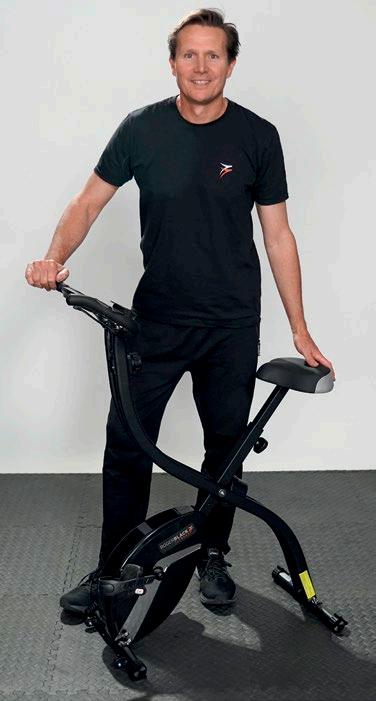

4.5
How To Travel In Time
It pays to connect with your past and future selves, says our memory expert, Jonathan Hancock
The term “nostalgia” used to describe a mental disease.
The “algia” bit means “pain”, and the word was coined by a 17th-century doctor treating homesick soldiers, whose symptoms included hallucinations and melancholy.
Today we have a much more positive attitude to nostalgia. And it’s a great example of the benefits of a strong memory—choosing to recapture moments from the past, often through a range of senses, to enjoy them all over again.
As evidence, a recent report highlighted the increase in old songs being streamed on Spotify during lockdown. It seems that we found strength in musical memories of happier times.
But there’s also a growing body of research into time travel “the other way”. Because memory skills can take you into the future, too—bringing a whole new set of rewards.
In another pandemic experiment, people wrote letters to their future selves, and found that they boosted their mood by imagining themselves safely on the other side of COVID-19.
Here are my tips for becoming a confident time traveller yourself:
• To revel in helpful memories, maybe to reawaken happy feelings, use all your senses—not just sight. Smell, taste, touch and sound will also help you to recreate the past in rich clarity.
• If you find a memory that’s particularly helpful—for reassurance, say—keep using it! You’ll get faster at finding it, and add extra layers of detail each time.
• When you’re procrastinating, visualise an end result. Flash forward to see the floor swept or the essay finished, and use that positive image to spur you into action.
• Ahead of major challenges, imagine the full impact of success. Don’t just picture yourself getting that great job: fill your mind with the really big ways it’s going to change your life.
There’ll still be times when old thoughts evoke sadness, or you’re anxious about what’s next. But the more you learn to control your memory, the better you’ll be at mining your past, and shaping your future, to be your best self now. n
60 • FEBRUARY 2023 HEALTH























Love your heart







The Cardioace® range has been developed by Vitabiotics’ nutritional experts based on extensive research on the role of nutrients in normal heart health.



Cardioace® Original provides comprehensive daily nutritional support including thiamin which contributes to normal heart function plus vitamins B6, B12 and folate which contribute to normal homocysteine metabolism.
Cardioace® Plus provides the benefits of the Original formula plus even greater nutritional support with 1.3g of Plant Sterols scientifically proven to help maintain normal blood cholesterol levels1, as well as Omega-3 fish oils.














Cardioace® Max provides all the benefits of Cardioace® Plus, with an additional capsule of premium quality Red Krill Oil, a superior, easily absorbed source of Omega-3 DHA and EPA fatty acids, which contribute to normal heart function2 .




















ORIGINAL
from Britain’s No.1 Vitamin Company*
with thiamin which contributes to normal heart function With thiamin (vit.B1) to contribute to normal heart function With 1.3g plant sterols which contribute to the maintenance of normal blood Thiamin (vit. B1) which is scientifically proven to contribute to normal heart function From , Superdrug, Holland & Barrett, pharmacies, supermarkets, health food stores & www.cardioace.com 1. A beneficial effect is obtained with a daily intake of at least 0.8g of plant sterols. 2. A beneficial effect is obtained with a daily intake of 250mg of EPA and DHA. * Nielsen GB ScanTrack UK Total Coverage Value & Unit Retail Sales 52 w/e 8/10/22. To verify contact Vitabiotics Ltd, 1 Apsley Way, London, NW2 7HF. 2022-12-13_ADCARCONP_E
We Need To Stop Looking Down On Settling
Remember that famous scene in the film Dirty Dancing, where heart-throb Johnny rescues Baby, his young leading lady, from the thralls of her conversative family?
“Nobody puts Baby in the corner,” he declares, marching her up to the stage for an impromptu dance performance. He’d risked it all for their affair: his job! His reputation!
But that’s what you do when you’re in love, right? I mean truly, headover-heels falling for someone?
Dirty Dancing is a film, but it speaks well to the expectations our

Monica Karpinski is a writer and editor focused on women’s health, sex, and relationships. She is the founder of women’s health media platform The Femedic
culture places on love and romance. We’re told that “The One” is out there waiting for us: a partner who fulfils all our emotional needs. And when we find them, it feels like magic and fireworks, all the time.
Accepting anything less than this would be settling. You didn’t get what you hoped for, and have compromised your romantic aspirations for the security of companionship in life.
Because it means we aren’t striving for the “best” outcome, we tend to see settling as something icky and distasteful. But in a world always pushing us to go for more, what if having enough is, well, enough?
Fairy tales are nice, but they aren’t real. And when we expect other people to make us feel like we’re in one, we hold them to impossible standards—anything less than being swept off our feet can only feel like a total letdown.
But if we dial our expectations back down to earth, we can instead approach new people and experiences with an open mind. This isn’t to say that we should indulge
62 • FEBRUARY 2023 DATING & RELATIONSHIPS
bad behaviour, but that we should size up potential suitors for who they actually are, rather than how closely they emulate Patrick Swayze.
Besides, falling for someone doesn’t always feel like fireworks. Some people describe feeling a sense of peace and calm when they met their person, while others say that their love developed gradually as they got to know their partner. Feelings will hit us how they hit us.
When we expect a fairy tale, we hold people to impossible standards
be perpetually stressed and miserable.
Feeling safe and comfortable with someone might even be the best bit of being in a good relationship— where you’re free to be yourself and are loved for it. Sure, that sounds less exciting than being pulled up on stage by Prince Charming, but honestly, it’s way better.
We’re also quite bad at predicting what type of person we’ll click with. In my previous column, I wrote about how dating app filters don’t actually improve your chances of finding love, because random facts about someone have no bearing on whether things will work between you and them.
If you close yourself to the possibility of finding happiness in something you didn’t expect, who knows what you’re missing out on?
The shade thrown at settling also makes light of how incredibly important comfort and stability are to our wellbeing.
These aren’t mere consolation prizes. Without having people we can consistently count on, and being able to trust they’ll stay in our lives, we’d
There’s also a philosophical argument, courtesy of Robert Goodin, that settling is a way of fixing someone in place within our lives—and that having this constant then grants us the headspace to strive in other areas.
Instead of saying that we are “settling for” someone, Goodin suggests, perhaps we might say “settling on”.
Settling here isn’t a form of resignation but a way of building up a life we like with someone we choose. “Enough” isn’t a consolation; it’s the prize.
We’re each responsible for defining what exactly “enough” means for us, and how we set expectations around this.
I suggest asking yourself: does your person meet your emotional needs, even if they aren’t who you thought you’d fall for? If you’re happy, is that enough? n
FEBRUARY 2023 • 63
Relationship Advice
Monica Karpinski
Q: Should I leave my new partner, who is 15 years older than me, as the risk of caring duties and widowhood in my younger years is higher?
- Sally
A: The fear that your partner will pass away first, sometimes known as death anxiety, is common enough in age-gap relationships. It’s understandable, but whether it’s enough of a reason to end things is really a question of whether you’re willing to commit despite the risk that you’ll go through pain and difficulty later.
I’m sorry to say that leaving your partner won’t allow you to sidestep these tricky experiences. While the fear of loss certainly feels more apparent when there’s an age gap between you, grief and heartache are existential threats that hang over us all. There’s not a long-term human relationship on earth that hasn’t come with its share of difficulties.
The only way to totally avoid being hurt is to not get close to anyone, which is its own sort of hell.
If you stay, you need to accept your partner for who they are, including their age and bill of health. They
might need more support in the future, but so might you from them— any one of us could fall incredibly ill, or even get hit by a bus, on any given day of any year.
This is easier said than done, though—working through the fear of loss is personal and complicated, and it can take time. Be patient with yourself and you should consider seeking professional support if it gets too much.
When making your decision, remember that being someone’s partner is a commitment that should be willingly made. If you aren’t prepared to show up for them, ask yourself why. What is it about the relationship that’s not sitting right with you?
Only you can say whether your misgivings are enough reason to walk away, but you should make that call based on the relationship itself rather than a fear of the unknown. There’s always a risk that things will end in tears; don’t let that hold you back from giving them a chance. n
Got a question for our resident sex and relationships expert? Email it confidentially to thelovedoctor@readersdigest.co.uk
64 • FEBRUARY 2023 DATING & RELATIONSHIPS

From grandiose organ music to majestic vocal scores and delicate chamber music, Bach wrote over 1,000 masterpieces in his lifetime – and they haven’t aged a bit.
Vialma, the streaming service for classical music and jazz, has chosen a selection of his work for you to discover, helping you become better acquainted with this incredible, prolific composer.
Brandenburg Concerto No. 2 in F major, BWV 1047: III. Allegro assai In 1721, Bach composed six concertos which he dedicated to his Royal Highness of Brandenburg. Uncovered a century later, they became an instant hit. The first movement even went into space in 1977 on the Voyager Golden Record, giving a taste of classical music to potential extra-terrestrial beings.
Goldberg Variations, BWV 988
Supposedly composed for Count Keyserlingk, this work was for his personal musician to play to him during his frequent bouts of insomnia. Originally written for harpsichord, they are now a hallmark of the piano repertoire as well and one of the most recorded pieces in music history.
Want to find out more?
Toccata and Fugue in D Minor, BWV 565
With its terrifying chords, Bach’s famous Toccata in D minor certainly makes our hair stand on end!
From Doctor Jekyll and Mister Hyde to the Kraken theme from Pirates of the Caribbean, it’s no wonder it has been used as an accompaniment to some scary movies.
On Vialma, the multimedia streaming platform for classical and jazz, you can dive deeper than ever into Bach’s world. Start your journey by signing up to our special £1 for 3 months offer today – visit bit.ly/vialma-readers-digest
Spread the word:
There’s an easy way to enjoy more of the things you love
MAKE MORE TIME
TIME. It’s a precious thing. And most of the time, we simply don’t have enough of it. Sometimes, hours get eaten up by jobs we don’t even really think about—keeping the house tidy, doing laundry, making the bed, washing up, cooking dinner….
And those moments can all add up. Recent research showed that the average adult spends in total around three years of their life in the kitchen, simply preparing and cooking meals.
But what if there was a way to reclaim some of this precious time, and give you more minutes back to do the things that you really want to do?
Meal delivery company, Parsley Box are on a mission to help people do just that. If you’re pushed for time, don’t have all the ingredients—or simply don’t feel like cooking—Parsley Box can provide a solution regardless of what you might fancy to eat.

And there’s no need to spend hours in the kitchen because everything has been done for you. Simply choose your favourite from their wide variety— including over 60 main meals, sides and puddings—and heat it up. Within a couple of minutes you’ll be enjoying a tasty and delicious meal at any time of the day. There are also plenty of extras to add to your menu, so simply pick your favourite, set the table and tuck in!
But it’s not just time Parsley Box can save you. It’s space too. Their meals can be stored in a cupboard for up to 6 months, so there’s no need to keep them in a fridge or freezer.
With such easy meal options—cutting out all the effort of planning, buying and cooking—you’ll have more time to get on with the things you enjoy, with the people you love.


Good food, great flavours
However, saving time in the kitchen doesn’t mean that you have to skimp on flavour.
How and what we taste when we eat has a hugely important role in our enjoyment of the foods we choose. The five basic tastes—salty, sour, bitter, sweet and savoury (umami)—and the way the food feels in our mouth when we eat it— smooth, crunchy, soft, crisp, juicy, creamy, hot or cold—can all impact our decisions on what dishes we like and don’t, along with what you might “fancy” for dinner or lunch on different days.
Whatever you decide on, Parsley Box meals are packed full of delicious flavours across a range of different cuisines.
Their home style cooked foods cover favourite meals including all your family and childhood classics such as Cottage Pie, Lamb Hotpot and Beef Stew, perfect for a little bit of nostalgia on a wintry evening!

There are also delicious ranges of Italian, Asian and Indian foods, plenty of sides including Mashed Potato and Dauphinoise Potatoes and a variety of soups and desserts.
The Slow Cooked range is perfect for indulgent nights in when you want something delicious, but convenient – any day of the week. Plus there are restaurant classics like Coq Au Vin, Beef Bourguignon, Chicken Chasseur and Beef Stroganoff which have been made with carefully selected cuts of meat and slow cooked in rich sauces to deliver bold dishes.

Quick meals, well made
No one likes the headache of thinking about what to have for dinner. Then finally deciding, only to find that you’re missing an essential ingredient. Or realising that the time you thought it would take to prep and cook your chosen dish means that you’ll be eating much, much later than you thought. Or that you really should have defrosted / marinated / soaked the night before…
Which is where cupboard stored food like Parsley Box meals can save the day.
So how do they work? Well, all meals are freshly prepared in UK kitchens, using high quality and carefully selected ingredients. The meals are portioned into recyclable trays, which are then sealed. They are then cooked using a “steam cooking” process

similar to home pressure cooking—but on a larger scale. After cooking, the air-tight seal keeps the food from spoiling until you are ready to eat.
Stock up on your favourites for easy decisions on dining, plus they’re ideal if you’re in a hurry and want something tasty and nutritious.
The meals can be delivered directly to your door within two to three days of ordering, and can be stored for up to six months so are always handy and ready for any occasion. So if you have unexpected visitors pop round, it’s easy to cater quickly for them. It’s up to you if you want to spread the word and confess where their delicious food has been rustled up from!
Easy on the pocket, delicious on the plate
It’s not just cooking that can take time in the kitchen. Budgeting for meals can take up precious moments too. But with costs rising in supermarket shopping baskets, getting a handle on mealtime money is becoming increasingly important.
However, planning to cook doesn’t just mean looking at the price of the ingredients. The method chosen to cook and store dinner is often overlooked when looking at finances, but around 20 per cent of household energy is consumed in the kitchen with expensive ovens, hobs, refrigerators and kettles. Fridge freezers are thought to count for 12 per cent of that cost as they are continually drawing power to maintain a constant temperature.
It may come as no surprise then, that according to data from the Energy Saving Trust, cooking with a microwave is much
more energy efficient than cooking using an electric oven. This makes Parsley Box meals perfect for penny saving—because their ambient meals don’t need to be stored in a fridge or freezer and are cooked in just a couple of minutes in a microwave.
Plus, with prices rising everywhere, Parsley Box has supported customers by launching their Everyday Low Price Range, with a selection of customer’s favourite meals starting from just £2.95.
Why not spread the word and let friends and family know about Parsley Box, their delicious, nutritious meals—and how they can save you both money and precious time? Because if you’re spending less time in the kitchen, you’ll have more time to see them and enjoy some quality moments together.

Microwave – a cost efficient way to cook! Did you know the average microwave uses less than half as much energy as a typical oven?† Saving you up to £5.51 a week! †Energy Saving Trust. *Utilita. Microwave 58p average weekly cost* Electric oven £6.09 average weekly cost* 0131 326 0131 parsleybox.com
Indulge in a slow-cooked meal in minutes
It’s now possible to enjoy all the amazing taste and flavour of a slow cooked meal within minutes thanks to Parsley Box. Our new Slow Cooked range is perfect for indulgent nights in when you want something delicious, but convenient – any day of the week. With Parsley Box, we do all the preparation and hours of cooking for you. Simply pop our meals in the microwave and they are ready in less than 3 minutes. We also deliver direct to your door across the UK. That means less time cooking and shopping and more time for the things you love. Plus, our meals can be stored easily in your pantry or cupboard for up to 6 months –saving you that all important fridge and freezer space, and saving money on energy costs too!
Premium restaurant quality meals at an astonishing price
Our new meals are sure to warm you up. We’ve taken restaurant classics like Coq Au Vin, Beef Bourguignon, Chicken Chasseur and Beef Stroganoff and made them with carefully selected cuts of meat and slow cooked the meats in rich sauces to deliver bold dishes.
We’ve created an exclusive offer for you of 8 of our slow cooked meals, two portions of decadent potato dauphinoise and a FREE bottle of Cabernet Sauvignon (375ml) - all for an exclusive introductory price of just £34.99.
Shop online today at: parsleybox.com/RD23 or call our friendly customer service team on 0131 326 0131 and quote code RD23
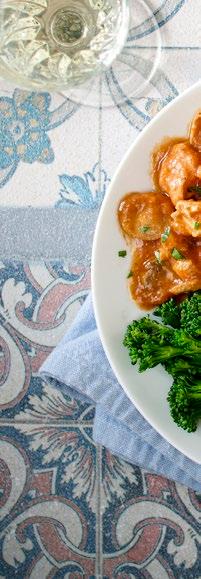

We deliver across the UK in just 2-3 working days
*Delivery charges apply. This offer is for new customers only. Offer is subject to change, Offer expires 28th February 2023. To order, shop online now at: parsleybox.com/RD23
Potato
Chicken Chasseur
Dauphinoise x2 x2
PLUS All the taste of a 4-hour slow-cooked meal with none of the effort






Rated “Excellent” based on over 30,000 reviews
“The meals are just so nice, my first thought when I tried my first meal, was of my grandmother - she always loved cooking on very slow open fire. Slow cooking seems to hold the taste so much better. I now buy in bulk so we always have meals on hand when time is short.” Mrs Tysall


Coq Au Vin Beef Bourguignon Beef & Mushroom Stroganoff x2 Serving suggestion Or call 0131 326 0131 Quote code RD23 Monday-Saturday 9am-6pm SLOW COOKED MEALS AND A BOTTLE OF WINE (375ml) EXCLUSIVE INTRODUCTORY OFFER ** 8 £34.99 SAVE 10%
Half Bottle of Cabernet Sauvignon x2 x2
GOWER PENINSULA My Britain:
Drive just half an hour away from the city of Swansea and you’ll find a slice of paradise: the Gower Peninsula.
Named the UK’s first Area of Outstanding Natural Beauty in 1956, Gower is known for its jaw-dropping coastline dotted with beaches, caves and bays. It’s also where the first human fossil in the world was found— the Red Lady of Paviland (although upon further investigation the remains were found to be male).
Nowadays, Gower is perhaps better known for stunning coastal walks and thrilling surfing opportunities. Further inland you can also find serene forest trails and rolling green hills. Wildlife abounds on land, sea and sky, including grazing sheep, playful seals and impressive peregrine falcons. We spoke to some of the residents of Gower Peninsula to see what life is like on this beautiful peninsula.
By Alice Gawthrop

Mucky Pu P Photogra P hy
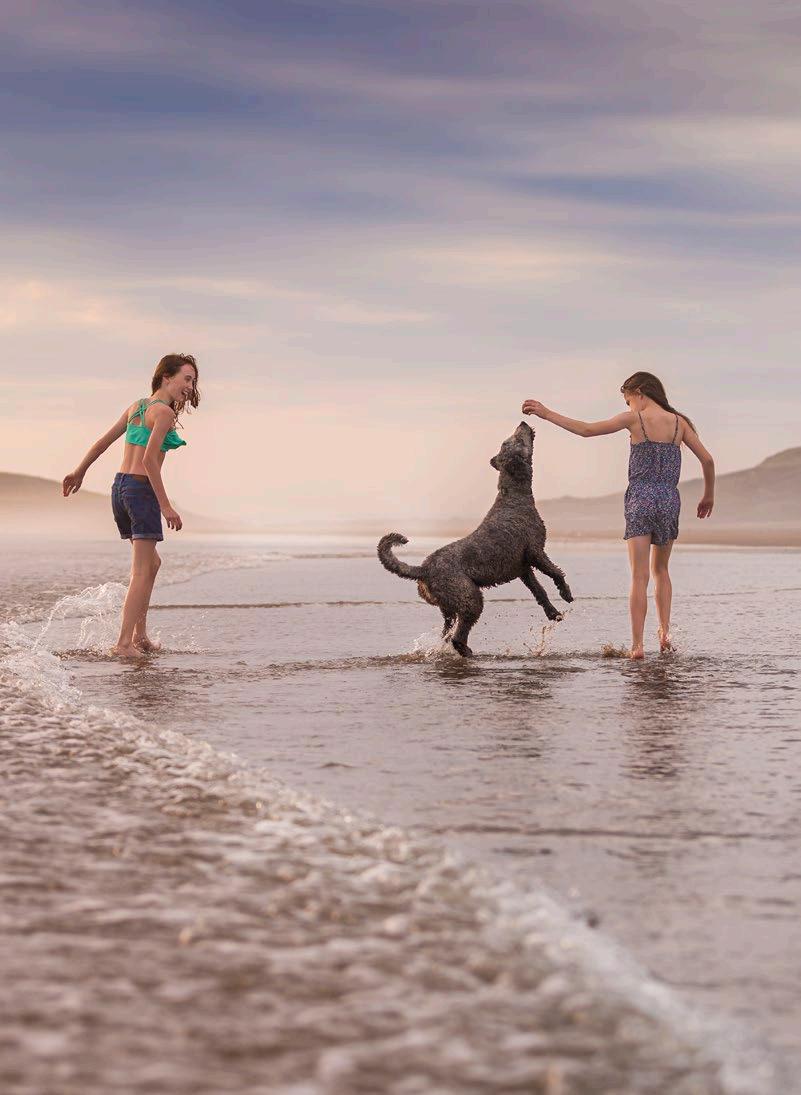
73
INSPIRE
Playing on Llangennith beach
JAY DOYLE
Jay, 51, is the founder of Earthly Rebels, a plant-based skincare and self-care range
earthlyrebels.co.uk
Iwas born in Three Crosses, a farming village at the north-east of the Peninsula. I spent my childhood there before moving away, returning to Swansea in my twenties. I now live near the Mumbles—the gateway to the Peninsula. I don’t intend to ever move away again!
I moved away from Gower as a child, after my parents separated. As soon as I became independent, I made my way back to Swansea, made new friends, discovered surfing, and spent all the time I could hanging out and camping at
Llangennith beach. It was heaven. Llangennith remains my favourite place to this day.
The Gower Peninsula is an incredible source of inspiration. My brand, Earthly Rebels, was inspired by the rugged coastline of Gower and its raw, natural energy. In fact, the tops of my handmade soaps are designed to reflect the undulating sand dunes at Llangennith, and I incorporate foraged ingredients such as seaweed and coastal gorse flowers into my lotions and potions.
At the risk of sounding a bit cheesy, the Gower Peninsula feels like being “home”. It just feels special, and I’m so lucky to live here. The Gower spirit is definitely something you feel; it’s a sense of community and connectedness between people. Lots of interesting, salt-of-the-earth kind of characters

MY BRITAIN: GOWER PENINSULA 74 • FEBRUARY 2023

who naturally share a passion for Gower and its way of life, or else they wouldn’t be here. And dogs! So many dogs! They say that Gower has the most dogs per head of population than any other place in the UK. I’m not sure if that’s true, but I can believe it! I love it.
Earthly Rebels is a passion project with two core elements: natural products and nature-based experiences. I make a plant-based skincare and self-care range with a beachy vibe. I also run experiences such as maker workshops, where I teach people to make their own products with ingredients they can grow or forage. It’s about shifting the lens on skincare, how we can see it as not just a product but a process, and an exciting adventure with nature.
I get to spend my time in or by the sea as part of my working day. When I’m struggling creatively or feeling a bit overwhelmed by it all, I go to the beach, walk the dog, surf, forage for seaweed, or just sit on a rock and meditate! It’s the best tonic, and also a really useful way to process problems and try to find answers.
My favourite spot is, literally, a precise spot. Its exact coordinates are in my logo. It’s a spot in the sand dunes at Llangennith. It’s my go-to place for breathing space and reflection. It’s the spot where the idea for Earthly Rebels came to me, while watching the surf. When I feel like Earthly Rebels (or life in general!) is going a bit off course, I go back to that spot, and it reminds me why I started out on this adventure. It’s kind of my North Star!
FEBRUARY 2023 • 75
SARAH JONES
Sarah, 38, is the owner of Mucky Pup Photography, a pet photography business muckypupphotography.co.uk
I’m originally from Aberdare in the South Wales Valleys, but moved to Swansea for university 20 years ago. After a few years, I took the opportunity to rent a converted stable on North Gower. I’ve always preferred the peace and harmony of a more rural life, and that’s exactly what living on Gower gives. After six years of renting I put down permanent roots and bought a house in a village on the North Gower coast. While I’m not Gower-born and bred, now that I’m here, I never want to leave!
Gower was the UK’s first designated Area of Outstanding Natural Beauty, and as a photographer who
showcases my subjects within the landscape, I couldn’t wish to live and work in a better place. From a photography point of view, Gower is an absolute dream—between the rugged coast line, the beautiful beaches, the pretty woodlands and the open commons, I’m really spoilt for choice when it comes to choosing where to take my dog models for their photoshoots.
I also love how steeped in history and myth Gower is. You don’t have to travel far to find a castle… or four!
Parts of the wooden carcass of the shipwrecked Helvetia, which ran aground in 1887, are still visible on Rhossili beach (it makes for an incredibly photogenic landmark). And going back to pre-historic times, there’s the skeletal remains of the Red Lady of Paviland and Arthur’s Stone, a neolithic burial tomb with a huge 25ton capstone, standing proud on Cefn Bryn Common.

76 • FEBRUARY 2023
MY BRITAIN: GOWER PENINSULA
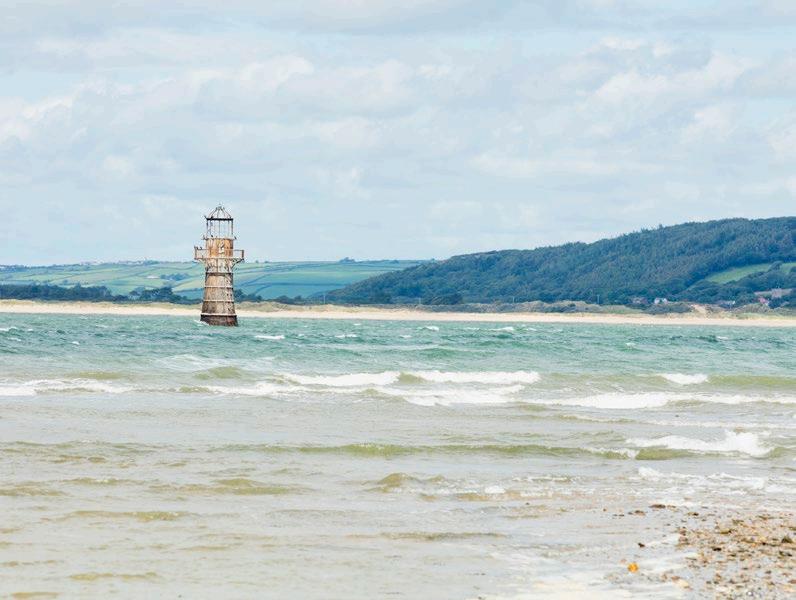
Living on the peninsula, it’s hard not to have a strong connection with the sea, and I feel that the Gower spirit is intrinsically connected to the ever-constant tide—resilience, hard work, dedication, creativity, endurance, always being there, and not forgetting the strong sense of community. To me, that is the Gower way.
If you’re privileged enough to share your heart and home with a hound, then you’ve experienced first hand the unique and pure joy of doginduced happiness. That’s why Mucky Pup Photography exists. I celebrate

dogs through photography; whether that’s out on location, or in the studio. I firmly believe that our dogs’ quirks need to be celebrated, and there’s no better way to do that than by immortalising them in print. Getting to hang out with amazing dogs and their people is what makes my work extra special. You can’t have a bad day if you’re with a dog!
FEBRUARY 2023 • 77
If I Ruled
The World
Tracy-Ann Oberman

Tracy Ann-Oberman is a British actor, playwright and narrator, widely known for her roles in EastEnders and Friday Night Dinner
I’d ban oranges, chips and burgers from public transport. No one would be allowed to peel an orange or eat chips or burgers on buses or trains. I don’t even mind an egg sandwich, but it’s chips, oranges and burgers that smell in enclosed spaces. I travel a lot for work and my heart just sinks when someone opens chips on a train. And oranges just linger! Nice if you’re eating them but horrible for anyone else.
Men on screen would have to have love interests their own age. Men would have to be paired up with
women their age, or ten years older or younger. I always remember the Golden Globes in 2014 when Tina Fey joked that the film Gravity was “the story of how George Clooney would rather float away into space and die than spend one more minute with a woman his own age.” That made me laugh so hard. I think the rule should be that on the whole men are paired with a love interest their age, or no more than a ten-year age gap either side. Sometimes you see a pairing and you think, Wow, that man is old enough to be her grandfather.
We would develop chocolate that is good for your health. We have all this amazing technology, so there must be a way of making chocolate that is good for you! That’s where the money should be going. Chocolate and cheese. We’ve got to find a way to make them one of your five-a-day.
78
• FEBRUARY 2023
© JOSEPH SINCLAIR
I would add British civil rights history to the school curriculum. For example, I would make the Battle of Cable Street part of the national curriculum. In 1936, in the East End of London, the British Union of Fascists led by Oswald Mosley marched against the Jewish working classes and they expected to bring all the other working class communities against them. Instead, they were faced with incredible solidarity among all the working class communities: the Irish, the Afro Caribbeans, the dockers, they all stood by their Jewish neighbours and wouldn’t let the fascists pass. I would include more of these positive, uplifting civil rights moments in the curriculum, as well as Britain’s own fascination with fascism.
I would make putting Christmas decorations out before December 3 illegal. Literally nothing to do with Christmas would be allowed until December 3, and then after New Year’s Eve it would be over. And you’re not allowed to mention Christmas outside of that time.
Bonfire Night would be the main event for autumn. I won’t criminalise Halloween, but I’ll hire a very strong media company to bring us back to Guy Fawkes Night and away from the consumerism of Halloween. It’s an American thing, God love them, but Bonfire Night is a bit more us—a hot
potato, a sparkler and fireworks in your neighbour’s garden. Halloween is just about money and frightening older people.
I would introduce two bank holidays a year for neighbourhood street parties. Everyone would have to get out of their houses and meet their neighbours. In cities, we tend to work hard and get entrenched in our own little worlds, and we don’t really know our neighbours. That feeling of community has gone. So we would have two designated days a year for street parties. Everyone would bring something to share, even if it was just a jug of water.
More debate would be encouraged. We’re living in a world where social media has made the understanding of history, politics and truth itself incredibly binary. You’re either with us or against us, you’re either good or evil. I would bring back the idea of nuance and the ability to debate, to read everything, to listen to somebody’s point of view and listen to the other side. n
AS TOLD TO ALICE GAWTHROP
Tracy-Ann Oberman stars in The Merchant of Venice 1936, playing Watford Palace Theatre (watfordpalacetheatre.co.uk) and HOME Manchester (homemcr.org) in March 2023, with further tour dates in the autumn
FEBRUARY 2023 • 79 INSPIRE
THE FUTURE OF

From self-driving cars to space travel, we answer five questions about where technology is heading
By Chris Stokel-Walker
80
INSPIRATION
illustrations by Tavis Coburn

very day, it seems, a new tech term pops up, leaving us non-techies asking questions in what sounds like a foreign language. “What is an NFT?” for example. And “Where, exactly, is the metaverse?” If you’re confused, you’re not alone.
While it might feel as if technology is speeding up, it follows a predictable formula called Moore’s Law, which has correctly predicted the pace of human advancements in technology for nearly six decades. Moore’s Law suggests that the number of transistors on a computer chip will double about every two years. This is a reliable indicator of how much and how quickly technology will change.
And while Moore’s Law has held true for all this time, it hasn’t stopped other key trends in tech from accelerating far faster than computer chips can keep pace.
From a new space race pitting billionaires like Elon Musk and Jeff Bezos against each other to big advancements in the artificial intelligence, or AI, that powers robots and self-driving cars, we will answer some crucial questions to clue you in to the future of tech.
WHEN WILL I HAVE A SELF-DRIVING CAR?
Like the jetpacks science-fiction writers have promised us since the 1920s, the vision of a self-driving car that whisks us to work while we read the news has proven to be more problematic in practice than in theory.
China hopes to increase sales of self-driving cars to 20% by 2030
So-called advanced driverassistance system (ADAS) features are available in some vehicles, such as Tesla’s electric cars, but they’re not what would be considered self-driving. Tesla’s autopilot tool can help you stay in your lane while driving on the highway, but it’s graded only a Level 2 on the five-stage system of automation developed by SAE
82 • FEBRUARY 2023 THE FUTURE OF TECH
QUESTION NO.1

International, a driving standards organisation. Level 5 would be a full self-driving experience with hands off the steering wheel. We aren’t there yet.
But in some countries, that future is getting closer. “If you look at China, the big cities like Shanghai and Shenzhen have self-driving cars doing passenger transportation,” says Ferdinand Dudenhöffer, director of the Centre for Automotive Research in Duisburg, Germany. The self-driving taxis, which are run by Chinese auto and tech giants, are part of a countrywide plan to increase the sales of Level 4 vehicles to around 20 per cent of the total by 2030 (Level 4 cars allow drivers
to switch off mentally while still requiring them to keep their hands on or near the steering wheel).
What works in China might not work elsewhere, admits Dudenhöffer—not least because of differing attitudes about how data should be used. Chinese citizens might accept having the journeys of their vehicles tracked and analysed to improve traffic flows, but people in other countries may be reluctant to agree to that tracking. Privacy concerns could stymie the promise of zoning out on your commute. Selfdriving cars must constantly generate data from their sensors and software to make driving decisions—otherwise they would crash.
FEBRUARY 2023 • 83
WHAT IS THE METAVERSE?
You’ve LikeLY been unable to avoid hearing talk of the metaverse lately. The term, first coined by sciencefiction author Neal Stephenson in his 1992 novel, Snow Crash, has become a vision of the future of technology in our lives. And if the hype is to be believed, it’s where we’ll be living the rest of our digital lives.
“The metaverse is a further convergence of our physical and digital lives,” says Cathy Hackl of Futures Intelligence Group, a consultancy. Put plainly, the metaverse is a virtual space that can be accessed through virtualreality goggles, adding elements of the digital on top of our day-to-day lives. You could attend concerts and conferences in the metaverse, staged in a three-dimensional digital representation of a nightclub or meeting room. Elsewhere, you’ll shop for shoes in a virtual store or order food in a virtual McDonald’s and have it delivered to your real-world home.

Facebook, which rebranded in 2021 as Meta in an indication of how strongly it believes in the future of the metaverse. Founder Mark Zuckerberg wants a billion of us to live, work and play in the metaverse by 2030.
You could order food in a virtual McDonald’s and have it delivered
But Hackl warns people not to view the social media giant as the centre of the metaverse. “It’s not just one company,” she says. “No single company can build it, either.” It’s also not enabled by one single technology, even though right now the way to “enter” the metaverse is to strap on a pair of virtual-reality goggles.
“It’s the future of the internet. But it’s also about further connectivity,” says Hackl.
So far, most of the attention around the metaverse has been focused on the company formerly known as
While the early advances may be made by Meta, the momentum will be picked up by other companies. And just because we have an idea of what the metaverse will look like now, it doesn’t mean that that’s what it will end up as, Hackl cautions. “The way I explain it is we’re on a high-speed train, destination metaverse,” she says. “We don’t know the stops, but we kind of know where we’re heading.”
84 • FEBRUARY 2023 THE FUTURE OF TECH
QUESTION NO.2

QUESTION NO.3
WILL ROBOTS TAKE MY JOB?
science-fiction noveLs often turn into a dystopian nightmare partway through—and for many workers, there’s a suspicion that the robot revolution story will end that way, too. By 2035, one in three jobs could be automated by robots, predicts PwC, a business consultancy.
“Robotics is traditionally applied to problems that fall into the categories ‘dirty,’ ‘dull,’ and ‘dangerous,’ ” says Jonathan Aitken, a robotics expert at the University of Sheffield. “Automation of a repetitive process is always achievable. The lack of variability means that the process is the same, time after time. This is the reason that robots fell naturally into automotive production.” That has been the case since the first robots appeared on production lines.
But it’s not just factory jobs that are feeling the squeeze from the rise of the robots. Professional roles are also affected, particularly those focused on data sorting, a task wellsuited for artificial intelligence. Financial services is one area that has turned to automated robots enacting trades. When a computer can pick stocks better and more quickly than a human, it makes sense to utilise them, and almost all investment firms do.
Jobs where workers are less likely to be replaced by robots include those in health care, although surgical robots (which are controlled by remote healthcare professionals in order to carry out more precise procedures) are already being used in hospitals. However, the gentle touch and caring reassurance of a well-trained nurse or doctor can’t be replicated by a robot.
“It’s important to ask whether we want robots doing certain jobs,” says Aitken. “In replacing a human, especially in a human-facing role, we’re being asked to accept the robot. This is something that will take time to achieve. People still like people.”
Surgical robots are already being used in hospitals
FEBRUARY 2023 • 85
QUESTION NO.4
WHAT IS AN NFT?
few things worth $44.2 billion are as misunderstood as NFTs, but then few things have captured the zeitgeist like they have. The letters stand for “non-fungible tokens,” which are oneof-a-kind digital objects that can’t be exchanged for each other or copied, thanks to their encryption.
“What most people see as an NFT is art,” says Nick Donarski, founder of ORE System, a company that deals in NFT technology. For example, instead of owning a physical painting, you could buy ownership of an NFT, an original piece of digital art. Some of the world’s biggest celebrities, including Gwyneth Paltrow, Madonna, and Justin Bieber, proudly show off their NFT collections.
Celebrities have often spent hundreds of thousands of dollars to buy the right to an NFT from collections with themes such as bored apes and pixellated punks.
But despite the big-name endorsements, NFTs have faced a wave of criticism. They have ended up being stolen or found to be using images that don’t legally belong to the artists behind them. Other NFT projects have been uncovered as get-rich-quick scams for the creators, while those who own the artwork are the ones who lose out.

If NFTs can overcome the bumps and bruises of their early negative publicity, they could become a commonly used bit of technology. The key word is “if.”
QUESTION NO.5
WHAT’S NEXT IN SPACE TRAVEL?
fiftY Years ago, astronauts travelled to space in rockets designed, built, and maintained by NASA and paid for by government funding. But today, the astronauts are very often billionaires enjoying a journey into low orbit on a rocket that they paid for themselves.
86 • FEBRUARY 2023 THE FUTURE OF TECH

“We want to go back to the moon to live and work there”
Some see the moon as the staging area for deep-space exploration
And as private companies learn more about putting rockets and satellites into space, they’re able to help the likes of NASA on their missions. That’s important because NASA itself has become financially constrained. From its 1966 peak, where spending on the space race took up more than four per cent of the US government’s budget, that spending is now less than a half per cent of the country’s total budget.
This change feels like a giant leap, but it makes sense, says Laura Seward Forczyk, founder of Astralytical, a space consulting company. “More and more of modern civilisation relies on space,” she says.
Huge numbers of satellites orbit the planet, connecting us to everything from mobile phones to GPS to Netflix, and there is big money in maintaining those systems. “This doesn’t get a lot of headlines typically, but there are profit reasons why private companies want to go into space,” says Forczyk.
“ NASA is using commercial companies to build a lot of the hardware to do those services of taking scientific payloads to the surface of the moon,” says Forczyk. The hope is that people will follow—possibly by 2025, but more realistically, says Forczyk, by 2030. If you’re wondering why we’re going back to the moon—after all, mankind has already walked its surface—the answer is that we explored only part of it.
“We know a lot more, but we also know so very little,” says Forczyk. “We want to go back with people to learn more, but more importantly, we want to go back to live and work there.”
Some even see the moon as an eventual staging area for human exploration of deep space. Mars is regarded as the next stepping-off point towards the final frontier— though whether we’ll get there in our lifetime is another question. n
FEBRUARY 2023 • 87 READER’S DIGEST

WIN a Relaxation Day for two at the award-winning Ragdale Hall Spa
Ragdale Hall Spa, voted ‘Best Spa for Guest Experience’ at the Good Spa Awards 2022, is offering the chance for some well-deserved ‘You-Time’ for one lucky winner and their guest.
Enjoy a blissful spa day experience with full use of all facilities including 6 unique pools, a Thermal Spa with 11 heat and water experiences, fitness classes plus a three-course delicious lunch and a 40-minute treatment.
Ragdale Hall Spa is located in the beautiful Leicestershire countryside, which combines state-of-the-art facilities with the charm of traditional Victorian architecture to create one of the most luxurious spas in the country.
Which award were Ragdale Hall Spa, voted ‘Best Spa for Guest Experience’?
A. Good Spa Awards 2022
B. Sauna Awards
C. Leisure Awards
Simply answer A, B or C on the entry form or enter online. See page 151.

If you're not the lucky winner on this occasion, Ragdale Hall Spa gift vouchers are the perfect way to spend quality time together. Give the gift of relaxation and reconnect with those you love. Gift vouchers start from just £25 and are also available as an E-Voucher. For more information visit www.ragdalehall.co.uk or call 01664 433030. www . ragdalehall . co . uk

T&C’s: The prize is available for over 16s only. Travel is not included. The prize is valid for 8 months from the date the winner is notified, subject to availability. Arrival from 8.30am, departure 6.00pm. Prize valid Monday to Thursday.For more information visit www.ragdalehall.co.uk or call 01664 433030.
COMPETITIONS 88 • FEBRUARY 2023


TEMPLESPA is a British skincare brand with a Mediterranean soul and we have a £200 voucher to giveaway!
FIND WORDS OF THREE OR MORE LETTERS, AND ALL MUST CONTAIN THE CENTRAL LETTER.
TARGET:
Excellent: 20 or more words. Good: 15 words. Fair: 15 words.
There is one word relating to a special date in February which uses all the letters – write this word on your entry form or enter online. See page 151. Their outstanding award-winning products are the perfect blend of derma-science and botanicals. They use cutting edge technology to create highly innovative products that look after your mind, body and soul. For more, go to www.templespa.com play the february wordwheel A £200 voucher WIN! N L I E V A E N T
89
COMPETITIONS
OF BOUNDS OUT
MARK GAYOWSKI TOOK AN UNMARKED SKI TRAIL INTO A DEEP RAVINE. EVERY ATTEMPT AT ESCAPE ONLY LEFT HIM MORE LOST
 by Brett Popplewell
photographs by kari medig
by Brett Popplewell
photographs by kari medig
INSPIRATION 90

91
Gayowski has been skiing Red Mountain since he was a kid
Mark Gayowski was determined to squeeze as much fun as he could out of the last days of the year.
Shortly after 9am on December 30, 2019, the 34-yearold carpenter from Rossland in the west Canadian province of British Columbia said goodbye to his housemate and headed to nearby Red Mountain, one of North America’s oldest ski resorts. He planned to ski all morning, and then in the afternoon he'd watch the latest Star Wars movie with a friend.
Gayowski had spent his youth at the ski resort; its three peaks towered over the town. He knew the 119 ski runs as well as anyone, but the challenge of the routes that weren’t marked on the trail maps—the “back country” skiing—appealed to him the most.
By 10am he had headed up the mountain and pushed off for the first run of the day. For two hours, he cut tracks all over the mountainside. Then he got on the lift for one last ride up.
The chairlift hummed as it ferried him to the resort’s easterly peak. Gayowski pulled out his phone and called his mother, Cindy Reich.
Reich, a 56-year-old retired figureskating coach, lived in Rossland with Gayowski’s stepfather, Raymond. She and her son spoke nearly every day. He told her how he’d spotted what
looked like untouched powder on the far side of the 6,807-feet-high mountain. He planned to follow it for a few minutes, then return to a run lower down the mountain and ski back down to the car park.
She listened, then wandered to a whiteboard in her kitchen and pulled out a marker. After suffering a concussion in a bike crash four years earlier, she didn't trust her memory. Reich wrote the name of the trail and peak on the whiteboard: “Left of Unknown Legend, Kirkup side.” She asked him to call or text her when he finished the run.
“I will,” he replied. Then he put his phone back in his pocket, slipped on his gloves, got off the chairlift, and began gliding along the left side of a steep trail for experienced skiers, looking for the ideal point to dip into the trees.
He found his spot alongside fresh ski tracks next to an out-of-bounds sign. He ducked under the rope barrier, lowered his goggles and snaked his way through the alders and pines, dodging cliffs and boulders and descending deeper and deeper into a ravine. It took a while for him to realise that he may have overshot his planned exit. Then the snow beneath his skis grew thin and the brush thicker. Soon there was no way for him to ski around the logs and downed branches that boxed him in.
Gayowski slid to a stop and took a look around. He’d lost the fresh ski
92 • FEBRUARY 2023 OUT OF BOUNDS
Skiers go missing on Red Mountain every year

tracks he’d started with almost as soon as he’d gone into the bush. In fact, he’d veered so far off-course that he was stuck almost 5,000 feet into a ravine, with no easily discernible exit. He pulled out his phone but there was no service. He clicked out of his skis and looked back up the mountain. The climb was too daunting.
He could feel the weather starting to change as he slowly made his way down deeper into the ravine. The winds were picking up and clouds gathered overhead. Then snow began to fall. He didn’t yet realise how much trouble he was in.
Reich wondeRed why her son hadn’t texted or called when he’d finished his run. She credited it to forgetfulness, but as the hours passed and he failed to reply to her half-dozen texts, she began to worry. She called him but
got his voicemail. She knew he’d been planning to meet a friend that afternoon for a film, so she reassured herself that he’d turned the phone off and was sitting in a theatre. At 5pm, when she still couldn’t reach him, she drove to her son’s apartment to make sure he’d made it off the mountain.
Gayowski’s housemate was also perplexed when Reich knocked on the door—he’d received a call from Gayowski’s friend earlier that afternoon, when he didn’t show up at the theatre to catch the film. It wasn’t like Gayowski to just disappear unannounced. Outside, it was -3°C and already dark. Reich began to panic and called her husband. She and Raymond agreed: it was time to call for help.
While they waited for the search and rescue teams to arrive, Raymond and a group of Gayowski’s friends
FEBRUARY 2023 • 93
raced around the base of the mountain on their snowmobiles, looking for him. But it was too dark, and the snowfall was too heavy; they gave up and planned to return the next morning.
Mike Hudson, a 41-year-old heavy equipment operator and a volunteer search-and-rescue manager in the neighbouring village of Fruitvale, was just starting to unwind for the evening when his phone buzzed. It was a call from the Emergency Coordination Centre, asking if he could lead a mission to find a missing skier. They had information about where he’d planned to ski. The case was urgent: over three feet of snow would fall on
GAYOWSKI WORE A THIN JACKET. HE KNEW HE HAD TO KEEP MOVING OR RISK HYPOTHERMIA
the area over the next 48 hours.
Early on the morning of December 31, Hudson arrived at the mountain with a unit command centre—a 26-foot-long cargo trailer with multiple work terminals to log radio transmissions, document clues and coordinate the movements of rescuers. The terminals connected to a larger screen used primarily for viewing topographical maps.
Then word came down from the top of the mountain. There had been a positive sighting of what were believed to be Gayowski’s initial tracks heading out of bounds, more or less where he had told his mother he planned to ski. They were disappearing fast beneath the falling snow.
duRing his fiRst 12 houRs in the ravine, Gayowski wandered deeper, reaching a creek that he assumed would ultimately take him to a roadway. His phone battery died, and he’d abandoned his skis three hours into the ordeal.
He’d travelled roughly two-and-ahalf miles on foot but wasn’t sure how far he was from civilisation. The ruggedness of the forest around the creek’s shoreline forced him to cross the stream; it was the only way to keep moving forward. He had to wade shin-deep through the water. The temperature hovered below freezing, and his feet and legs were soaked.
Gayowski was hardened to the cold, having spent eight years building pipelines in northern Canada. But he’d dressed lightly that day in a GoreTex jacket. He knew he had to keep moving or risk hypothermia. He was parched from exertion but also knew he couldn’t consume snow to rehydrate, as it would lower his core temperature even further.
By 2am on December 31, after he’d followed the creek for what felt like forever, Gayowski gave up any hope of
94 • FEBRUARY 2023 OUT OF BOUNDS

finding his way out of the ravine by pushing forward. He decided that the only way to get out was to turn around, retrace his steps and head back up the ravine toward the peak. Through the night he climbed. When daylight broke, he saw that the falling snow was filling in his tracks. He quickened his pace, but it didn’t matter. By mid-morning they’d disappeared. Gayowski was so disoriented that he was no longer sure if he was really making progress up the steep incline.
He threw away his soaking gloves and pulled his numb hands inside his coat for warmth. By late afternoon, his legs were beginning to give out on him, his feet blistering after more than 30 hours of hard trekking in ski boots.
Gayowski’s mind had been playing tricks on him for hours, filling his head with visions and sounds of

salvation—a building, a person, a shadow. It was never anything more than a tree or a boulder. Exhausted and defeated, he pulled off his jacket, lay down in the snow and waited for his breathing to slow and his body to freeze.
hudson had dispatched two teams of four rescuers into the ravine at 7am on December 31. One team descended from the top of the mountain, trying to mimic Gayowski’s initial downhill trajectory, while the second team moved in on snowshoes and trail skis from the mountain’s base, navigating their way along the creek.
Hudson had started the day feeling optimistic because he had a general sense of where Gayowski was. But as the hours slipped by, it became clear that none of his rescuers were going to be able to penetrate deep enough into the ravine to actually locate him.
PHOTO LEFT COURTESY OF MIKE HUDSON
FEBRUARY 2023 • 95
(Left) Mike Hudson in the rescue command centre; (Above) A rescuer searching for Gayowski
As daylight began to fade, the chances of Gayowski’s surviving a second night alone on the mountain were grim. Hudson looked over at Gayowski’s mother and stepfather, who had joined him at the command centre that afternoon. He told them what they didn’t want to hear: that the day’s search was coming to an end. The conditions were just too difficult to navigate.
Cindy and Raymond nodded silently; they could see how hard
GAYOWSKI WOKE UP. IT WAS NEW YEAR’S DAY. HE WAS STILL LOST, BUT GRATEFUL TO BE ALIVE
Hudson’s team had been working in the ravine to locate their son. They left the command centre and started for home.
Hudson looked at weather patterns for the coming day. He could see that the storm should be gone by morning. But he also knew that there was only a 30 per cent chance that Gayowski would survive the night.
thoughts of not wanting to leave his parents broken-hearted compelled Gayowski to open his eyes, brush the snow from his body and pull his jacket back over his torso.
The darkness was setting in again. He needed to keep moving. He had no idea how far he’d climbed or how much further there was to go, so he gave up and, thinking it’d be easier than more climbing, began to once again head back down into the ravine.
For another eight hours, he descended in the dark and arrived back at the creek, where the snow was wet and thick. New Year’s Eve came and went. By 2am he was completely depleted. He hunkered down under a thick tree, pulled his arms inside the body of his jacket and tucked his head beneath his collar to warm himself with his breath. Then he lay on a log and tried to sleep.
At daybreak, Hudson returned to the command centre to prepare his teams for another push. This time, a group of three would follow a ridgeline until they were about midway up the mountain and then veer right into the ravine. All the while, another group waited next to a campfire on the gravel road near the creek’s exit, just in case Gayowski came close enough to smell or see the smoke. Gayowski’s friends continued to run their snowmobiles back and forth along the road, hoping he might hear them and find his way out.
As Gayowski’s parents sat at home, feelings of helplessness gave way to hopelessness. Cindy Reich had spent much of the night updating Gayowski’s sister, Ayla, who was returning from a holiday in Mexico.
96 • FEBRUARY 2023 OUT OF BOUNDS
The phone rang. No news. It was only a member of Hudson’s team asking Reich to describe specific details about her son’s appearance— tattoos, scars, missing teeth. It wasn’t until she hung up the phone that she realised why they might need to know.
sunlight filteRed through the trees in the ravine. Gayowski poked his head out from inside his jacket and looked up into the sky. It was New Year’s Day. Though he was still lost, he was grateful to be alive. He sat upright on the log and wiggled his toes inside his ski boots. His feet and legs ached.
For the next four hours, he struggled to move forward through knee-deep snow. He had to wrap his hands around his thighs and use them to lift his legs. At some point, he stopped and screamed out in anger. It took a few moments for him to realise that the shouts coming back in his direction weren’t just an echo. Then he saw three figures on skis in the distance, closing in fast. He wanted to run towards them, but it was taking almost all of his energy just to stand. He could hear them yelling out his name. He was in tears by the time they reached him.
the phone Rang. Reich picked up, listened to the words coming out of the receiver, and shouted to her husband.
“They found him!”
Minutes later, she was back at the mountain, flanked by Raymond and Ayla, listening to a radio crackling with her son’s location as the rescue team made their way with him to a small clearing where a helicopter could touch down. It felt like forever before they heard the helicopter cutting through the sky over their heads. They stepped outside and ran toward it, catching Gayowski moments after he stepped out on his own two feet.
For the next three days, his family kept vigil by his hospital bed. He’d suffered tissue damage to his feet and muscle fatigue. After leaving the hospital, he convalesced at his mother’s home for two weeks.
A year later, he realises that he could have died alone in the snow if he hadn’t thought to call his mother from the ski lift to let her know about his plans. And if he hadn’t kept himself moving, climbing up and down the mountain, he would certainly have died of the cold.
His skis are still out there. “I know where they are,” he says. “But I’m not going back for them.”
If ever he ventures back into that ravine, it will be as a rescuer. Before the pandemic hit, he attended meetings to join a search-and-rescue squad. The next time someone is lost and alone in the bush, he plans to be part of the team that sets out to save them. n
FEBRUARY 2023 • 97 READER’S DIGEST

Ihor Kozhan, director of the Andrey Sheptytsky National Museum, with some of the precious Bohorodchany Iconostasis panels he’s desperately trying to save
INSPIRATION
photo: Kasia stre K

SAVING UKRAINE’S SACRED ART
A 300-year-old masterpiece has withstood religious persecution and world wars. Can it survive Russia’s brutal assault?
By Joshua Hammer From smithsonian
99
magazine
Iarrived in Lviv on a cold, clear morning in March, four weeks after the Russian invasion. A jewel of cobblestone alleys, Hapsburgera palaces and squares, and churches dating to the Middle Ages, western Ukraine’s largest city possessed a veneer of calm. But as I strolled in Rynok Square, an air-raid siren shattered the hubbub of street musicians and café-goers, sending many pedestrians scurrying into shelters. On this day no attack came.
IN A GENRE KNOWN FOR ITS DAZZLING OPULENCE, THE ICONOSTASIS STANDS BY ITSELF
The Andrey Sheptytsky National Museum in Lviv had been closed since the first day of the war. By a side entrance of the opulent former villa, I met Ihor Kozhan, its director. A short, burly man in his late sixties with a kindly visage, Kozhan led me through the museum’s deserted atrium and into an exhibition hall that had been stripped bare. “This room was filled with religious icons,” he told me, pointing out many rows of white display cabinets, now
containing nothing more than bare brass mounts.
On February 24, Kozhan awakened to the news of the Russian invasion. “Western countries had been claiming that troops were massing, but our government insisted that nothing was going to happen,” he told me as we strolled through empty galleries. “We had no plan.” Blindsided, Kozhan told his wife and daughter to stay safe, then he steeled himself and went to work. His first decision, a difficult one, was to close the museum. Then Kozhan and his employees met to formulate a strategy to protect its 1,800 objects on display—Ukrainian modern art, illuminated manuscripts and sacred icons spanning 800 years. Kozhan was particularly concerned about the pride of the collection, regarded by many scholars as the greatest example of Baroque-era religious art in central Europe: the Bohorodchany Iconostasis.
For more than two centuries the enormous, elaborate wooden altarpiece had been caught up in the region’s invasions and conflicts. Over the years it had been hastily disassembled and transported to safety, claimed as a spoil of war, tossed aside and left to rot. It had finally settled into a gallery of its own at the Andrey Sheptytsky National Museum nine years earlier. Now it was threatened once again.
100 • FEBRUARY 2023 SAVING UKRAINE’S SACRED ART

After Russia invaded, the race was on to protect the Bohorodchany Iconostasis
Even in a genre known for its dazzling opulence, the Bohorodchany Iconostasis stands by itself. Created between 1698 and 1705 by the monk and painter Yov Kondzelevych and at least 20 artisans, the iconostasis is a 13-metre-high, 11-metre-wide wall of gilded icons and other religious scenes, set in ornate wooden frames and crowned by a huge gold depiction of the Crucifixion.
The naturalism of Kondzelevych’s images, with their vibrant colours and the individualised facial expressions of the figures, marked a dramatic departure from the formalised Byzantine art that shaped Ukrainian iconography through the 17th century. The masterpiece helped to forge a distinct Ukrainian identity,
separate from that of Russia, its giant neighbour to the east.
For Kozhan, the realistic depictions of human beings, so different from the “very still, very stiff” style of Russian sacred art, is captured by the nickname affectionately bestowed on Kondzelevych by art historians: “The Ukrainian Raphael.”
The artist was born in Zhovkva, a centre of painting and wood carving located 19 miles north of Lviv, in 1667. At 19, he entered a nearby monastery. Not much is known about his life, but he is thought to have fallen under the tutelage of the great Baroque icon painter Ivan Rutkovych, who kept a studio in Zhovkva. Rutkovych’s masterpiece, the Zhovkva Iconostasis, also hung in the Andrey Sheptytsky National
p hoto: m y K ola s warny K FEBRUARY 2023 • 101
Museum until it was removed only earlier this year.
In 1698, Kondzelevych received a commission from the Manyava Orthodox Monastery, the dominant hermitage in what was then Polish Galicia, to create the Bohorodchany Iconostasis. Kondzelevych assembled carpenters, joiners, goldsmiths and other artisans, and established a workshop in the foothills of the Carpathian Mountains. He remained there with his team for seven years.
KOZHAN FILLED THE MUSEUM WITH ARTWORKS THAT HAD BEEN MOULDERING IN STORAGE
The Bohorodchany Iconostasis hung originally at the Manyava Monastery, but in 1782, a decade after Austria-Hungary annexed the region, the Hapsburg Emperor Joseph II ordered the monasteries throughout the empire to shut down and appropriated their land. Three years later, the community of Bohorodchany, 16 miles to the north, paid the equivalent of about £10 for the giant altarpiece. It was moved to the town’s Ukrainian Greek Catholic Church of the Holy Trinity.
The iconostasis was still hanging in Bohorodchany when, in August
1914, weeks after the start of the First World War, the army of Tsar Nicholas II launched a massive assault on Galicia, setting off a panicked exodus. The Hapsburg army made three futile counteroffensives against the Russians in the Carpathian Mountains. The casualties on both sides numbered over a million men.
Amid the chaos and extreme violence, Austro-Hungarian troops risked their lives to save the obscure religious icon. Riding into Bohorodchany one night, perilously close to the front lines, “the soldiers began to dismantle the iconostasis and pack it—to the joyful surprise of the residents,” wrote one witness. The soldiers, assisted by locals, loaded the parts onto trucks and transported them to a museum in Vienna.
After its defeat in the First World War, Austria-Hungary surrendered the iconostasis to Poland, and it hung in the Royal Castle in Warsaw. In 1924, Andrey Sheptytsky (after whom the National Museum in Lviv is named), a leader of Lviv’s Greek Catholic Church and a Ukrainian nationalist, bought the iconostasis for the equivalent of around £3,300. He displayed parts of it in a museum dedicated to Ukrainian iconography that he had founded on Lviv’s Drahomanov Street.
Still, the artwork’s trials weren’t over. In 1939, the Soviet Union occupied the region and held it until the Nazis invaded two years later. In
102 • FEBRUARY 2023 SAVING UKRAINE’S SACRED ART
1944, the Soviets seized control of the region again, merging parts of Galicia with present-day eastern Ukraine, greatly expanding the size of the Ukrainian Soviet Socialist Republic.
Joseph Stalin’s commissars shut down churches, destroyed icons and dismantled the Bohorodchany Iconostasis. They hung one of its 50 panels in a folklore museum and warehoused the rest in Lviv’s shuttered 14th-century Armenian Cathedral, which was allowed to slowly fall apart. And there it remained until the dissolution of the Soviet Union.
Ukraine gained its independence in 1991, but its national identity is still evolving. The Ukrainianspeaking region once known as Galicia, in the west, developed a culture that was distinct from the rest of the country, which was ruled by Imperial Russia from the 18th to the early 20th century. Ukraine’s suffering under Stalin, the country’s experiment with democracy and Vladimir Putin’s violent meddling have all strengthened a sense of national solidarity.
Another thing that binds east and west is art, especially now, with Ukrainians determined to protect their cultural legacy from destruction by Russian troops. Liliya Onyshchenko-Shvets, the director of Lviv’s cultural heritage office, initiated an online data bank that allows
museum directors across Ukraine to report war damage and identify their needs. “We have 2,000 wooden churches, many on the Unesco heritage list,” she told me. All are considered highly vulnerable.
Kozhan’s own life story reflects his devotion to Ukrainian culture. He was born in Lviv in 1953, the son of Ukrainian nationalists. At Ivano Franko University in Lviv, he associated with fellow activists who revered the poet, writer and artist Taras Shevchenko, who agitated for Ukrainian independence in the 1840s.
In 1973, the KGB ordered Kozhan’s expulsion from the university, along with seven faculty members and 19 other students. He served in the Soviet army, then earned his degree elsewhere in Ukraine and went to work for the National Museum, which was dedicated to displays of Soviet folklore as well as arts and crafts.
In 1991, the Soviet Union collapsed. The incoming local Ukrainian government designated the Hapsburg-era villa, then housing the city’s Lenin Museum, as the new home of the Andrey Sheptytsky National Museum, and named Kozhan as the director.
“I got a phone call from the city council,” he recalled. “They said, ‘Liquidate the Lenin Museum.’”
On our way down to his office, he pointed out the window to a dingy courtyard where a bust of Lenin still lay discarded.
FEBRUARY 2023 • 103 READER’S DIGEST


Kozhan filled the halls with Ukrainian artworks that had been mouldering in storage. But it wasn’t until 1997 that restorers began to prepare all 50 panels of the Bohorodchany Iconostasis for public viewing. “It was serious work,” Taras Otkovych, director of the restoration team, told me.
Neglected for decades, the paintings were covered with grime. Old varnish needed to be stripped away; misguided restorers a century earlier had painted over many icons. Otkovych’s team conducted chemical analyses, X-rayed the paintings to determine the look of the original layers, and used cotton swabs and gentle emulsion cleaners to remove dirt and varnish. In 2013, the entire Bohorodchany Iconostasis was put on display for the first time in a century.
This past March, Kozhan supervised the dismantling of the iconostasis for the seventh time in its history. Twelve museum workers toiled for four days, removing the ingenious wooden joints that had locked the icons to their frames, then carefully separating the giant panels into dozens of parts. Kozhan held up several of the crude-but-effective locking mechanisms. “Every piece was linked,” he told me.
Kozhan agreed to let me visit the secret storage place of the iconostasis on the condition that I revealed no details that could give it away. The next day, an aide in Lviv led me to a basement. There, I set eyes on hundreds of icons and other treasures. Parts of the Bohorodchany Iconostasis were stacked together without wrapping.
p hotos: Kasia stre K 104 • FEBRUARY 2023
Bishop Ioasaf Vasylkyv hopes the Bohorodchany Iconostasis will eventually be returned to its original home—the Manyava Monastery in the Carpathian Mountains
Kozhan was confident that they’d be well protected, though he’d reached out to colleagues in Poland to make contingency plans.
“Putin’s idea of this war is to destroy Ukrainian nationality, and our task at the museum is to preserve it,” he told me.
The Manyava Monastery, where the astonishing artwork was created, lies in the foothills of the Carpathian Mountains, 109 miles south of Lviv. The hermitage is a stone-walled compound overlooking a riverine gorge and pine-covered hills. As I walked through the gate, I took in the peacock-blue-and-golden onion domes rising from churches, a bell tower and a four-storey library.
In the nave of a wooden church topped by three pyramidal tiled roofs stood a replica of the Bohorodchany Iconostasis. The replica was created after the monastery reopened in 1998, following the monastery’s closure of more than 200 years.
Even without having seen the original, except in pieces, I could easily discern that this iconostasis was an inexpert knockoff: the depictions of Jesus, Mary and the saints were less realistic and the tableau lacked depth and richness of colour.
“The artists studied the original and tried to copy it,” said Ioasaf Stasiuk, Manyava’s 23-year-old deputy bishop, a cherubic-looking
man wearing a brown robe, his hair pulled back into a ponytail.
During shelling in the First World War, the original wooden church burned down. Ioasaf Vasylkyv, 67, the monastery’s grey-bearded bishop, led me down the main path through the monastery, pointing out fragments of the original structures—the base of the outer wall, the bell-tower archway, the bottom floor of the library tower.
With donations and God’s support, he said, he had put Manyava back together and given it a future again. The monastery has reclaimed its place as one of the holiest Eastern Orthodox sites in the region, drawing thousands of pilgrims every year.
Vasylkyv had two wishes, he said. The first was for the return to the Manyava monastery of the original Bohorodchany Iconostasis, a prospect that seemed unlikely. Kozhan has said as much. “The general principle is that what goes into the museum doesn’t come out,” he told me earlier.
But the bishop’s second wish seemed more attainable, if far from certain: a Ukrainian victory in this latest catastrophic and horrific war. “I hope you have good health,” he said, escorting me out through the monastery’s front gate. “And may the Russian president and the Russian Army never enter here.”n © copyright 2022 smithsonian institution. reprinted with permission From smithsonian enterprises. all rights reserved. reproduction in any medium is strictly prohibited without permission From smithsonian magazine
FEBRUARY 2023 • 105 READER’S DIGEST
Buy a subscription for you or as a gift today
A magazine subscription makes the perfect gift – it’s the gift that keeps on giving the whole year through
Reader's Digest magazine is bursting with stories, news, advice, recipes, reviews, tips, jokes and anecdotes. Each issue is also packed full of puzzles and competitions offering you chances to win some great prizes. Why subscribe to Reader’s Digest?
SUBSCRIBE TODAY FROM AS LITTLE AS £22.99
Claim immediate subscriber benefits including:
Discounted travel club offers with Tripbeat - save up to 60% off 600,000 hotels worldwide, plus preferential rates on flights, car hire, activities and more.
FREE access to online events & classes with Mirthy with access to 80+ events per month, from talks to creative workshops, dance & fitness classes and more. ALL OF THIS FROM ONLY £22.99 - OUR BEST VALUE YET



It’s only £22.99 for a full one-year subscription paid by direct debit. A Saving of over 50% OFF the usual £47.88 retail price - and what’s more, we will deliver it direct to your or gift recipient’s door every month for free!
SUBSCRIPTION OFFER
+


YES I want to subscribe to Reader’s Digest Magazine for just £22.99 for 12 issues (a saving of £24.89 on the shop price of £47.88). I understand I can cancel my subscription at any time by contacting customer services. If I want to continue to subscribe after my first 12 issues I need do nothing and my subscription will automatically be renewed at the low rate of £24.99 every 12 issues until I decide otherwise.
Name:
Address:
INSTRUCTIONS TO YOUR BANK OR BUILDING SOCIETY TO PAY BY DIRECT DEBIT. Originators reference: 400162
Please complete direct debit mandate below

Name of Bank ......................................................................
Account Holder
Branch: / /
Account No
Instructions to your bank or Building Society: Pay Reader’s Digest Direct Debits from the account detailed on this instruction subject to the safeguards assured by the Direct Debit Guarantee. I understand that this instruction may remain with Reader’s Digest and if so will be passed electronically to my Bank or Building Society.
Signature .....................................................................
Date ..............................................................................
Postcode:
Sort Code Data Protection: From time to time Reader’s Digest may contact you with details of its products and services. Please tick here
to receiving such information Return your completed form to: Reader’s Digest, The Maltings, West Street, Bourne PE10 9PH Or call us today on 0330 333 2220 Quoting code MAGFEB23 Today www.readersdigest.co.uk/subscribe SUBSCRIBE
Telephone: Email:
if you object

Breaking Into Alcatraz My Great Escape:
Our reader Maggie Cobbett makes a break for the infamous island prison…

It’s ironic that the highlight of my great escape to the beautiful city of San Francisco was a visit to Alcatraz. Although it closed as a federal prison in 1963, the mystique lingers on. The island, always windy and often foggy, has attracted many thousands of visitors since it opened to the public ten years later.
Once the most famous prison in the United States, it housed the “incorrigibles”, its most hardened career criminals, in cramped chilly cells. Among those subject to an unbending regime, designed not to rehabilitate but to break them, were Al “Scarface” Capone, George “Machine Gun” Kelly and Robert “the Birdman” Stroud.

108 POWERED BY
We took a ten-minute boat ride from Pier 41 and made a beeline for the massive concrete cell house as soon as we landed. It stands on a plateau at the highest point of the island and looked forbidding even on that sunny day. The air was full of the squawks of the large array of sea birds who inhabit the island, even though it has no natural water supply.
Following the self-guided audio tour was fascinating. The standard cells were stark enough, but the “dark cells”—bare and blacked-out, and used to punish misbehaviour— were grim indeed. Tear gas cylinders suspended from the ceiling once discouraged riots in the dining room.
The view of San Francisco’s skyline from the recreation yard must have been almost too tantalising to bear. So close and yet so far away! There was no shortage of escape attempts, but it’s believed that only three fugitives ever made it to freedom across the choppy waters of the Bay.
Many former inmates and correctional officers have written about their experiences on “the Rock”, and we heard with amusement of book signings and even reunion sleepovers decades after the last prisoners were shipped out. Only in America! n
Tell us about your favourite holiday (send a photo too) and if we print it, we’ll pay £50. Email excerpts@readersdigest.co.uk

SUBSCRIBER BENEFIT:
Exclusive travel discounts with Tripbeat

See page 106 for details
109
TRAVEL & ADVENTURE

BORROMINI’S Perspective ROME
Chances are that if you have heard of Palazzo Spada, it’s thanks to an art gallery championing the likes of Rubens, Caravaggio and Titian.
But there’s a far more beguiling reason to visit this impressive Centro Storico palace. On its first floor, find a peaceful orange-tree courtyard and look down the colonnaded gallery, whose distant statue of Mars is about 35 metres away.
Except it isn’t. In fact, the passage is actually only eight metres long, and its god of war just 60 piffling centimetres high. Not that you’ll believe it until stepping forward.
Enabled by a rising floor, a descending ceiling and shrinking lateral columns—part of a wider technique known as “forced perspective”—this optical illusion was conceived in 1635 by one Francesco Borromini. Upon commissioning the architect, Cardinal Spada asked that his flamboyant stucco property be redesigned to look bigger; in cahoots with Giovanni Maria da Bitonto, a monk and mathematical wizz, Borromini found an ingenious solution.
But just who was this free thinker? A tortured genius, as all the best ones are, Borromini was born inside the Swiss Confederacy before later moving to Rome. Though his imaginative, illusory works earned increasing renown, the architect suffered from anger, hallucinations and a severe outrage at sculptor Gian Lorenzo Bernini, his better-known contemporary. Colourful to the end, Borromini committed suicide by falling on his sword; the accompanying note chided an assistant for not turning on his lamp.
Other works by Borromini still litter Rome, but none are as engrossing as this piece of deceptive design. n
By Richard Mellor

110 • FEBRUARY 2023
POWERED BY


111
GEMS HIDDEN
SUBSCRIBER BENEFIT: Exclusive travel discounts with Tripbeat See page 106 for details

WIN A THREE DAY GETAWAY WITH MACDONALD HOTELS & RESORTS
Set in some of the UK’s most enviable locations, Macdonald Hotels & Resorts is a collection of four and five star hotels and resorts each with a distinctive identity.
Whether it’s a Highlands adventure, a romantic escape in the Lake District or family fun on the south coast, the Macdonald Hotels’ footprint stretches the length and breadth of Britain. With relaxing spa facilities, championship golf courses and acres of gardens and even multiple National Parks on your doorstep, there is a break to suit everyone no matter your interests.
One of the things that sets Macdonald Hotels & Resorts apart is its dedication to serving only the highest quality food, using the finest seasonal ingredients and sourcing the best produce available.
The prize includes up to three nights bed and breakfast stay for two adults in a double or twin room with a sumptuous three-course dinner on two nights and a traditional afternoon tea on day one of check-in.
For more information about Macdonald Hotels & Resorts or to book directly visit: www.macdonaldhotels.co.uk
Macdonald Hotels & Resorts is a collection of...
A. four and five star hotels and resorts
B. one and two star hotels and resorts
C. two and three star hotels and resorts
Simply answer A, B or C on the entry form or enter online. See page 151.
www.macdonaldhotels.co.uk
T’s & C’s: BThe prize is for one reader to win a three-night stay for two at any hotel or resort within the Macdonald Hotels portfolio, with dinner included for two nights and afternoon tea on day one of the stay. Prize to be booked no later than 30th April 2023 and taken by no later than 31 May 2023 and is subject to availability. All entrants must be aged 18 or over. The competition is open to both UK and overseas guests, but transport is not included. The prize is subject to availability, non-transferable and there are no cash alternatives. The price is eligible to be redeemed at the following properties: Alveston Manor, Ansty Hal, Macdonald Aviemore Resort, Bath Spa, The Bear, The Berystede, Botley Park Hotel & Spa, The Burlington, Cardrona Hotel, Golf & Spa, The Compleat Angler, Craxton Wood Hotel & Spa, Crutherland House, Drumossie Hotel o Elmers Court Hotel & Resort o Forest Hills Hotel & Resort o Frimley Hall Hotel & Spa, Hill Valley Hotel, Golf & Spa, Houstoun House, Macdonald Inchyra, Kilhey Court, Leeming House, Linden Hall Hotel, Golf & Spa, New Blossoms Hotel, Norwood Hall, The Old England, Pittodrie House, Portal Golf & Spa Resort, Tickled Trout Hotel, Macdonald Windsor Hotel, Lochanhully Resort, Plas Talgarth Resort, Spey Valley Resort
COMPETITIONS








MONEY Could You Get A ON THE MONEY SPECIAL 114 BETTER BANK ACCOUNT?
If you’re someone who’s had the same current account for as long as you can remember, then you’re probably missing out. Moving your money could get you better banking and customer service, through to monthly rewards and higher interest rates. Plus, there are some huge cash bonuses on offer for switching completely.
Here are my main reasons for you to put switching your bank account at the top of your to-do list.
Switching is easy and profitable
Switching from one bank to another is really simple. Most UK banks use the Current Account Switching Service to do this, which moves all your money and payments in and out to your new account in seven working days, then monitors any future payments in and moves them over too. On top, there’s a guarantee that you’ll be compensated if something goes wrong.
In return you can pick up bonuses of up to £200—though you will have to close your old account completely to qualify for the free cash. Offers

come and go, so check online for the latest promotions.
But there’s no reason why once you’ve switched you can’t do it again and again to get even more of these bonuses.
You can have more than one current account
Switching isn’t your only option when looking at a new bank. There’s no limit on how many banks you can have a current account with, and many will let you have additional accounts on top of your first.
The only potential barrier to opening these extra accounts could be your credit report, as you’ll usually be credit-checked when you apply. For most people that’s not going to be an issue, though it makes sense to space out applications every few months or so, and avoid it for six months before remortgaging.
Having your money in one account is risky
Andy Webb is a personal finance journalist and runs the award-winning money blog, Be Clever With Your Cash
But why would you want more than one? Well, the primary reason is it protects your access. Having all your money in a single institution can be a problem if something goes wrong. Though rare, online and app banking can experience downtime, which is no good if you need to make a transfer. Sometimes accounts can be frozen, or cards lost, and having
FEBRUARY 2023 • 115
money elsewhere you can easily get to while you sort it out is a good idea.
You can make some regular extra money
Additional accounts can also get you access to a number of benefits. You might have to meet some requirements to trigger the bonuses, such as pay in a set amount each month or have a couple of direct debits leaving the account. But these are easily managed.
The only issue you might find is that some will require you to bank online or with your phone. Sadly, if this is the case, and you don’t, you will lose out.
My top ways to get money from your bank
High savings rates
The highest interest rates on savings are usually reserved for current account customers. First Direct has a 7% AER paying regular saver, while Barclays offers 5.12% AER on up to £5,000. And there are more at Lloyds, HSBC, Santander and others.
It’s possible to open up current accounts at a number of these banks to access those rates, and use them purely for savings.
Monthly rewards
Quite a few banks will give you cash or freebies if you have an account
with them. My top picks are the Halifax Reward, which offers £5 a month, and Club Lloyds, which gives you six free cinema tickets each year.
Cashback on bills and spending
Cashback is a great way to make money on your spending. Santander will give you cashback on bills with its 123 or Edge accounts, while Chase Bank offers 1% back on most debit card spending for 12 months.
Reduce your overdraft
This one isn’t quite a money maker, more a money saver—but it could be massive. If you ever use your overdraft then most banks will charge you around 40% if you do go into the red, making it one of the most expensive ways to borrow.
But a handful of banks will provide a 0% buffer. Until spring 2023, HSBC and First Direct customers can ask for a £500 interest-free overdraft that’ll last 12 months, while new Nationwide FlexDirect account holders can get a larger overdraft at 0%, also for one year.
You could switch to these, or open one up at a new account and transfer the debt over. Just make sure you try to clear it before the charges restart.
Gain access to branches and better customer services
An average of 54 branches close every month (according to Which?),
MONEY 116 • FEBRUARY 2023
driven by the move to online banking, with footfall drastically down in recent years.
But if you still require, or just prefer, popping into a branch, it could be that the only way to do this is to change your bank. Again, you don’t have to switch to achieve this. You could just open a new account at whichever bank is still in your area.

Better manage your money with someone else
Everyone manages their money differently, but whether it’s a partner, parent, child or someone you care for, there are benefits to having both a joint account and a personal account.
It’s important you have access to your own money, but paying joint expenses out of a joint account can make life a lot easier.
Or even if you’ve gone fully online, you might find you can get better customer service, shorter wait times and more comprehensive apps by ditching your existing bank. My personal favourite for customer service is Nationwide, while my top app is Starling.
Some banks, such as Starling, Santander and Lloyds, will also allow you to have an additional card with limits on spending. This is particularly handy if you’re caring for someone and they need to give you access to some but not all their cash. n
Hot Chocolate Facts
Antioxidants in hot chocolate have been linked in studies to everything from lower blood pressure to cancer prevention. However, it is not an aphrodisiac
Technically, hot chocolate and hot cocoa are different beverages, with hot chocolate coming from melted chocolate and hot cocoa from cocoa powder
Thomas Jefferson was a hot chocolate drinker and in 1785 wrote to John Adams praising its “superiority... both for health and nourishment” over tea and coffee
FEBRUARY 2023 • 117 READER’S DIGEST
From downsizing to specialist retirement mortgage products, there are a handful of solutions available to homeowners over 55 looking to take advantage of their property wealth. One of the most popular but most misunderstood options is equity release.

www.readersdigest.co.uk/er2 For more information visit: Or call 0800 029 1233
Get the facts about Equity Release
The UK’s most popular equity release product is called a Lifetime Mortgage. It allows you to borrow a tax-free cash sum from the value of your home, which you can spend on fulfilling goals and ambitions you may have, such as clearing an existing mortgage or improving your home.
To ensure you feel fully informed about this flexible option, Reader’s Digest Equity Release has compiled a list of 4 facts you may not know about releasing equity with a Lifetime Mortgage:
1YOU WILL RETAIN 100% OWNERSHIP OF YOUR HOME
With a Lifetime Mortgage, you are borrowing against your home, not selling it. This is unlike a home reversion plan, another well-known type of equity release, which involves selling some or all of your home to a provider in exchange for cash.
2YOU WON’T PASS ON EQUITY RELEASE DEBT TO LOVED ONES
All Lifetime Mortgages from providers approved by the Equity Release Council come with a nonegative-equity guarantee. This means that, no matter what happens to the value of your home in the future, neither you nor your estate will have to repay more than what your property is sold for.
3
YOU CAN MAKE VOLUNTARY PAYMENTS
There is no requirement to make any payments with a Lifetime Mortgage, but all Equity Release Council approved plans will let you make voluntary payments.
If you make no payments, interest rolls up on a compound basis and this, plus the amount borrowed, is due for repayment when you die or enter long-term care. Making payments can therefore help reduce your cost of borrowing over time and an adviser will help you determine if this is an option for you.
4YOU CAN RINGFENCE AN INHERITANCE
Borrowing from the value of your home now will reduce the value of your estate in the future. A Lifetime Mortgage could also affect your entitlement to means-tested benefits. There are a number of ways you can mitigate these risks, including choosing a plan that allows you to protect a percentage of your home’s value for inheritance purposes.
If you are intrigued about equity release and would like to learn more about all of your options, get in touch with Reader’s Digest Equity Release today.
Call us on 0800 029 1233 to speak to the friendly Information Team who can answer your questions, check your eligibility, and book you a no-obligation appointment with your local adviser.
Reader’s Digest Equity Release is a trading style of Responsible Life Limited. Only if your case completes will Responsible Life Limited charge an advice fee, currently not exceeding £1,690.
Missing Friend
The loss or theft of a pet is distressing for owners and their families. Here are some tips on what to do if you’ve lost your four-legged companion

1 If your pet is microchipped (by law all dogs should be microchipped and always wear a collar and tag with your name and address on when out in public) you should call the database your pet is registered with and report them as lost or stolen. It’s important to make sure your contact details are always kept up to date, for instance if you move house or change phone number.

2 For dogs you can contact your local authority dog warden via your local council—they are legally responsible for stray dogs and may well have picked up your pet. They will hold on to stray dogs for seven days but, after this time, dogs will be rehomed or put to sleep if no home can be found for them. It’s worth contacting neighbouring local authorities too as dogs may move across local council borders.
3 Call local charities/kennels and vets, as it’s possible someone has found the pet and taken them to one of these.
4 Check online lost and found websites, notice boards and social media in your local area.
5 Put up “lost pet” notices all around your local area with an up-to-date photo of your missing dog or cat, and your contact details.
PET CORNER
6
You can register your dog on DogLost, a free national database which is run by volunteers who will help you to search for your pet.
7
Visit places where other dog walkers go and ask them to keep an eye out for your dog.
8
Ask your neighbours to check sheds, garages and cars.
What to do if you think your pet has been stolen
• Call the police on 999, record it as a theft rather than a lost animal and get a crime reference number.
• Report the loss/theft to the microchip database. This will ensure that if anyone tries to reregister the chip number, you will be informed.
Support if your pet is lost or has been stolen
Blue Cross’s Pet Bereavement Support Service can provide help not only to those who have lost a pet, but for those owners whose pet is missing or stolen. The team is available 365 days a year between 8.30am to 8.30pm and you can contact them by email, phone or webchat. n
For help visit bluecross.org.uk
READER’S DIGEST’S PET OF THE MONTH

Email your pet’s picture to readersletters@readersdigest.co.uk
Age: 12 months
Breed: Golden Doodle
Owner: Theresa O’Farrell
Fun Fact: I love walks, playing fetch, sleeping, and chewing toys. I used to eat PC cables and hiking boots, but I’m getting more sense now as I get older.
Jess FEBRUARY 2023 • 121

Curious Cat Habits
Why your friendly feline can sometimes act so strangely
BY Dr Katrina Warren
PET CORNER 122
Cat behaviour can vary enormously from one animal to another—they can be friendly or aloof, lazy or energetic, vocal or quiet. They are certainly intriguing creatures with many cute and sometimes strange habits that can leave us wondering what they’re all about.
Here are the answers to common questions about odd cat behaviour.
Why Do Cats Like High Places?
Wild cats are hunters, and perching in high places gives them somewhere safe from which to view their territory, watch for danger, and attack prey. Tree branches offer camouflage protection, and being up high provides a sense of security.
Even among domesticated cats, this behaviour appears to be embedded in their DNA. They also enjoy watching the world from above, which provides them with a safe, calm place away from the activity in a house.
Why Do Cats Sit in Boxes?
Both wild and domestic cats are drawn to hiding and sleeping in contained areas. In the wild, this takes the form of trees or caves, but at home, cats often take refuge in the humble cardboard box. Cats are predators, and a box offers a perfect
place to hide while waiting for prey. A box is an ideal place to pounce from, as it has only one entrance.
A cat’s natural behaviour is to withdraw and hide in stressful situations, and it’s thought that boxes offer a secure place for them to relax and rest.
Small spaces also provide insulation to help cats retain their body heat and stay warm. In short, cardboard boxes are a cheap way to enrich your cat’s life.
THE
BEST WAY TO AVOID RECEIVING UNWELCOME
GIFTS
IS TO KEEP YOUR CAT INDOORS
Why Does My Cat Bring Me “Gifts”?
Cats are well known for leaving us gifts that we may not want, such as birds or mice that they have captured and killed. Cats will hunt if allowed outdoors, and presenting their catch to you means you are a part of their family and they want to show you their hunting skills. Don’t express anger, as they will not understand what you are trying to tell them.
The best way to avoid unwelcome gifts is to keep your cat indoors. Many indoor cats will give their owners toys or items like socks since
FEBRUARY 2023 • 123
they have no access to live prey. Be sure to offer your cat a variety of toys to help them satisfy these natural hunting instincts.
Why Do Cats Like Running Water?
also probably prefer the taste. Stale water is more likely to be contaminated with bacteria. Another possible reason for this preference of running water over still water is that their whiskers may hit the sides when drinking from a water bowl, and they find this unpleasant. n
Many cats appear fascinated with running water and prefer drinking from a running tap to drinking from a water bowl. It is thought this is because running water is clean and contains more oxygen, and that they Dr Katrina Warren is a veterinarian based in Sydney, Australia. She has hosted several pet-oriented TV shows in Australia and on the Animal Planet channel in the United States
GIVE YOUR CAT A PLACE TO PERCH

✦ Buy a tall cat tree with platforms for perching and a place to sleep at the top.
✦ Add a cat hammock
and some shelving that they can climb.
✦ Place short shelves in a layered fashion that provide a “ladder.”
✦ Lean a ladder or stack boxes against a chest of drawers to allow your cat to climb up and sit on the top.
124 • FEBRUARY 2023
CURIOUS CAT HABITS






• Recline to relax with better leg elevation
• Rise to your feet and be more independent
• FREE Delivery and installation
• Express Delivery available on selected models
• VAT-FREE for qualifying customers
• Over 80,000 satisfied customers over 25 years
• FREE removal of old furniture
0800 854 330 or see full range at www.willowbrook.co.uk For a brochure call FREE on AS SEEN ON TV *Up to 50% OFF applies to selected items, excludes Home Care range. Optional extras charged as per retail price list. Cannot be used in conjunction with any other offer. Offer ends 28/02/23. RD17/01/23c 50% OFF* UP TO Riser Recliner Chairs DESIGNED & HAND MADE IN BRITAIN Sit, recline and rise, effortlessly, in
Recliner
a Riser
We’re Rated Excellent Adjustable Beds UP TO 50% OFF
Taking To The Floor With Wood
Interior design trends come and go, but one material that has a timeless appeal is real wood. Engineered wood flooring creates a luxury finish that is practical as it is versatile. Here, we explore the logistics of choosing this flooring option for your home and look at the trends
Bringing the calmness of nature indoors throughout the seasons, real wood floors are an ideal way of introducing warmth, pattern and character—in a sustainable way. But not all wood flooring is suitable for every room in the home.
Solid flooring, for example, has historically been the primary choice for interiors, but is not suitable for environments with high humidity and can’t be used with underfloor heating. Engineered boards, on the other hand, can be fitted in most rooms in the house. Giving any room of the home an instant lift as the spring season comes around, engineered wood flooring creates a high-end finish that is both surprisingly simple to care for and also extremely durable.
An engineered board has up to 11 layers of hardwood backing, with each layer glued at a 90-degree angle to the adjoining layer. The surface layer of a precious hardwood is then glued on top, resulting in a much more stable floor with a robust construction, which can be used with underfloor heating too, so your real wood floor is as warm to walk on as it is to look at. This is all good news in terms of installation, and for aesthetics too, with engineered wood flooring being available in a wide choice of colours and with a whole host of patterning options.
When it comes to choosing flooring for your home, it’s important to go with a style that doesn’t just suit your space in terms of function, but also style. One of the many good things about real wood flooring is
126 • FEBRUARY 2 023
HOME & GARDEN

the variety of pattern options available. From straight boards to parquet, there is an aesthetic to suit any setting.
Injecting personality and character into large and small spaces alike, the trend for real wood flooring means parquet has never been so popular, bringing a timeless elegance to any area of the home. Creating an elegant look, the combination of colour, wood detailing and pattern that is possible with parquet make this a statement floor, whether your home is traditional or contemporary in style.
Away from patterns, extra-long and extra-wide boards are now in vogue too. This look is beneficial in small and large spaces, creating a streamlined impression with fewer seams for a clean and cohesive look. Just as when choosing a colour for
your walls, choosing the right shade of wood flooring should be based on how large the room is, how much natural light it enjoys and on the overall décor. Smaller rooms benefit from lighter woods, while larger spaces can more comfortably use darker tones, such as walnut.
Once laid, keeping engineered wood flooring looking as good as new is straightforward too; a combination of dry cleaning to remove dirt and dust particles, and damp cleaning to protect it against scratches is all that is needed for lacquered or oiled floors. With just a little care and attention, real wood is a flooring choice that is difficult not to love. n
For more details on choosing real wood flooring for your home visit www.naturalwoodfloor.co.uk
FEBRUARY 2 023 • 127

WIN a weekend UK cottage break
We have a gorgeous weekend break to giveaway!
Chester House is a wonderful stone-built, detached 19th century cottage located in 3 acres of it’s own land, situated adjacent to the village of Westgate, within easy reach of Stanhope. It has been renovated to an incredibly high standard and is heated via a ground sourced heating system, in the heart of Weardale.
We offer a Chef service on site as well as a Spa Service offering a suite of beauty treatments.
Individually styled and furnished, this fabulous cottage is a unique property steeped in history, offering traditional accommodation with beautiful oak beams and open vaulted rooms. Bright and cheery throughout and offering stunning views from every window, guests will find plenty of space in which to relax and unwind, with each of the rooms offering the luxury of underfloor heating & beautiful oak flooring throughout.
The kitchen units are bespoke built from oak complete with quartz counter tops. There are two wood burning stoves for those chilly evenings. The hot tub is housed in its own dedicated hut complete with luxury bathrobes, fairy lights & an Amazon dot so you can listen to your favourite tunes whilst relaxing in the tub.


A luxury cottage, perfect for extended family and groups of friends looking to get away from it all and enjoy the peace and tranquilly of this increasingly popular area.
Chester House is a wonderful stone-built, detached…
A. 19th century cottage
B. 15th century cottage
C. 20th century cottage
Simply answer A, B or C on the entry form or enter online. See page 151.
To book email hello@thechesterhouse.co.uk
COMPETITIONS
No parties or large groups of young adults. Must be taken before July 1st *school holidays excluded and subject to availability . A good housekeeping bond of £150 will be due prior to the stay which will be returned at the end of the stay

Prize Crossword
Floward, the leader in online flowers and gifts are offering four lucky readers a beautiful bouquet each. Floward offer free same day delivery in London or free next day across the rest of the UK. Each of Floward’s bouquets uses flowers sourced from trusted growers, and each one is arranged by experienced florists, by hand, in the brand’s specially designed warehouse. And – with gifts from just £19 there is something to suit every budget – discover Floward.co.uk today!

Complete the crossword and the letters in the yellow squares can be sorted to reveal a word that describes a floral decoration for the home. Write this word on the entry form. See page 151.

COMPETITIONS
ACROSS 1 Divide a pack (3) 3 Aerial bomb (3) 5 Not sweet (3) 6 Critical ward (1-1,1) 7 Web address (1,1,1) 8 Shooter’s missile (3) 9 Useful forensic evidence (2,1) 11 Chinese revolutionary (3) 12 U S crime-fighters (1,1,1) 13 Kind of jet (3) DOWN 1 Chinese life-force (3) 2 Coastal cataclysm (7) 3 Andean republic (7) 4 Mousse (3) 8 Computer document type (1,1,1) 10 Intention (3)
A Beautiful Bouquet WIN! complete the crossword for your chance to win ! 10 13
129

Cooking By Instinct
Forget new pots and pans—here's how to use your senses and heart to become a better cook
Tamar Adler is a contributing editor to Vogue. Her writing has appeared in the New York Times Magazine, the New York Times Book Review, the NewYorker.com, and other publications
IF WE WERE taught to cook as we are taught to walk, encouraged first to feel for pebbles with our toes, then to wobble forward and fall, then had our hands firmly tugged on so we would try again, we would learn that being good at it relies on something deeply rooted, akin to walking, to get good at which we need only guidance, senses and a little faith.
We aren’t often taught to cook like that, so when we watch people cook naturally, in what looks like an agreement between cook and cooked, we think that they were born with an ability to simply know that an egg is done, that the fish needs flipping and that the soup needs salt.

Instinct, whether on the ground or in the kitchen, is not a destination but a path. The word instinct comes from a combination of in meaning “toward,” and stinguere meaning “to prick.” It doesn’t mean knowing, but pricking your way toward the answer.
If you are to start down this path, you must feel charged with using your senses, imagining them as
FEBRUARY 2023 • 131 FOOD
hands that nudge you forward and hold you up when you get unsteady, and even when you fall.
You must taste and taste. Taste everything, and often. Taste even if you’re scared. Only by tasting can you learn to connect the decisions you make with their outcomes.
Listen as though you could cook something just by hearing it. A piece of fish is ready to be flipped when it sounds like it is, and no number of
to stop squeezing a lemon, or how much parsley to grab.
No matter how well a cookbook is written, the cooking times it gives will be wrong. Ingredients don’t take three or five or ten minutes to be done; it depends on the day and the stove. So you must simply pay attention, trust yourself and decide.
As for what else you need in order to cook, there are too many equipment lists in the world already.
YOU MUST TASTE AND TASTE. TASTE EVERYTHING, AND OFTEN. TASTE EVEN IF
YOU’RE SCARED
adjectives about that sizzle will be as useful as listening to the fish in your pan tell you when it is.
Smelling we can’t help. Our noses keep us hungry, and they stay sharp even when our minds get dull. For your nose to be as useful as it can be, associate what you smell with what you taste and see and hear. An onion that’s still too crunchy smells different from one that’s tender. When you can distinguish one smell from another, you’ll know how far along your onions are, whether you can see into their pot or not.
When you touch the food you cook, you develop intelligence in your fingertips. I cook mostly with my hands: they’re calibrated, by now, to turn things at the right moments, to choose correct amounts of salt. They seem to know before I do when
A meal is cooked by the mind, heart and hands of a cook, not by her or his pots and pans. So it is on the former that I recommend focusing your investments.
My pots and pans are big and old, and I have only a few. I prioritise size and sturdiness. I have a big pot for boiling. It fits a chicken and vegetables, or two pounds of pasta nicely. A chef I know cooks at home in an old tin camping pot because it’s a good size and water boils quickly in it. Anything capacious enough for water and ingredients, no matter what it looks like, will do you fine. I have a big, heavy cast-iron pan; a deep and warped high-sided frying pan for sautéing greens; a scarlet ovensafe casserole, its inside very stained; a nonstick omelette pan, badly scratched, leaving it decidedly “stick.”
132 • FEBRUARY 2023 COOKING BY INSTINCT

Other pans and dishes of various sizes meander in and out of my life, pleasant, passing things I seem to need when they’re there, and not once they’re gone. You can also cook well, not in different pots and pans, but in the ones you already have.
As long as you taste curiously, and watch and feel and listen, and prick your way toward food you like, you will find that you become someone about whom people will say that cooking seems to come naturally, like walking. They will say it and it will be true.
Consider not minding whether you know the answer while cooking, but becoming, rather, the kind of cook who doesn’t need them. n
Surprising Origins Of Valentine's Day
Excerpt from An Everlasting Meal— Cooking with Economy and Grace by Tamar Adler (published by Swift Press) hbk £14.99
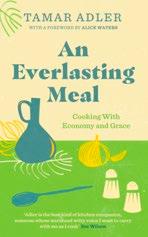
Although there were multiple Valentines connected to February 14, the most famous was a third-century martyr executed for secretly marrying Christian couples
Pope Gelasius I created a day for Saint Valentine around the end of the fifth century, but there is no indication of Valentine's Day celebrations of love until the 14th century
In 18th-century England, Valentine's Day grew into an occasion on which couples exchanged flowers, confectionary and cards known as "Valentines"
FEBRUARY 2023 • 133 READER’S DIGEST

THE WHALE
Brendan Fraser is enjoying the mother of all comebacks. The genial actor was huge in the early 2000s, with his easygoing charm making him an appealing presence in films like The Mummy and Blast from the Past. Then Hollywood forgot him. Until now. In Darren Aronofsky’s The Whale, he plays Charlie, an obese, reclusive literature tutor confined to his apartment by an excessive weight problem that has got so bad, he has just days left to live. His only real friend is Liz (a spiky Hong Chau), who cares deeply about him. But aside from being bothered by a troubled missionary (Ty Simpkins) at the door, all he wants to do is make up with his estranged daughter Ellie (Stranger Things’ Sadie Sink), the casualty in his ruined marriage to exwife Mary (Samantha Morton).
Adapted from Samuel D Hunter’s play, The Whale deftly pivots between high-art (never has Herman Melville’s Moby Dick been used so poignantly) and sickening lows. It’s a red-raw story of redemption, one where Fraser leaves every ounce of himself on screen in what is surely an Oscar-worthy turn. Encased in swathes of prosthetics, he’s almost unrecognisable as a man who abuses his body with venom. Some might balk at this—particularly a binge-eating scene that is every bit as visceral as the drug-taking in Aronofsky’s earlier addiction tale Requiem for a Dream. But the film has a good heart, working its way towards a transcendent finale. It makes you feel desperately for Charlie and his need to reconnect before it’s too late.
The Whale is in cinemas on February 3
READERSDIGEST.CO.UK/CULTURE 134 • FEBRUARY 2023
FILMOFTHE
H H H H
MONTH
ALSO OUT THIS MONTH
H H H
WOMEN TALKING
Afilm born out of the #MeToo era, Sarah Polley’s Women Talking is a sensitively told tale of defiance in the face of abuse. It comes from the 2018 novel by Miriam Toews, which loosely recounted true-life horrors that took place in an insular Mennonite community in Bolivia. In the 2000s, women in this ultra-religious collective were being drugged and raped by the men folk, ultimately leading to arrests and imprisonment. In Polley’s film, the crimes are only hinted at, thankfully, with glimpses of blood-stained sheets. The men have been led away, but will be back soon, out on bail. The women must decide: do they take their children and flee, simply do nothing, or stay and confront this horrifying misogyny head on? Largely set in a hayloft, where they gather to collect their thoughts, it could be almost anywhere, any time, such is the nature of their surroundings.
Among the outspoken leaders of the pack are The Crown’s Claire Foy, Jessie Buckley, and Rooney Mara, whose character Ona is pregnant from one of the rapes. Frances McDormand, in a cameo, and Ben Whishaw, as a gentle
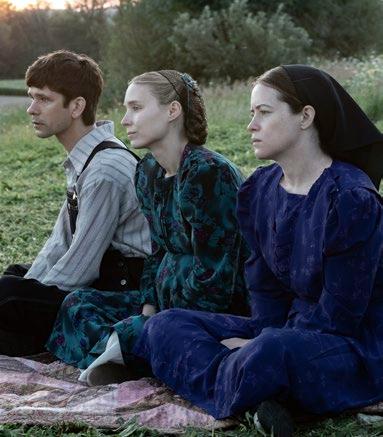
teacher and ally to the group, also feature. Collectively, it’s a powerful ensemble, already one of the year’s best casts.
As the title suggests, the film is dialogue-heavy, as characters debate and argue. If this means it sometimes feels dramatically inert—you don’t always feel the clock ticking—it’s a cerebral approach to a heavyweight subject. Guaranteed, it’s a film that’ll get you talking as soon as you leave the cinema.
WomenTalkingisincinemasonFebruary10
By James Mottram
FILM
FEBRUARY 2023 • 135
There was a late, notable addition to last month’s column about TV looking East. For the new, one-off special of his illustrious Netflix chat show My Next Guest…, David Letterman travelled to Kyiv back in August—as Russian troops were retreating—to meet the Ukrainian president Volodymyr Zelenskyy. The result is an interview like few others. For starters, security reasons required it to be held in a functioning metro station, with trains clanking by every few minutes, and air raid sirens interrupting the flow of anecdotes. It’s a more tentative interface than previous editions—reliant upon translation and earpieces—but one that yields fascinating detail on Ukraine’s fight, its leader’s origins in stand-up comedy, and his daily routines: “I’m glad you shower,” chuckles Letterman. Humour gets retooled as a weapon, to combat the horrors of the wartime task, and the fundamental mirthlessness of an oppressor.
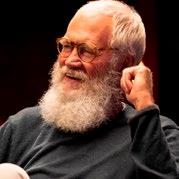
Back on the (country and) Western front, George & Tammy constitutes the best reason yet to subscribe to—or trial— the new streaming platform Paramount+. This superior six-part miniseries describes the turbulent on-off romance between rhinestone legends George Jones and Tammy Wynette, with a degree of dramatic licence, if the reports are to be believed. Nevertheless, Michael Shannon and Jessica Chastain, two of the most thoughtful actors of their generation, excel in the title roles, hitting every note of dependency; around them, writer Abe Sylvia and director John Hillcoat—the Australian known for his brooding collaborations with Nick Cave on The Proposition and The Road recentre the songs to spellbinding, heartbreaking effect. Knowing this story, you’ll not hear “D.I.V.O.R.C.E” and “Stand by Your Man” in quite the same way again.
by Mike McCahill

Retro Pick:
CountryMusic:AFilmbyKenBurns (PrimeVideo)
George and Tammy and Willie and Johnny and Dolly: an entire musical heritage, laid out over eight parts by master historian Burns.
TELEVISION
136 • FEBRUARY 2023
Album Of The Month: HeavyHeavy
by Young Fathers
Young Fathers

plunge into their new album with all the momentum of a stretched elastic band that has finally snapped. Five years is the longest we’ve gone without a release (we’ve not heard a peep since 2018’s Cocoa Sugar), and that break has been restorative, giving the band’s kinetic, barely restrained pandemonium a fresh kick.
Young Fathers reportedly holed themselves up in one studio with all their instruments to facilitate new levels of spontaneity. Banging, twanging and scraping whatever was within reach was the order of the day, which comes through in the exhilarating “Drum” (driven by rapid metallic chords and trademark vocal harmonies) and the swirling mass of hand claps and piano keys on “Sink or Swim”.
But it’s not all fast and furious. “Tell Somebody” is an ever-expanding orchestral swell, where a falsetto refrain, strings and an organ—no less— carry its listeners aloft. On “Geronimo”, from the opening whisper (“Sometimes bad guys don’t need to lie”) to the battle cry motif, “Get up”, Young Fathers show themselves to be masters of the emotive, climbing climax.
Heavy Heavy is a mood, according to the band, which speaks to their own personal journey of growing up and new fatherhood, as well as the long shadow that the empire casts over Britain today. More than anything, this record feels like an invitation for catharsis, with Young Fathers at the pinnacle of a sound that is entirely theirs— dynamic, electric, pulsating and totally joyous.
By Becca Inglis
RD’s favourite love songs
1. Joe Simon—My Adorable One Heartfelt soul that expresses the beautiful simplicity of finally calling that favourite person yours.
2. Tom Waits—Martha
The best love songs are the sad ones, and this short tale about an elderly man calling his old flame 40 years after they last spoke is hard to beat.
3.Foo Fighters— Everlong
An anthem that captures the excitement and energy of new love, this is a wedding favourite for rock fans for a reason.
4. The Monkees—Me & Magdalena
A slow acoustic song with a lovely piano accompaniment and heartfelt lyrics. It’s not necessarily a sad love song, but it might make your heart ache a little nonetheless.
MUSIC 121 FEBRUARY 2023 • 137
February Fiction
History and magical realism are woven together in Salman Rushdie’s wild new novel
VictoryCity
by Salman Rushdie Jonathan Cape, £22
If there was a competition for the best pastiche of the opening words of a Salman Rushdie novel, a pretty good entry might be: “On the last day of her life, when she was 247 years old, the blind poet, miracle worker and prophetess Pampa Kampana completed her immense narrative poem about Bisnaga”. By coincidence, these are also the opening words of Victory City, a book Rushdie finished shortly before last summer’s tragic stabbing. From there, he goes on to retell the events laid out in Pampa’s poem—and to prove all over again that nobody else

James Walton is a book reviewer and broadcaster, and has written and presented 17 series of the BBC Radio 4 literary quiz The Write Stuff

writes novels quite like this, where history and magical realism are perfectly intertwined.
Bisnaga, for example, was a real Indian city that between the 14th and 16th centuries became one of the grandest in the world. On the other hand, it seems a safe bet that it didn’t come into existence, as it does here, when a goddess-inspired prophetess told two cowherds to scatter seeds on the ground. Or that once these instantly grew into an urban wonder, she whispered to the newly fledged inhabitants the stories of their lives and families and of the city’s past.
Either way, soon afterwards, one of the cowherds crowns himself king and Bisnaga’s cycle of greatness and decline
BOOKS
138 • FEBRUARY 2023
begins. Among much else, Rushdie gives us talking monkeys, people transformed into birds and Pampa’s own ability to live for centuries without much ageing. But we also get plenty of recognisable politics as the city flourishes when at its most tolerant and falls apart whenever a ruler decides that religion means only that “we are good, they are bad.” Meanwhile, for all the strangeness of the magic bits, Rushdie is as impressive as ever at such traditional literary satisfactions as beautiful pacing and vivid, unforgettable characters.
I appreciate that his work is not to everybody’s taste (you could, for instance, certainly make a strong case that Victory City is completely bonkers). Yet, for those of us who are fans, this is the man at his full-strength, high-tar best—with his deeply humane worldview, his brilliance at set-pieces and, above all, the thrilling wildness of his imagination on irresistible display. n
Name the character
Can you guess the fictional character from these clues (and, of course, the fewer you need the better)?
1. When we first meet him he’s in love with Rosaline.
2. The words “Parting is such sweet sorrow” are spoken to him.
3. His surname is Montague.
Answer on p142
Paperbacks
TheNo-Show by Beth O’Leary (Quercus, £8.99). Cracking rom-com about three women who turn out to be waiting for the same man on Valentine’s Day.
TheGiftofaRadio by Justin Webb (Penguin, £10.99). The much-loved radio presenter remembers his grisly 1970s childhood, and the discovery that his biological father was newsreader Peter Woods.
PianosandFlowers by Alexander McCall Smith (Polygon, £7.99). Old photos from the Times archive inspire McCall Smith to imagine the lives of the people in them, resulting in a warm-hearted set of short stories.
BattlewithRelics:AHistoryof Wales1962-1997 by Richard King (Faber, £12.99). Superb oral history of the country through a period of enormous social change.
LoveMarriage by Monica Ali (Virago, £9.99).
The author of Brick Lane with her first novel for ten years, about two very different families coming together for a wedding. Well worth the wait.

FEBRUARY 2023 • 139
RECOMMENDED READ:
A Life Less Ordinary
This month’s recommended read is a biography of a controversial but fascinating American author

Norman Mailer, it’s fair to say, isn’t as fashionable as he once was. For much of his life he was considered a towering figure of post-war American literature. By the end of it, though—and especially since his death in 2007—he’s more often been regarded as a regrettable macho relic, with his taste for booze, fighting and philandering his way through no less than six marriages.
Most notoriously, in November 1960, while optimistically standing for mayor of New York, he drunkenly stabbed his second wife, Adele, almost killing her. This, not surprisingly, ended his mayoral campaign—but such was Mailer’s ego that he continued to think of himself as an important political force, whose advice would surely be sought by President Kennedy.
But of course, while all this (and plenty more) might well make him worthy of disapproval,
it certainly doesn’t make him boring—as Richard Bradford’s new biography exhilaratingly and clearly proves.
Born in 1923, Mailer grew up in Jewish Brooklyn, entered Harvard at 16 and scored a huge bestseller with his first novel The Naked and the Dead (1948), based on his army experiences in the Second World War. From there he was soon launched into a level of literary superstardom that’s hard to imagine now—and into that unfailingly rackety adult life of his.
To be honest, Bradford’s book isn’t without flaws. For my money, it rather overdoes the moralistic fingerwagging—and seems unwilling to admit that Mailer ever wrote anything worth reading. There are also some factual errors, including a confusion between Republican and Democrat candidates in presidential elections. Fortunately, the story itself is so gripping (even jaw-dropping)
BOOKS
140 • FEBRUARY 2023
that it easily triumphs over such shortcomings. Take, for example, this typical passage…
“In mid-March 1961, when Mailer and Adele were still attempting to rebuild their marriage, they were invited to a party at Gore Vidal’s New York apartment. Adele was feeling unwell and Mailer went alone. He was talking with the lawyer and politician Jacob Javits and his wife, Marion, who introduced him to a woman standing nearby, Jeanne Campbell, or as she added wryly, ‘Lady Jeanne Campbell’. He knew nothing of her past, but as they talked she disclosed a background that fascinated him. They then had sex in one of Vidal’s spare bedrooms.
Jeanne’s maternal grandfather was Lord Beaverbrook, the millionaire newspaper proprietor, and her father was the 11th Duke of Argyll. Marital problems of various sorts resulted in her being raised mainly by Beaverbrook, who sent her to the
ToughGuy:The LifeofNorman
Mailer by Richard Bradford is published by Bloomsbury at £20

best boarding schools and thereafter allowed her to live in whatever way she wished, with generous provisions of money. She boasted of having had affairs with John F Kennedy, Randolph Churchill (Winston’s son; she had, she confessed, set her sights on Churchill himself, but age was a problem), Ian Fleming, Nikita Khrushchev, Fidel Castro and Oswald Mosley. She was honest in her pursuit of sexual diversity, political and otherwise; when Vidal asked her later, once she and Mailer had become a couple, why she’d become involved with him, she answered, ‘Because I never slept with a Jew before.’
We do not know who informed Adele of the liaison, but the fact that Mailer had tried to keep it secret confirmed her suspicion that he was still the unfaithful figure she had barely managed to tolerate before he tried to kill her.
Mailer and Jeanne were married in April 1962, following her discovery that she was pregnant. The marriage lasted only 18 months and the relationship as a whole just over two years. This was habitual. He was a serial fornicator. Commonly one relationship would begin sometime before the previous marriage had ended. Jeanne replaced Adele in much the same way that the latter took over from Bea. There were always overlaps, but what would not change was the perverse singularity
READER’S DIGEST
FEBRUARY 2023 • 141
of Norman Mailer. One might have expected that he would decrease the obsessions that preceded the attack on Adele, but quite the opposite occurred. He became even more bizarre.
Barely a month after meeting Jeanne, he published an open letter to Kennedy, addressing him as ‘Dear Jack’ and reprimanding him for the recent failed attempt by exiles to invade Cuba. The Bay of Pigs was a disaster, but Mailer was unconcerned with military tactics; rather he held ‘Jack’ to account for following the advice of the CIA when his old friend Norman Mailer would have provided more judicious counsel. He reminded the president of the piece he’d written in November 1960 when he assumed that his mayoral campaign would earn him an advisory role at the White House, and he reiterated his point that Kennedy and Castro would be able to find common ground with the assistance of Norman Mailer.
”Answer
to Name the Character:
Romeo from Shakespeare’s Romeo and Juliet, the most filmed play in film history. Onscreen Romeos have included Leonardo DiCaprio and Leslie Howard.

Five Great Biographies Of Writers
AgathaChristie:AVeryElusive Woman by Lucy Worsley. A chatty but always thoughtful account of Christie’s life that also makes a strong case for her as a seriously good writer.
Shakespeare by Bill Bryson. Bryson brings his usual wittiness to bear on all that we know about Shakespeare—and all that we don’t.
Pepys:TheUnequalledSelf by Claire Tomalin. Tomalin’s biographies of Austen, Dickens and Hardy are terrific too but this might well be her best, bringing Pepys to life in all his human loveability.
TheSilentWoman:SylviaPlath andTedHughes by Janet Malcolm. Not just a joint biography, but an exploration of other biographies, as Malcolm strips away the myths surrounding perhaps the most famous and tragic of 20th-century literary marriages.
NancyMitfordby Selina Hastings. Lots of upper-class jollity here, of course, but also a hefty dollop of the sadness that Mitford tried so hard to keep at bay with her commitment to fun.
BOOKS
142 • FEBRUARY 2023
Books
THAT CHANGED MY LIFE
Patrick Gale is the author of Emmy awardwinning drama, Man In An Orange Shirt novel, Mother’s Boy, is available now, £20, published by Tinder Press

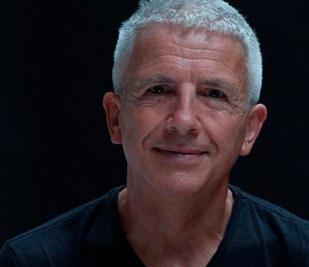
Complete Works: Oscar Wilde
This was a mysterious dark green hardback I discovered, aged seven, tucked away unregarded on the shelves behind my parents’ sofa. I was utterly obsessed, initially by the lurid illustrations of scenes like Salome kissing the head of John the Baptist or Dorian stabbing his repellent portrait, and then by Wilde’s bittersweet short stories, surely only nominally for children. It was the first book that I felt recognised me, and in some way I knew I couldn’t possibly share with grown-ups.

The Bell: Iris Murdoch
I read this extraordinary novel after meeting Dame
Iris as a student, and then devoured every novel of hers until I was up to date. It acknowledged the validity of love between men without fanfare but simply as part of its compassionate survey of human behaviours and misbehaviours. There are novels of hers I came to prefer, like The Good Apprentice, but I’ve never forgotten the life-changing thrill of The Bell or stopped being grateful to Murdoch for helping me through my wild grief when my brother was killed and inspiring me to abandon ambitions to act and devote myself to writing instead.
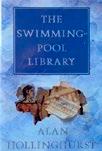

The Swimming Pool Library: Alan Hollinghurst
I was living in a bedsit working as a typist and all around me friends and acquaintances were sick with HIV/AIDS or terrified of becoming so. The government was actively hostile to gay people and it felt as though my family and straight friends lived in an entirely separate version of reality. Alan’s novel arrived like the elegant words of a savage prophet. I did not like its heartless hero but his shamelessness, and the story’s timely reminder that ours was not the first generation to feel so beleaguered, was deeply inspiring.
FOR MORE, GO TO READERSDIGEST.CO.UK/CULTURE
FEBRUARY 2023 • 143
Forgetting your login details will soon be a thing of the past, writes James O'Malley
Passwords Are So Passé
One of my favourite inventions in recent years is face unlocking. Without needing to remember a pin code, or arduously lift my fingers and type in the numbers, I can get straight into my phone with just a glance. And if anyone else picks it up and tries to meddle, they’ll be locked out.
It’s a really brilliant way of reducing the "friction" that comes with digital security. It means that my phone can remain safe and locked down when not in use, but without an annoying extra step to carry out during the approximately ten thousand times per day I pick up my phone.
But given this technology is so useful, the obvious question to ask is: what about everything else? Why do we still have to laboriously type in passwords when we log into almost every other website or app? Surely there’s a better way?
Well, I’m very happy to report that there is good news on the horizon. Over the next few years, we can expect logins to get much
less annoying, as all of the major tech players are now on board with a new technology designed to eventually replace the humble password called the “passkey”. And that could mean that we do away with passwords altogether.
The way passkeys work is by turning your phone into something a bit like a wallet, which you can use to store membership cards to all of your apps and services. When you need to log in to a website, you’ll just have to tap a button on your phone and your passkey wallet will flash the right credentials, letting you in without any fuss.
And even if you’re logging in to a device that doesn’t have access to your wallet, when you type in your email address, the website will send a message to your phone to check your credentials. And how does it keep this virtual wallet safe? By using the same "biometric" check your phone uses—a face scan or a fingerprint that cannot easily be forged.
Once passkeys are the norm, they won’t just save us from having to remember passwords but, perhaps
144 • FEBRUARY 2023
TECHNOLOGY
counterintuitively, logging in with a passkey will actually be significantly more secure than typing a password. This is because it takes advantage of a technology called “public key” cryptography, which is one of the building blocks of the internet—and is how computers have securely communicated with other computers for decades.

THE WEBSITE WILL KEEP THE PADLOCK—AND YOUR
PHONE WILL HAVE THE KEY
The way it works is by doing some very clever maths. Simply put, it works a bit like, well, a key, instead of a password. With a password, the website has to ultimately contain a database of everyone’s passwords to check against when you login. But with a passkey, when you create your account on a website, it will effectively create a brand new padlock and key. The website will keep the padlock—and only your phone will have the key.
I think it’s a really clever idea, and that passkeys are going to make our digital lives even more secure, because they help guard against two common forms of digital attack.
First, it guards against data breaches—situations where hackers
gain access to a database of passwords. This is because, unlike most people who repeat their passwords, each passkey is unique (because we don’t have to worry about remembering them). This means that even if the pizza delivery place is hacked, it won't give away the same password that you use for your emails. And secondly, passkeys make things much harder for "phishing" scams— when a website tries to trick you into thinking that it is really your bank’s website or similar, so it can steal your login details. These scams will no longer work as well, because passkeys have another mathematical trick up their sleeve: they’re always changing. When you log in and your digital wallet has to send over an unlock code, the code it sends will only be valid for a few seconds at a time—so even if a hacker does gets hold of your key very briefly, 30 seconds later it will be rendered useless anyway.
So, next time you’re tutting in frustration that you can’t remember your password, don’t worry too much. It won’t always be like this! n
145
FEBRUARY 2023 •
Win £30 for your true, funny stories!
Go to readersdigest.co.uk/contact-us or facebook.com/readersdigestuk
Celebrating our 49th wedding anniversary with a hug, we had a photo taken.
My daughter was showing it to Max (aged six) and he asked, "Are they dating?".
"They are married," said his mum.
"When did they get married?" asked Max.
"A long time ago," said Mum.
"I don't remember," said Max. "Was I there?
PAT COURT, Oxfordshire
When my daughter started primary school, she made some new friends in her class and they soon started to go to each other’s houses for tea after school.
The other mums in this playdate circle were lovely. Exceptionally so. Every time I picked my daughter up from one of their homes, they made a point of saying what a delightful child she was, what a great job I was doing with her and how lucky she
You Couldn’t Make It Up 146 • FEBRUARY 2023
FUN & GAMES AND THE £50 GOES TO… LAUREN KROTOSKY, Hertfordshire £50 PRIZE QUESTION ANSWER TO JANUARY'S PRIZE QUESTION CHANGELINGS VOLLEYBALL GYMNASTICS PENTATHLON THE FIRST CORRECT ANSWER WE PICK WINS £50!* Email excerpts@readersdigest.co.uk THREE-IN-ONE
letters listed below only once, can you find the names of three constellations? a a a i j l m n o o o r r r r s u y
Using all of the
was to have me. It was nice of them to say so, I thought, but really a little over-the-top. I was just doing what mums do, wasn’t I?
Eventually I pointed this out to one of the mums. She patted me on the arm. "Yes, you’re doing exactly what her real mum would have wanted you to do."
Apparently my highly imaginative daughter had told all her friends that her family had been involved in a shipwreck, her parents had drowned and I had rescued her and agreed to adopt her.
I had to be honest and put the record straight, and we all saw the funny side. I must admit that I missed being treated like a hero in the school playground, however.
KAY STEAD, York
I interviewed a man for a job and asked him if he had any hobbies.
"Yes," he replied quite enthusiastically. "Women."
I looked him in the eye for a few seconds and there was a very uncomfortable silence until I moved on to another question.
Later, I found out that he had actually said, "Swimming."
ANDREW BERRY, Lincoln
I walked into a sports shop in search of a warm fleece.
On entry, I grabbed at the first one I saw and inspected the thickness with my hand.
cartoon by Guto Dias

"Do you mind?" came a voice out of nowhere. I looked up and found myself staring into a red-face of a male shop assistant.
"So sorry," I said," I thought you were a dummy."
LORRAINE SMITH,
Lancashire
"You can’t get multiple sclerosis from the cathedral," said a woman behind me in the café.
Well, that’s a relief, I thought, although I was not aware that it was contagious.
"But I got motor neurone disease," she continued.
I was sorry to hear that, but her friend was more upbeat. "That’s good, dear," she said.
As I stood up to leave, I glanced behind me at the packs of charity Christmas cards spread on the table.
GLENYS ADAMS, Liverpool
FEBRUARY 2023 • 147
TRIVIA
By Beth Shillibeer
1. Why are plant species Lamprocapnos spectabilis and Hoya kerri especially popular in February?
2. What was Austria’s Reisi, built in 2020 to be the tallest of his kind?
3. The first ever YouTube video, posted in 2005, featured what animal at the San Diego Zoo?
4. When stores in Japan play the song “Hotaru no Hikari,” known in Europe as “Auld Lang Syne,” what does it signify?
5. Due to wartime metal shortages, Academy Award winners from 1943 to 1945 were given temporary Oscars made of what?
6. Sweet frittelle and galani are pastries traditionally eaten during what festival in Venice?
7. What kind of nut can spontaneously combust, making it dangerous cargo on ships?
8. If you were at Point Nemo in the Pacific Ocean, where would you find your nearest human neighbours?
9. How many time zones does New Zealand have during the summer?
10. The 1,200-kilometre Finnmarksløpet, held every year in Norway, is Europe’s longest distance race in what sport?
11. Which English author is credited with linking St Valentine’s Day to love and romance in his 14th-century poem “Parliament of Fowls”?

12. Adolescent mammals share what feature that causes them to fall asleep and wake up later than adult populations?
13. Eris, Makemake and Haumea are what kinds of objects in our solar system?
15. The toquilla straw hat, known as the Panama hat, is made using a weaving technique from which country?
14. What language has the most letters in its alphabet?
12. Temporary circadian-cycle changes in the brain. 13. Dwarf planets. 14. Khmer (Cambodian), with 74 letters. 15. Ecuador.
9. Three. New Zealand, Chatham Islands and Tokelau. 10. Dogsledding. 11. Geoffrey Chaucer.
Answers: 1. They have heart-shaped flowers or leaves. 2. A snowman. 3. Elephants. 4. Closing time. 5. Painted plaster. 6. Carnival. 7. The pistachio nut. 8. At the International Space Station.
148 • FEBRUARY 2023
Word Power
“We shape our tools,” wrote media theorist Marshall McLuhan, “and then our tools shape us.” This month we highlight some indispensable devices and celebrate the ways in which they’ve shaped our language
BY ROB LUTES
1. averruncator—A: manual posthole digger. B: instrument for pruning trees. C: press for crushing grapes.
2. chamois—A: cloth to strain whey in cheese making. B: cast-iron frying pan. C: porous leather used for polishing.
3. cauf—A: large box with holes for keeping fish alive in water. B: trowel for smoothing concrete. C: curved knife for gutting fish.
4. punch—A: heated press for bookbinding. B: rod for driving nails below a surface. C: rotary tool to cut round holes in walls.
5. maul—A: mallet used to strike a gong. B: wedge-shaped hammer. C: small screwdriver.
6. square—A: device for testing right angles. B: fastener in house-frame construction. C: box for brick moulding.
7. douter—A: candle snuffer. B: device that creates texture in plaster finishes. C: needle for stitching leather.
8. hawser—A: handsaw. B: catapult used to feed farm animals. C: rope used to moor or tow a boat.
9. plench—A: tool combining pliers and a wrench. B: chisel to cut grooves. C: shovel for trench digging.
10. burin—A: hand-operated coffee grinder. B: camping stove. C: pointed tool for engraving.
11. trowel—A: flat-bladed hand tool. B: tripod used in land surveying. C: hook on which to hang fowl before cooking.
12. tamis—A: wire brush for cleaning rifles. B: drum-shaped mesh strainer. C: vice for bending wood.
13. rasp—A: excavation tool. B: peeler to remove orange skin. C: large-toothed file.
14. calliper—A: device to hold boards during milling. B: machine for sheep grooming. C: instrument for measuring thickness or width.
15. shears—A: fittings used to regulate water flow. B: cutting tool. C: riding whip with braided lash.
FEBRUARY 2023 • 149 FUN AND GAMES
IT PAYS TO INCREASE YOUR
Answers
1. averruncator—[B] instrument for pruning trees; The arborist used an averruncator to cut the dogwood branches brushing the shed roof.
2. chamois—[C] porous leather used for polishing; Ashok used the chamois to buff his red car to a streakless shine.
3. cauf —[A] large box with holes for keeping fish alive in water; His cauf full of live carp for bait, Urban felt confident he would catch the catfish he was after.
4. punch—[B] rod for driving nails below a surface; After hammering together the shelves, Giles used a punch to hide the flatheads.
5. maul—[B] wedge-shaped hammer; Aim the blade of your maul in the same direction as any hairline cracks in the log.
6. square —[A] device for testing right angles; According to the square, the corners of the shed were at precisely 90 degrees.
7. douter—[A] candle snuffer; When the power came on, the kids fought over who would use a brass douter to extinguish the candles.
8. hawser—[C] rope used to moor or tow a boat; The hawser held firmly as we hauled the freighter into Boston Harbour.
9. plench—[A] tool combining pliers and a wrench; Knowing she needed to remove several tricky fasteners, the astronaut took a plench with her on her spacewalk.
10. burin—[C] pointed tool for engraving; Pam’s hands cramped up after hours of using the burin to carve her name on a copper sheet.
11. trowel—[A] flat-bladed hand tool; Ciprian drove the trowel into the soil and levered it back and forth to create a slot for the bulb.
12. tamis—[B] drum-shaped mesh strainer; Sandro sifted the almond flour with a tamis.
13. rasp—[C] large-toothed file; Vassili shaped the cabinet’s contours with a rasp, then sanded them to a fine finish.
14. calliper—[C] instrument for measuring thickness or width; Not having faith in the inspector’s report, Eleanor checked the diameter of pipes with her calliper.
15. shears—[B] cutting tool; Clint rinsed his herbs, then used the shears to chop them into bits right into the recipe.
VOCABULARY RATINGS
7–10: fair 11–12: good 13–15: excellent
WORD POWER
150 • FEBRUARY 2023
Reader’s Digest Competitions
–
Enter today for your chance to win!
Photo
Finder

You will find this photograph somewhere inside this issue of the Reader’s Digest magazine, but can you find it? Once you have, simply write the page number on your entry form, or enter online.
Competitions – How to enter
Enter By Post Or Online – February 2023 closing date for entries: 13 February 2023
Online: readersdigest.co.uk/magazine-competitions
By Post:
Complete the entry form and send via post to Reader’s Digest Competitions, Warners Group Publications, West Street, Bourne, PE10 9PH
COMPETITION ENTRY RULES
Competitions are open to residents of the UK, Eire and BFPOs, aged 18 or over, except Reader’s Digest employees and any associated partners or affiliated companies. No purchase necessary. Entries can be made via post or online. There is no cash alternative and prizes are not transferable. Only one entry per person. Winning entries will be chosen at random and winners will be notified by email or post. Winners must agree to publication of their name, age and photo. Your information will only be used in accordance with our privacy policy. Entry implies acceptance of these rules. Full terms can be viewed online at readersdigest.co.uk/ competition-rules.
Fill in all your answers below: February 2023 Entry Form
(enter as many as you like – one entry per competition per person)
Page 88 Ragdale Hall Break
Page 89 Winter Wordwheel
Page 112 Macdonald Hotel & Resorts Break
Page 128 Chester House Break
Page 129 Prize Crossword
Page 151 Photo Finder
Name:
Address:
Postcode:
Telephone:
Email:
n * I opt-in to receive the reader’s digest email newsletter for offers and competitions
n * I opt-in to be contacted by third party competition promoters about future offers and promotions (*please tick)
COMPETITIONS
WIN! 3 X £50
BRAINTEASERS
Race to the Top
MediuM Two parent-child pairs are at the climbing wall in their gym at the same time, though they aren’t all from the same family. They are four different ages and have a race to see who can get to the top fastest. From these clues, can you rank all four people by age, height and speed?
1. If these four people stand in order of height, the fastest person is not at either end.
2. Olivia, being only eight, is both the youngest and the shortest person, but she’s not the slowest.
3. Andre is faster at climbing the wall than his father, Michael.
4. Sunita teased Andre that his extra height was the only reason he beat her to the top of the wall.
5. The oldest climber said that it would have been embarrassing to be beaten by Olivia.
6. None of the three orderings (oldest to youngest, tallest to shortest, fastest to slowest) are the same.
7. Sunita said that she hopes she’s as active as Michael when she’s his age.
Poppies
easy There are two kinds of poppies in the diagram, turned 45 degrees from each other. Can you find the poppy that’s exactly halfway between two poppies with horizontal and vertical petals, and is also exactly halfway between two poppies with diagonal petals?
152 • FEBRUARY 2023 FUN & GAMES
to the t op
RR en Rigby). p oppies
Race
(Da
(Da RR en Rigby)
Number Maze
MediuM In this maze, start at the 2 in the top-left corner and move horizontally or vertically (but never diagonally) to reach the star in the bottom-right corner. At each move, travel the same number of squares as the number in the cell you are currently on. Since you are starting on a cell containing 2, your next move is either two squares to the right or two squares down. The next move will be based on your new cell’s number. Can you find the correct path?
Cover Up
easy Which one of these four tiles could not be used to cover a floor if you had an infinite supply of them? Flipping them over is allowed.
For answers, turn to page 155.
FEBRUARY 2023 • 153 2 5 3 3 3 1 4 2 4 4 4 5 5 2 4 4 2 1 2 1 3
4
5
3
1
3
2
2 2 4 4 2 3 5 4 H
n umbe R m aze (F R ase R s impson). c ove R u p (D a RR en R igby )
1 Sculptures rising from a flat base (7)
Pull through (7) 9 Peeping Tom (6) 10 Enduring (4-4) 11 Never use ill-gotten earnings (8) 12 Spoke-like (6)
13 Home of Cox’s Bazar beach (10)
Arrest (4)
16 Eye problem (4)
18 Some of them are Grimm (5,5) 21 Shaft key (6)
22 Chosen as a career (4,4) 24 Learnt of a mess in Derbyshire (8) 25 Tooth covering (6) 26 “Salome” composer (7)
Guided (7)
Wear away (5)
Polar wrecker (7)
Established form of words (7)
York, from London (2,5)
Picked democratically (5,2)
Adaptable (9)
Eavesdropping (9,2)
Thoughtless state (9)
African state on the Red Sea (7)
Elaborate Hispanic parties (7)
New York baseball team (7)
Energise (7)
“___Boots Are Made For Walking (5)”
knowledge.
ACROSS
CROSSWISE Test your general
Answers on p158
5
15
DOWN 2
3
4
6
7
8
10
20
27
14
17
18
19
23
BRAINTEASERS ANSWERS
See page 152-153.
Race to the Top
From oldest to youngest, they are Michael, Sunita, Andre, and Olivia; from tallest to shortest, they are Michael, Andre, Sunita, and Olivia; and from fastest to slowest, they are Andre, Michael, Olivia, and Sunita.
Poppies
Number Maze
The correct sequence of moves is: down 2, right 5, left 1, down 2, left 2, up 3, down 4, right 3.
Cover Up
The purple “N” shape.
SUDOKU
By Jeff Widderich
To Solve This Puzzle
Put a number from 1 to 9 in each empty square so that: ✦ every horizontal row and vertical column contains all nine numbers (1-9) without repeating any of them;
✦ each of the outlined 3 x 3 boxes has all nine numbers, none repeated.
FEBRUARY 2023 • 155 READER’S DIGEST
5
1 4 2 4 4 4 5 5 2 4 4 2 1 2 1 3 1 4 3 5 2 3 2 2 4 4 2 3 5 4 H
3 9 7 5 6 1 4 5 5 9 6 8 2 9 4 5 6 2 4 5 3 4 8 7 2 8 4 6 5 2 3 1 9 7 9 5 3 1 6 7 2 8 4 7 1 2 9 8 4 6 5 3 5 7 1 3 9 2 4 6 8 6 3 4 8 7 5 9 2 1 2 9 8 6 4 1 3 7 5 3 6 5 2 1 8 7 4 9 1 2 7 4 5 9 8 3 6 4 8 9 7 3 6 5 1 2 SOLUTION
2
3 3 3
8
Laugh!
WIN £30 for every reader’s joke we publish!
Go to readersdigest.co.uk/contact-us or facebook.com/readersdigestuk
I asked my boss what he wanted me to do with this six-metre roll of bubble wrap. He said, “Just pop it in the corner.” It took me four bloody hours!
SCOTT COOPER, London
How do roofers celebrate getting some work? With drinks on the house! DAVID COULTHARD, Tyne and Wear
Three years ago my doctor told me I was going deaf. I haven’t heard from him since!
STUART COLLINSON
Why did the physics teacher break up with the biology teacher? There was no chemistry! LUKE RUSSELL, Leeds
Elton John got his pet rabbit a treadmill—it’s a little fit bunny!
MELANIE LODGE,
West Yorkshire
I went out last week to a pub with my friend Vincent van Gogh. I said, “Vincent, would you like a drink?”. And he said, “No thanks, I’ve got one ‘ere.”
ROBERT
PERRY
FUN & GAMES
A Right Old Laugh
From Renaissance scholars to court jesters, these are some of the oldest recorded gags from history’s jokesters
After he’s spent all his allowance, a useless student has to sell his books for money. The next time he writes to his father he says: “You can congratulate me as my books are already supporting me!”.
- From Philogelos, the oldest surviving collection of jokes, compiled in ancient Greece during the fourth century AD, probably by Philagrius and Hierocles
A moth ate words which seemed amazing to me, that a maggot could consume somebody’s poem, a burglar in the dark… The thief was

not at all smarter for swallowing these sentences.
- From The Exeter Book, a late tenthcentury collection of writings, most famous for its dozens of riddles including ones for which the answers are probably a bookcase and the Bible. The answer to this one is a bookworm
When the poet Dante was living in exile in Siena, he was in a church examining his soul and privately preoccupied about something. A man approached him and asked various silly questions. “OK, can you tell me which is the biggest animal?” replied Dante. “The elephant”, said the man. “Well elephant,” said Dante, “Leave me alone to consider things greater than your words and stop annoying me!”.
Poggio Bracciolini

- From the Facetiae by Italian scholar Poggio Bracciolini, the first printed joke book, which appeared in 1470
FEBRUARY 2023 • 157

Archibald Armstrong
A scholler that had married a young wife, and was still at his Booke, preferring his serious study before dalliance with her. At length, as shee was one day wantoning whilst he was reading; Sir, saith shee, I could wish that I had beene made a Booke, for then you would still be poring upon me, and I should never, night nor day, be out of your fingers. So would I (Sweetheart) answered he, so I might chuse what booke. When she demanded of him what booke he would wish her to be: Marry good wife (saith he) an Almanacke, for so I might have every year a new one.
- A Banquet of Jests was a popular joke book first published in 1630 and regularly reprinted with updates in the following centuries. It is somewhat dubiously attributed to Archibald Armstrong, a jester at the courts of James VI and Charles I
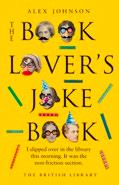
Extracted from The Book Lover’s Joke Book by Alex Johnson, published by British Library Publishing at £9.99
CROSSWORD ANSWERS
Why I Got Fired

Twitter users share the often-preposterous reasons they lost their jobs
@MisterDorngal58: … I got fired when the CEO overheard us calling him by his office nickname. Turns out “King Idiot” doesn’t have a great sense of humour.
@TheRealOlMusky: … My dad worked at a mattress store and one time he found his boss asleep on one of the mattresses. He ended up getting fired for waking him up.
@JakeWilliamsArt: … I worked at Starbucks and used to call out the names of drink orders in a robot voice. My boss was not a huge fan of it and eventually… [robot voice] I was terminated.
Across: 1 Reliefs, 5 Survive, 9 Voyeur, 10 Long-term, 11 Revenues, 12 Radial, 13 Bangladesh, 15 Nail, 16 Stye, 18 Fairy tales, 21 Spline, 22 Gone into, 24 Alfreton, 25 Enamel, 26 Strauss, 27 Ushered.
Down: 2 Erode, 3 Iceberg, 4 Formula, 6 Up North, 7 Voted in, 8 Versatile, 10 Listening in, 14 Autopilot, 17 Eritrea, 18 Fiestas, 19 Yankees, 20 Animate, 23 These.
LAUGH
,
Beat the Cartoonist!

Think of a witty caption for this cartoon—the three best suggestions, along with the cartoonist’s original, will be posted on our website in mid-FEBRUARY. If your entry gets the most votes, you’ll win £50. Submit to captions@readersdigest.co.uk by FEBRUARY 7. We’ll announce the winner in our April issue.
DECEMBER WINNER

Our cartoonist’s caption, “Blame the fuel crisis” failed to beat our reader Gwen Smithies this month, who won the vote with her caption, “I just can’t see a future without coal.” Congratulations, Gwen!
IN THE MARCH ISSUE

Hugh Jackman
The star of X-Men opens up about his life and his latest project, The Son

NOT ALL HEROES WEAR KITS
From F1 mechanics to anti-doping officials, we’re celebrating the unsung personalities of sport
The Labelling Epidemic
Is self-diagnosis becoming a problem?
READER’S DIGEST FEBRUARY 2023 • 159
cartoons by Royston Robertson
Bodleian Library in Oxford and rough drawings of figures

HUMANS HAVE BEEN DOODLING FOR AT LEAST 12 CENTURIES
Cast your mind back to your secondary school days and no doubt you have countless memories of doodling in your maths book when you were meant to be solving for x. Well, you weren’t the only one— researchers have recently discovered some doodles resembling cartoon people in a Latin copy of the Acts of the Apostles that was made in England between AD700 and AD750.
John Barrett and the ARCHiOx project team undertook imaging work at the Bodleian Library in Oxford. They used technology to capture the manuscript’s 3D surface, and in doing so discovered these doodles, as well

GOOD NEWS
from around the World
as secret scratchings of the Old English female name Eadburg.
According to The Guardian, the PhD student at the University of Leicester who made the discovery Jessica Hodgkinson said, “There are only a limited number of surviving early medieval manuscripts which contain clear internal evidence of a woman having created, owned or used them.”
It’s unclear who wrote the name or why, although it’s likely that it was Eadburg herself. Hodgkinson hopes to discover who Eadburg was, and what the doodled figures might mean.
This is not the only historical example of doodling. Dutch historian Erik Kwakkel has found many doodles in some of the world’s oldest books and manuscripts at Leiden University, the Netherlands, including 13thcentury law manuscripts and 19thcentury whaling logbooks. The scribbles include funny faces, animals and caricatures of teachers (some things never change).
So next time you find yourself doodling absent-mindedly in a Zoom call, just know that you are part of an ancient tradition!
by Alice GAwthrop
160 • FEBRUARY 2023
DIGESTED
TUNE INTO OUR PODCAST
Over the past year, Reader’s Digest has navigated the woes and wonders of modern life, weighing in with leading experts on the everyday tools we need to survive and thrive in the modern world. And what better time than now to catch up?
To subscribe to Digested and listen to all our episodes so far—including tips on sleep, the menopause and reducing your plastic consumption—visit readersdigest. co.uk/podcast or search “Digested” on iTunes.



SUBSCRIBE TODAY FREE

We promise we’ll never put down a healthy dog. Please promise to help us with a gif t in your Will. Every year, Dogs Trust cares for around 14,000 dogs in our 21 rehoming centres across the UK. We never put down a healthy dog. By leaving a gift in your Will, your love of dogs can live on and help us make the world a better place for them. For more information E: infopack@dogstrust.org.uk T: 020 7837 0006 Please quote “335423” , or complete the coupon below. Please send me my free legacy information pack (Please fill out in block capitals) Mr/Mrs/Miss/Ms/Other Address Postcode 335423 Registered charity numbers: 227523 & SC037843 A dog is for life® dogstrust.org.uk Please send this coupon to: FREEPOST DOGSTRUSTL (No stamp required) From time to time we would like to send you exciting updates about our work, products, services and how you can support us, including fundraising activities and research by post. If you’d rather not receive these mailings, please tick here In order to communicate with you more effectively, better understand your preferences and ability to support our work, we may analyse your data. We do share your information within the Dogs Trust Group; currently Dogs Trust Worldwide, Dogs Trust Ireland and Dogs Trust Promotions. To read our full privacy policy visit dogstrust.org.uk/privacy. © Dogs Trust 2023
































































































































































 by Brett Popplewell
photographs by kari medig
by Brett Popplewell
photographs by kari medig



















































































